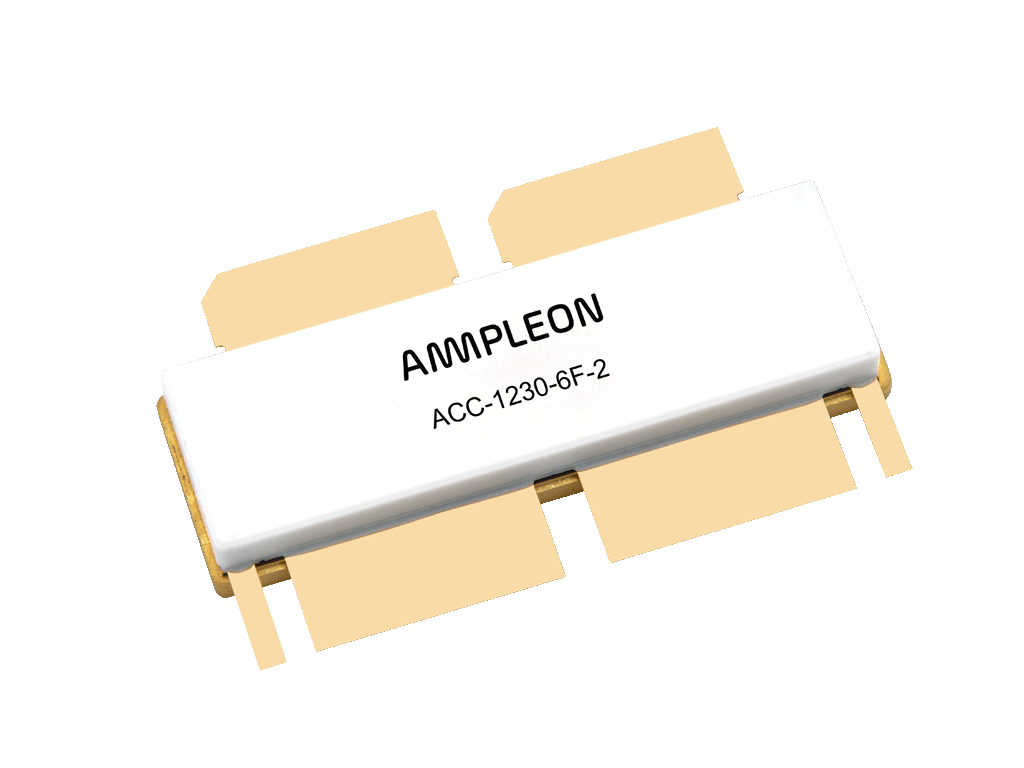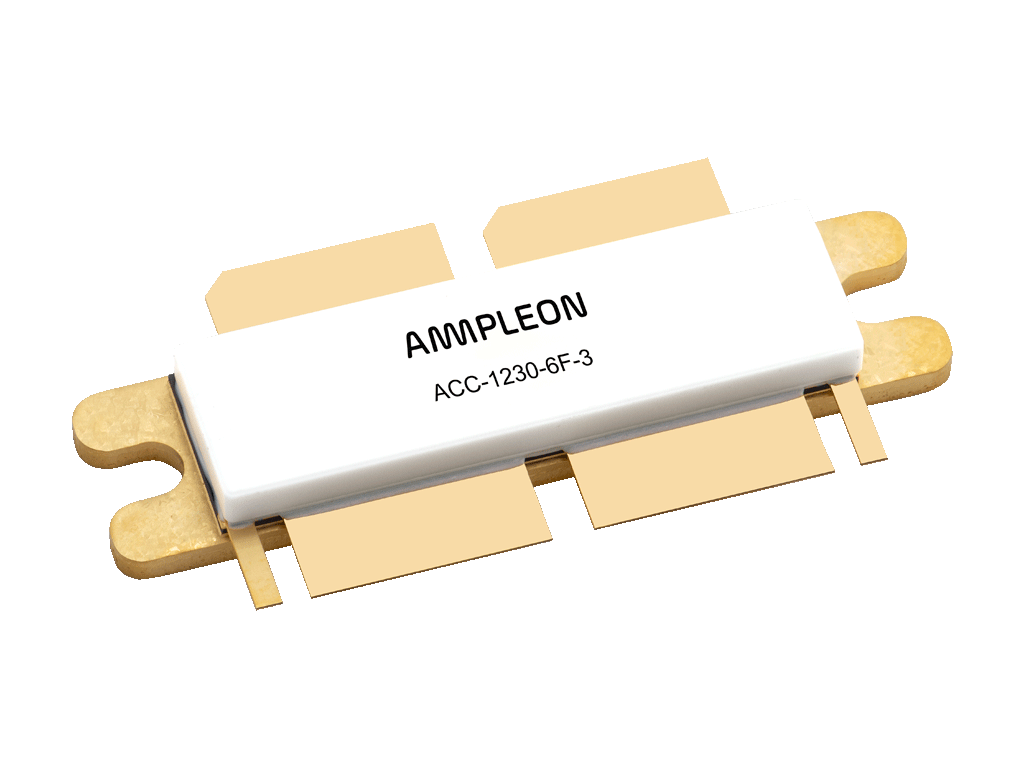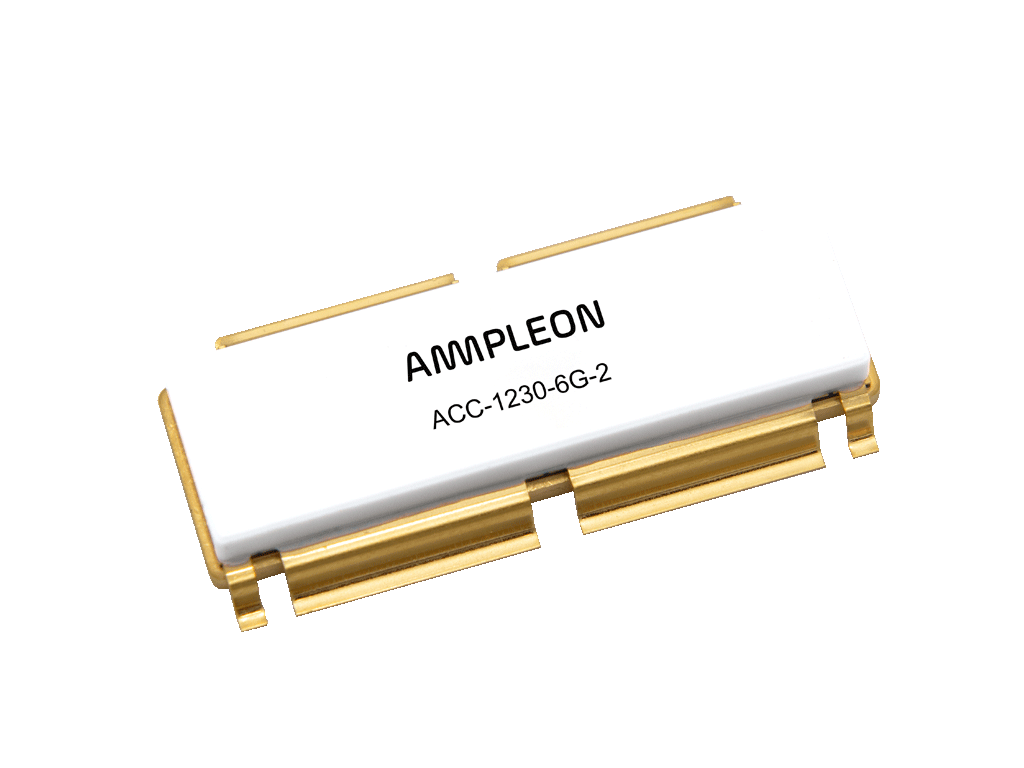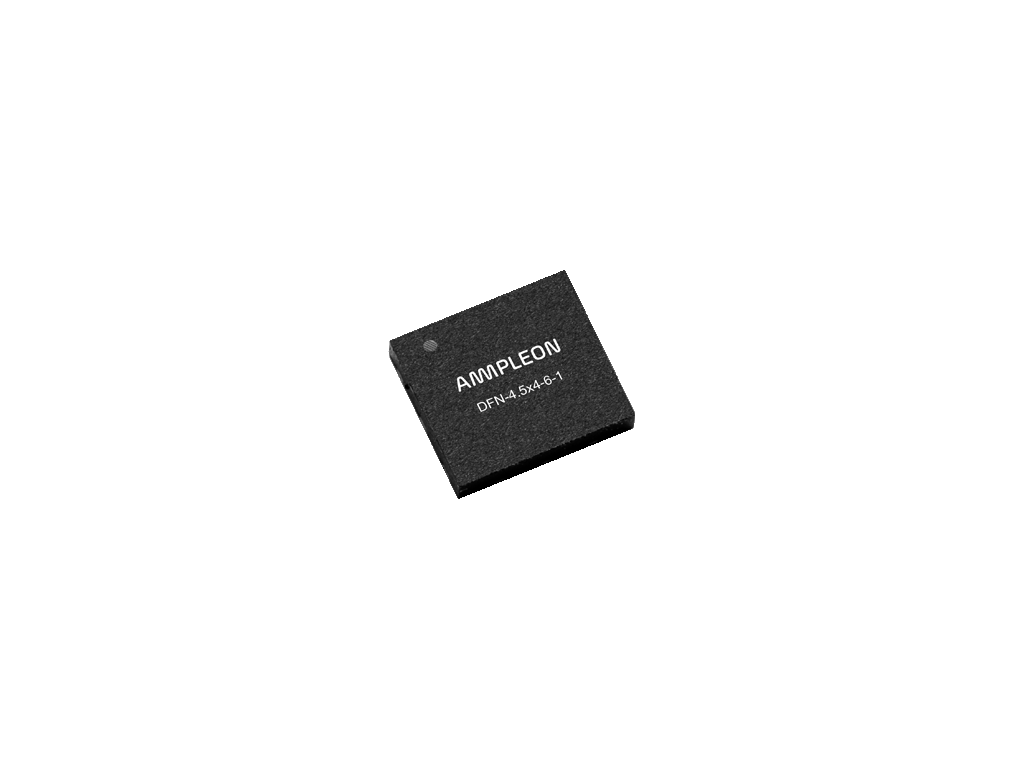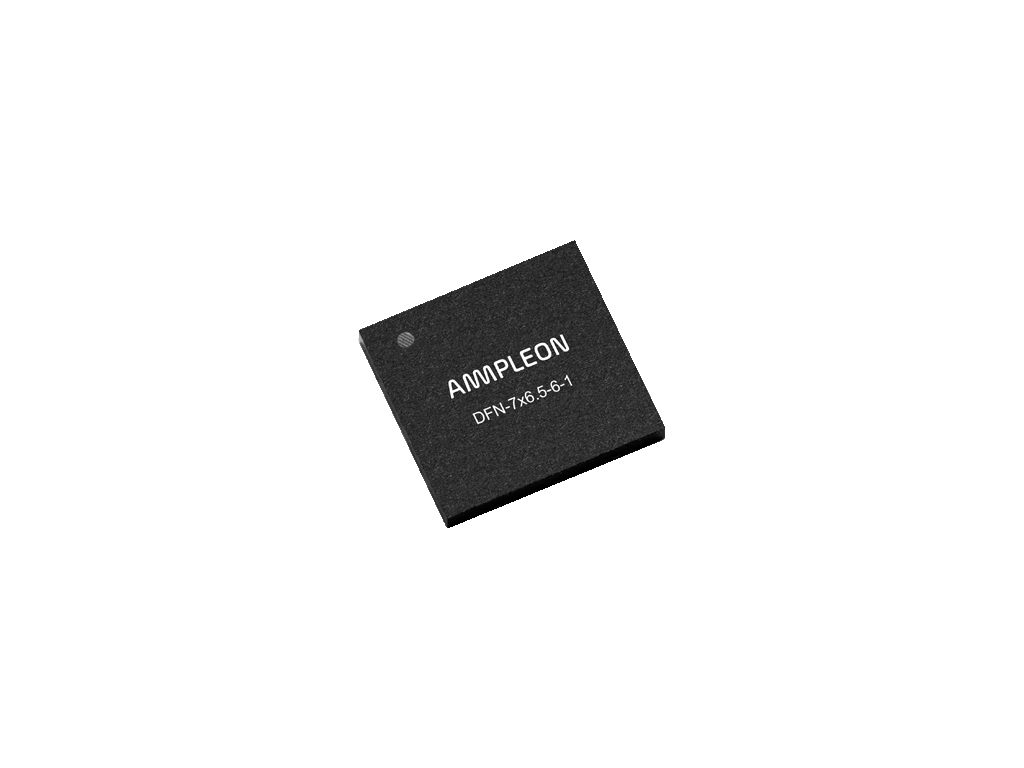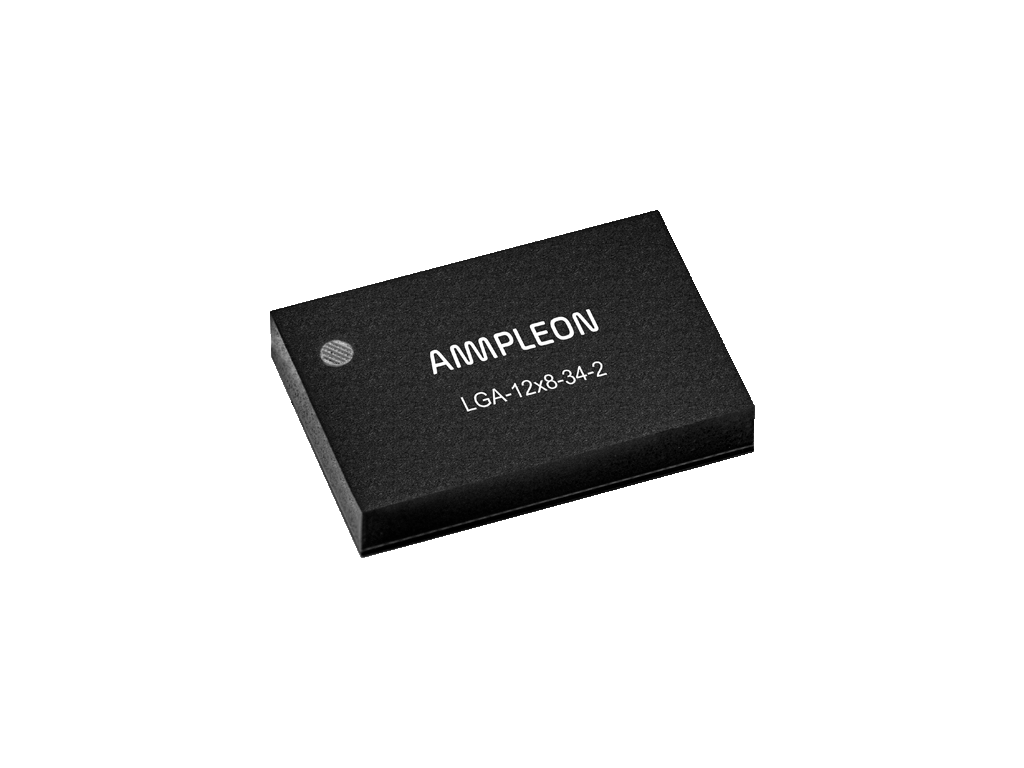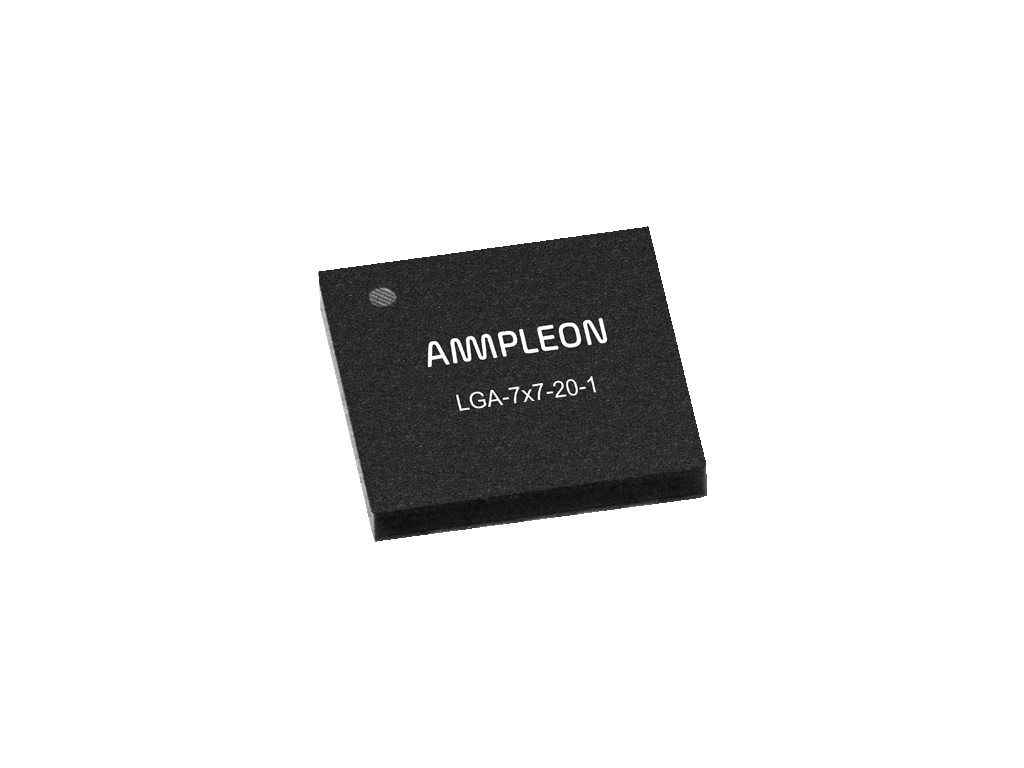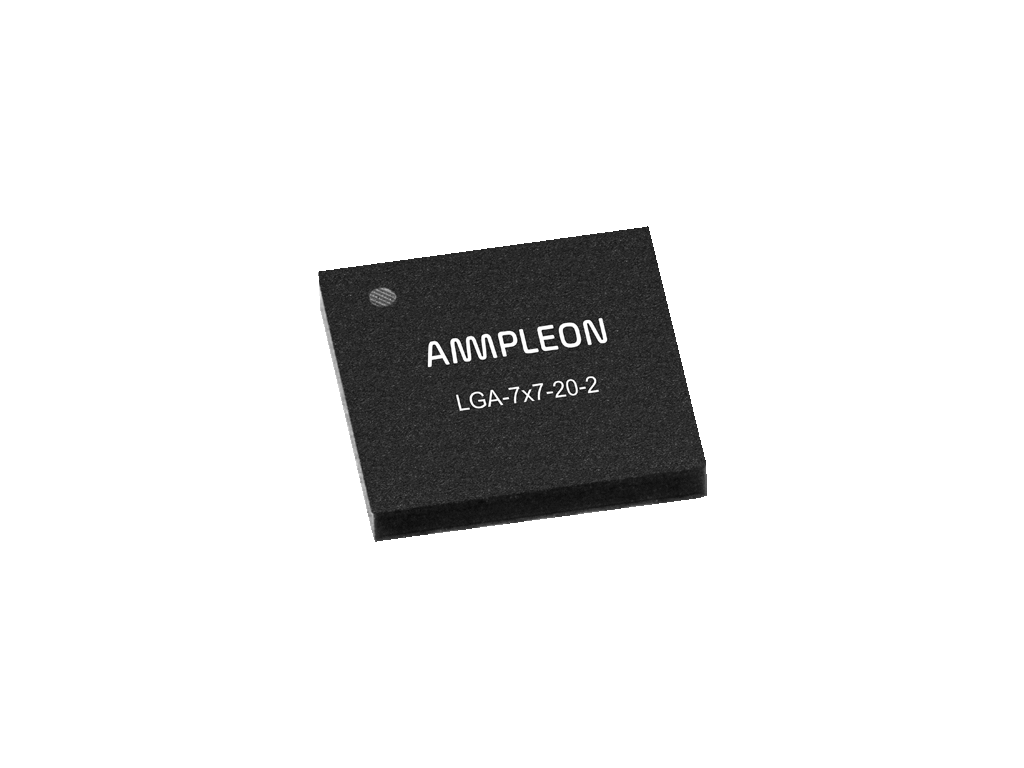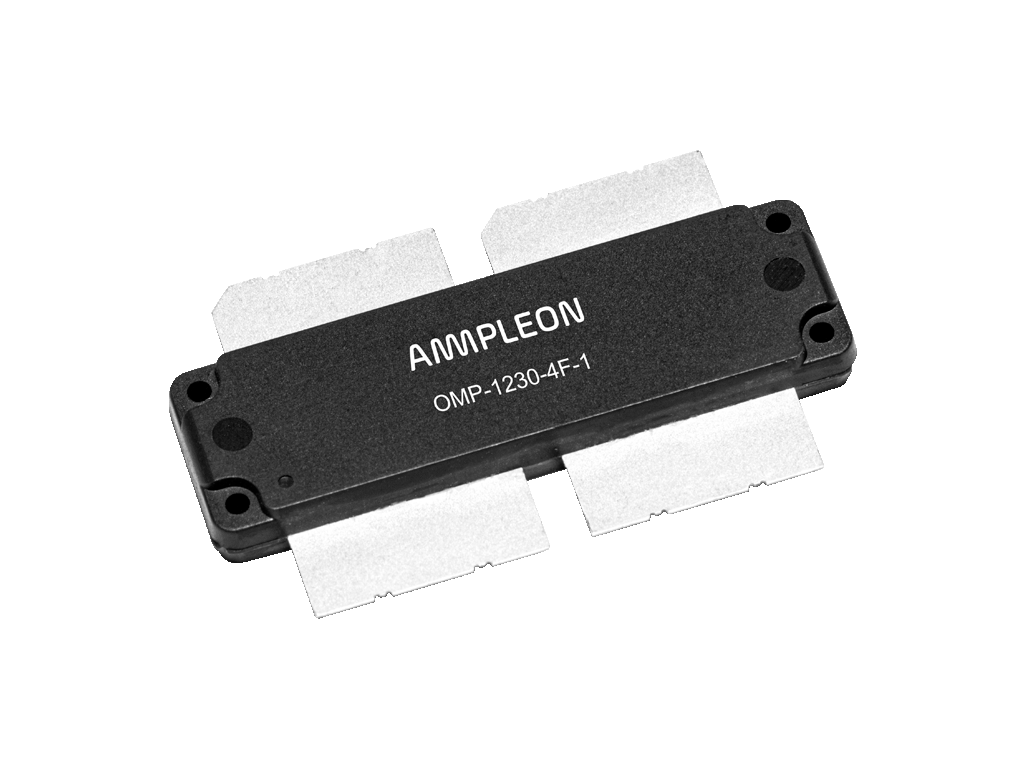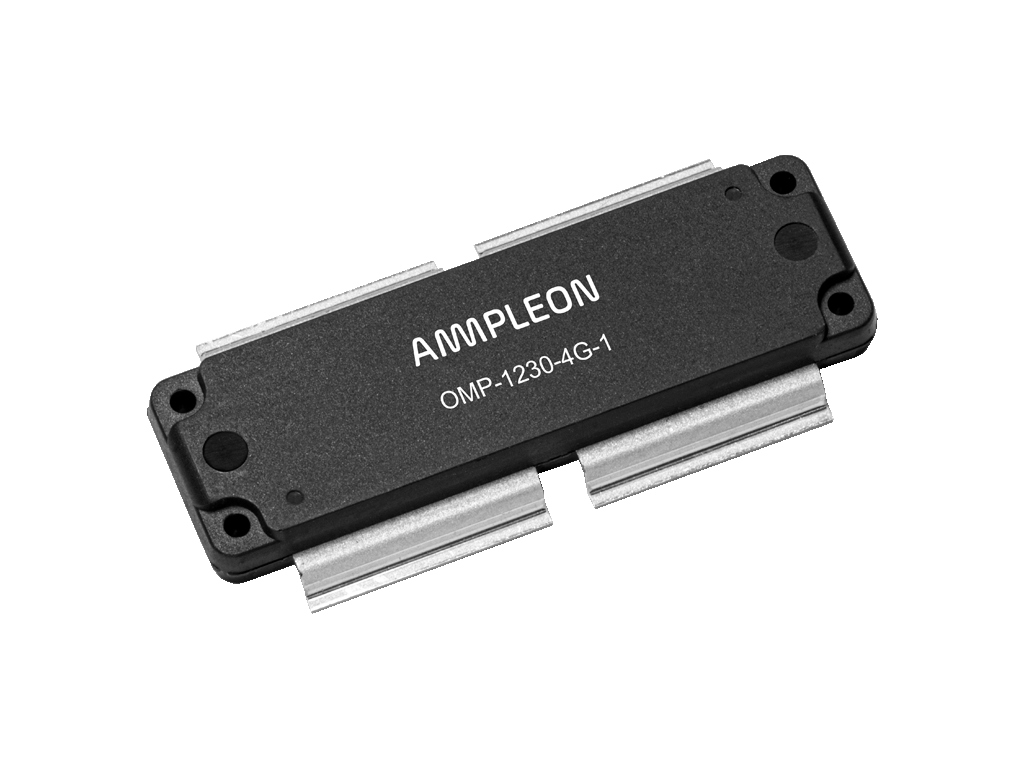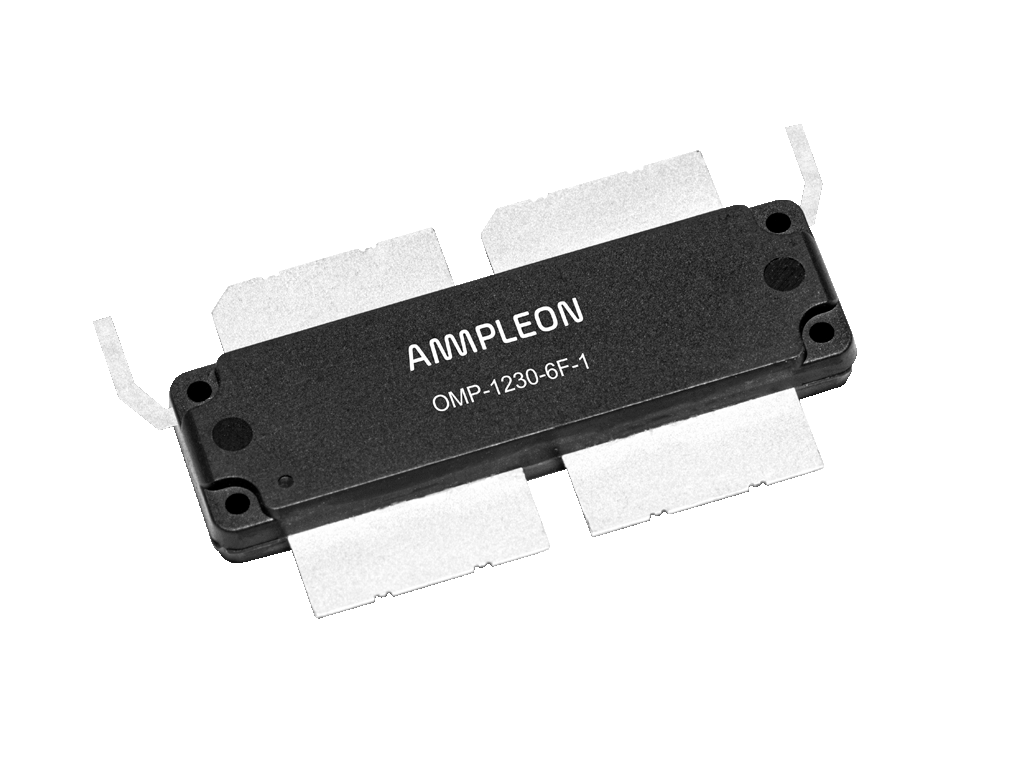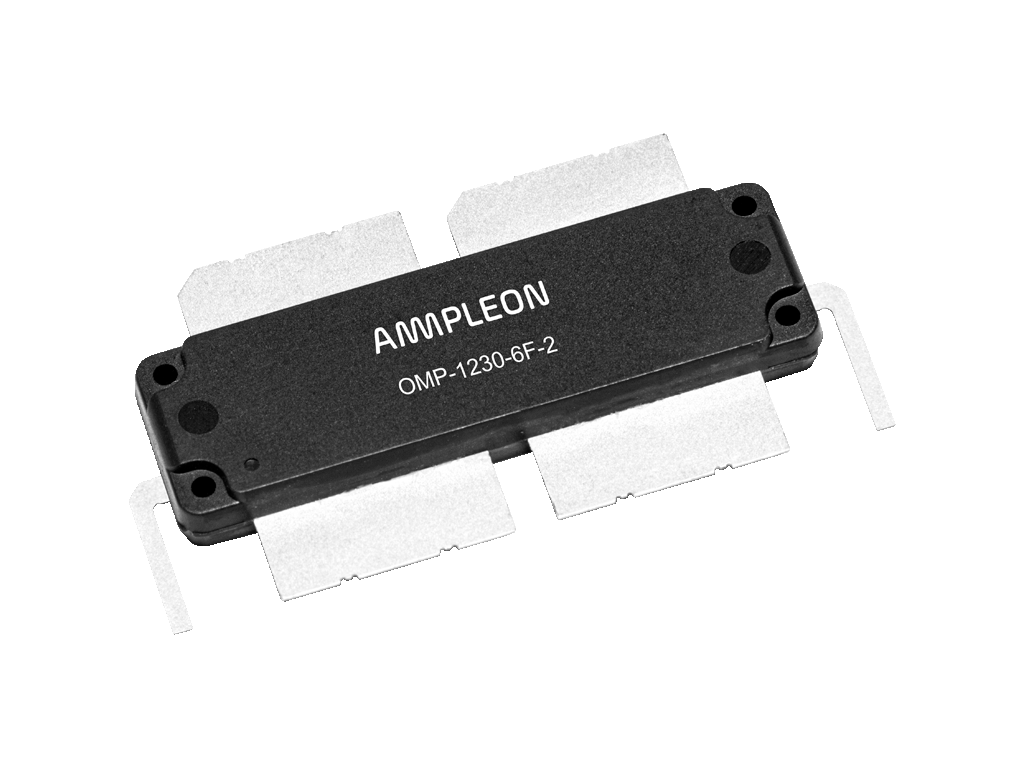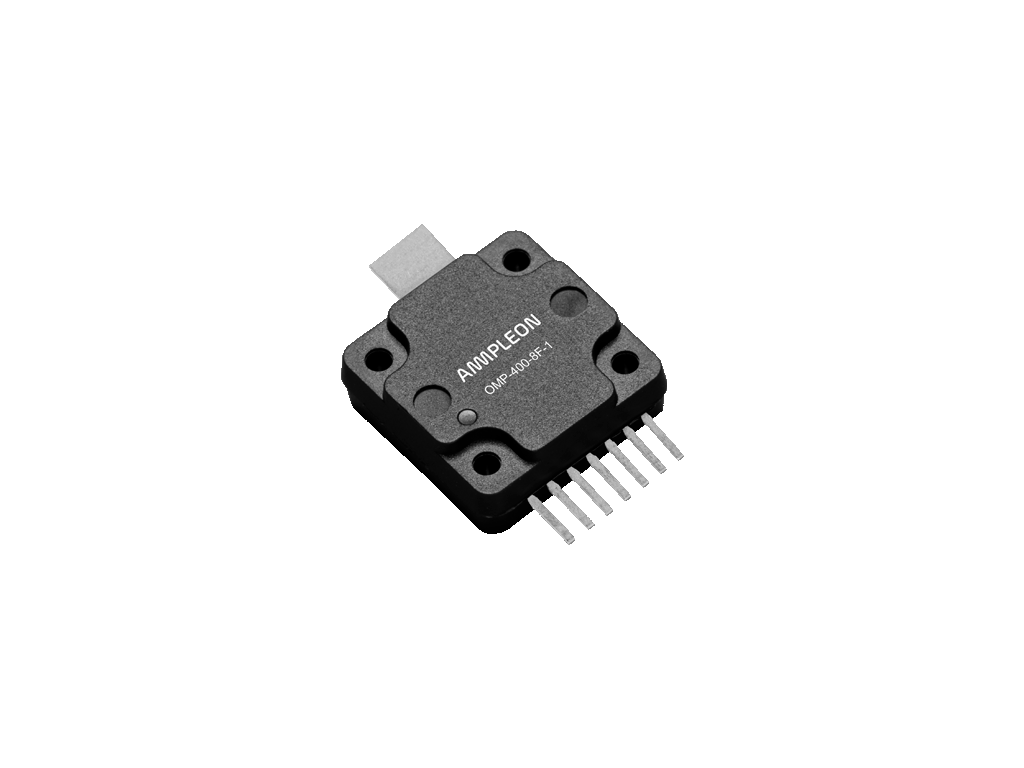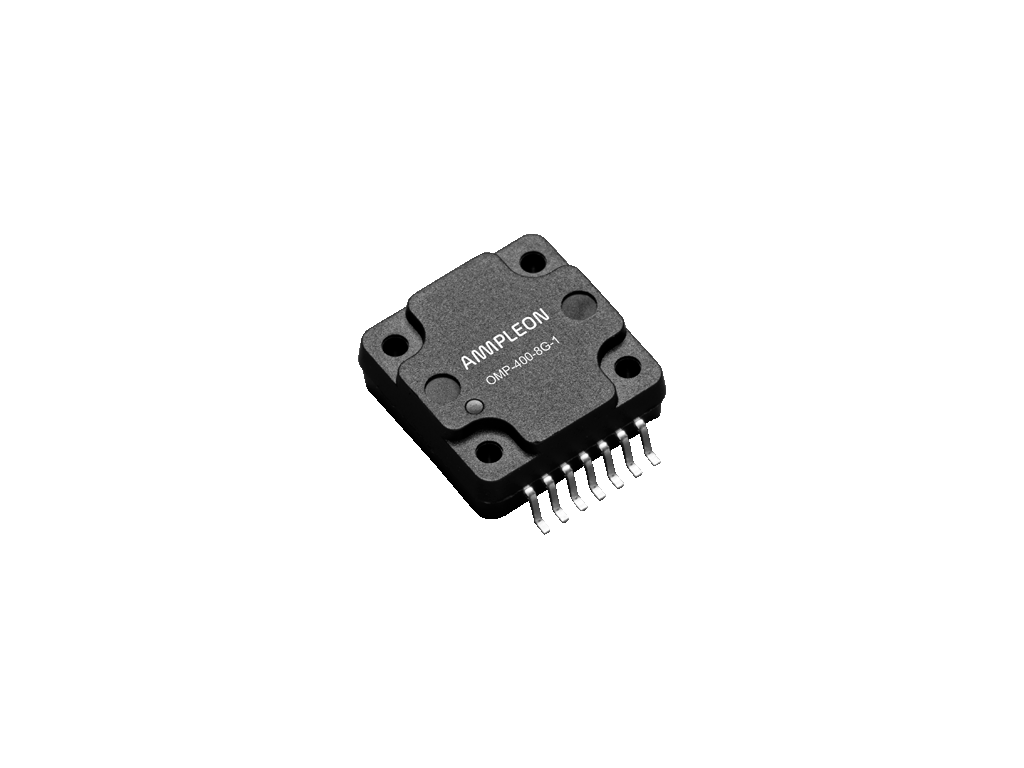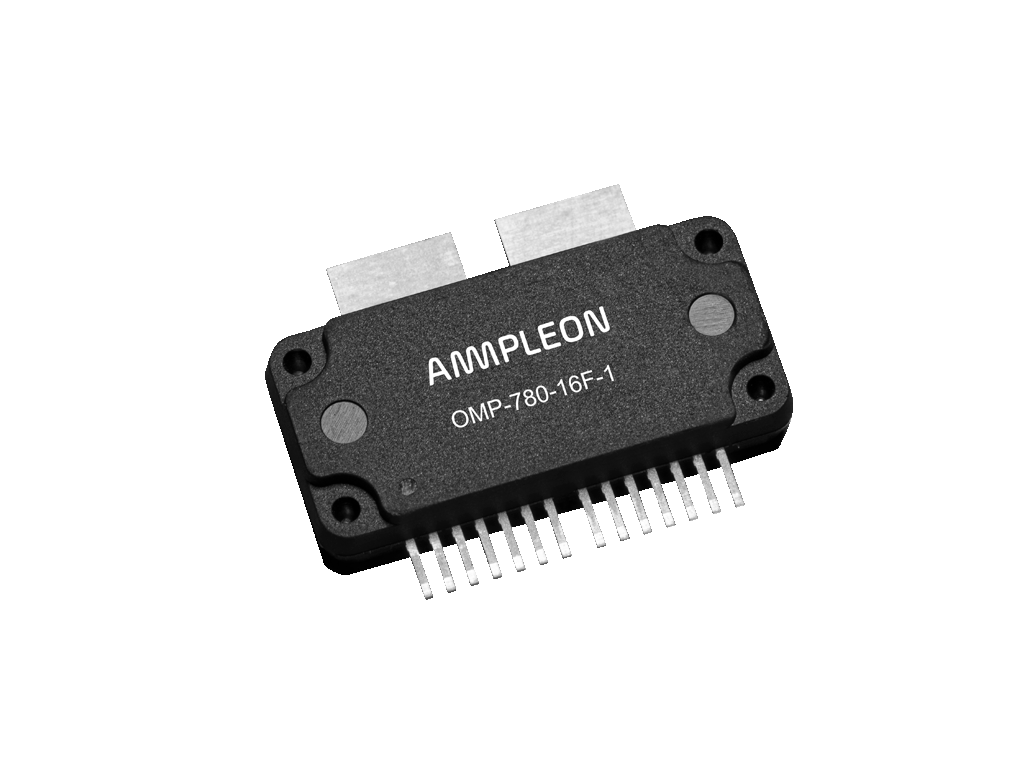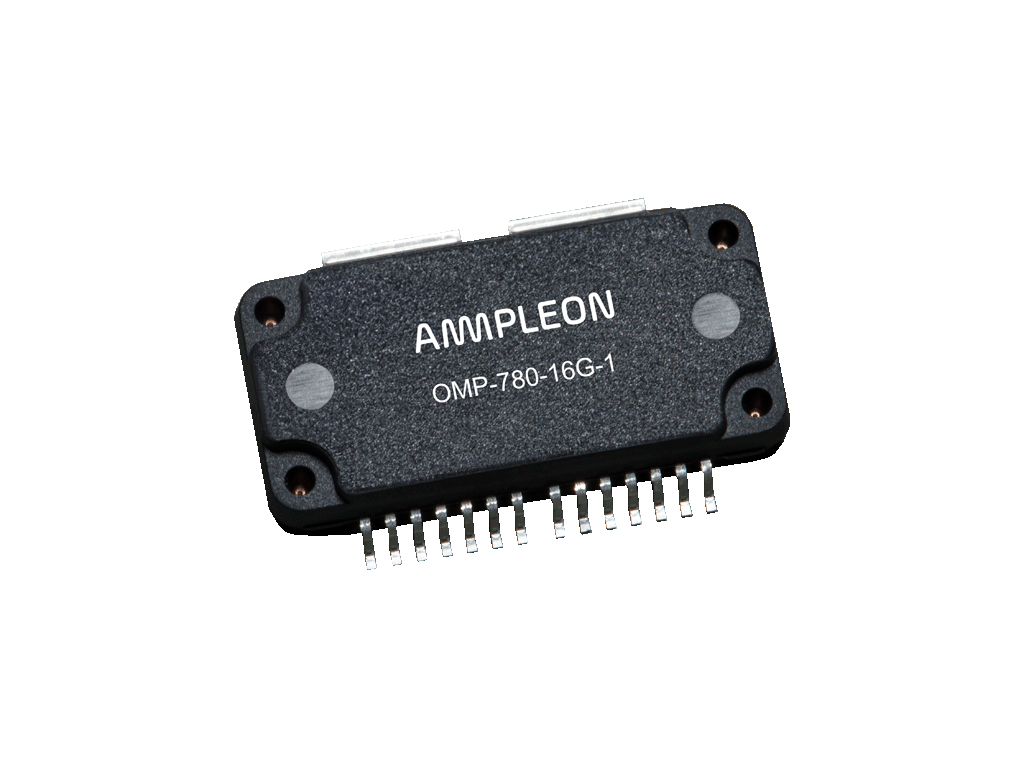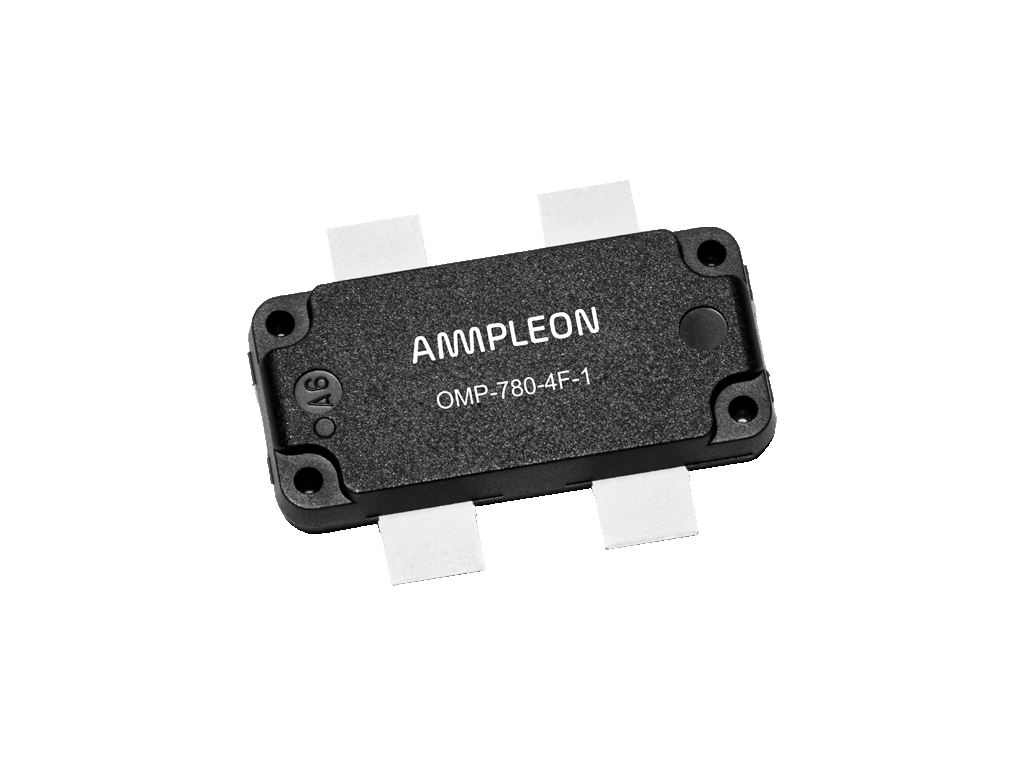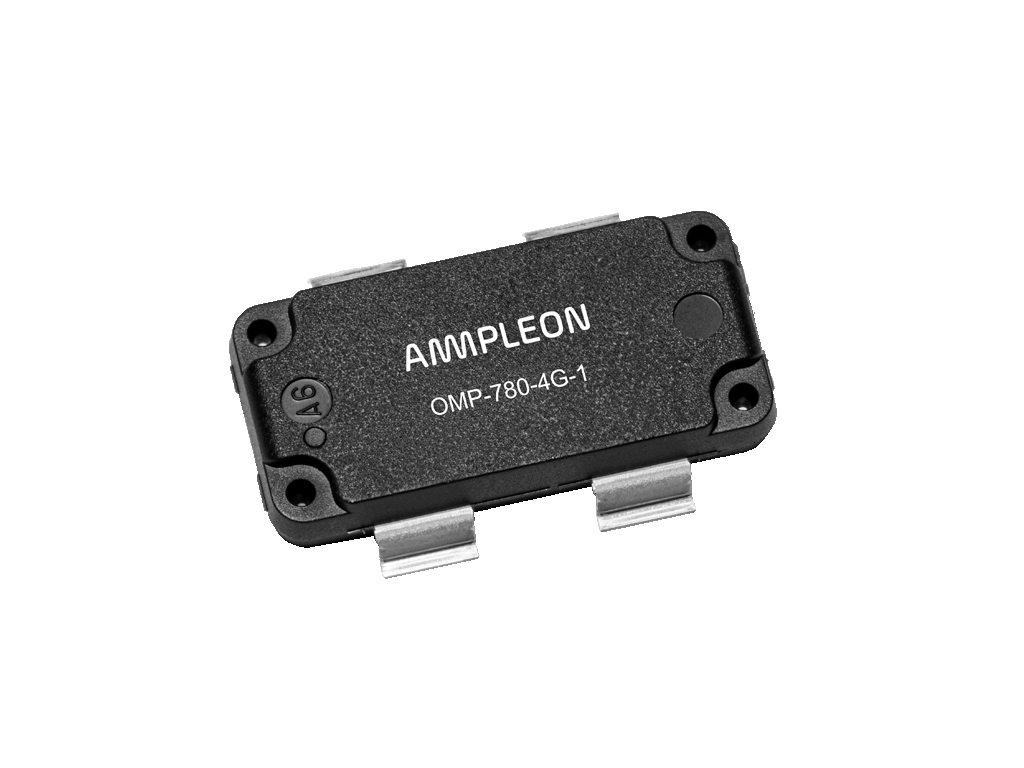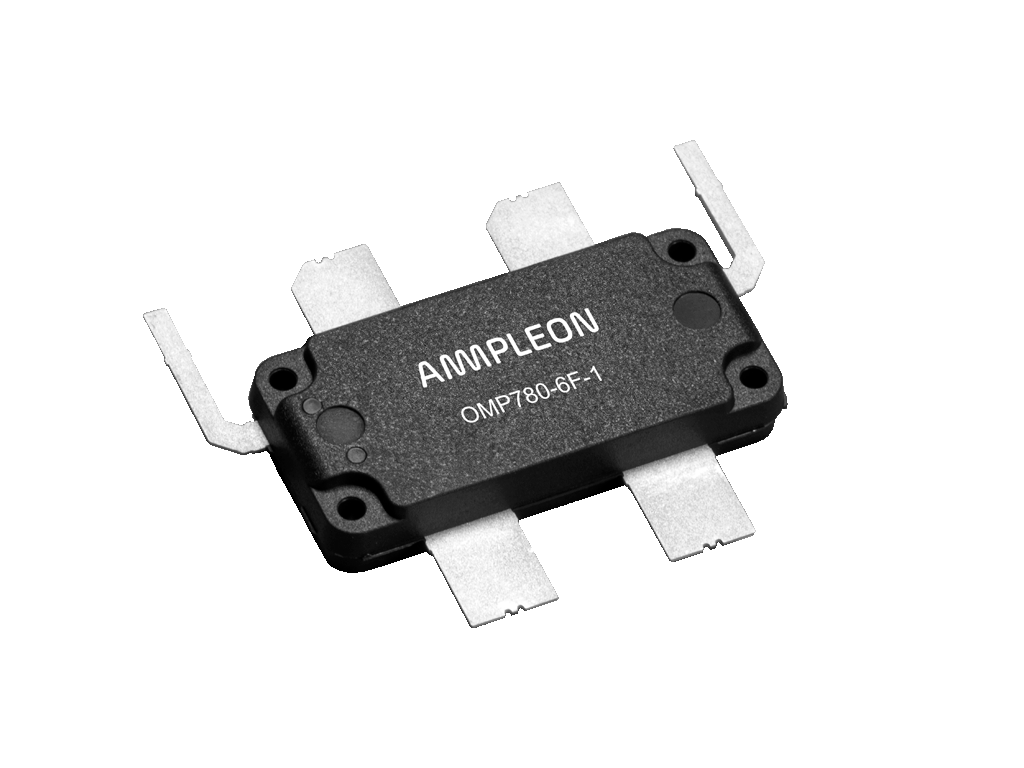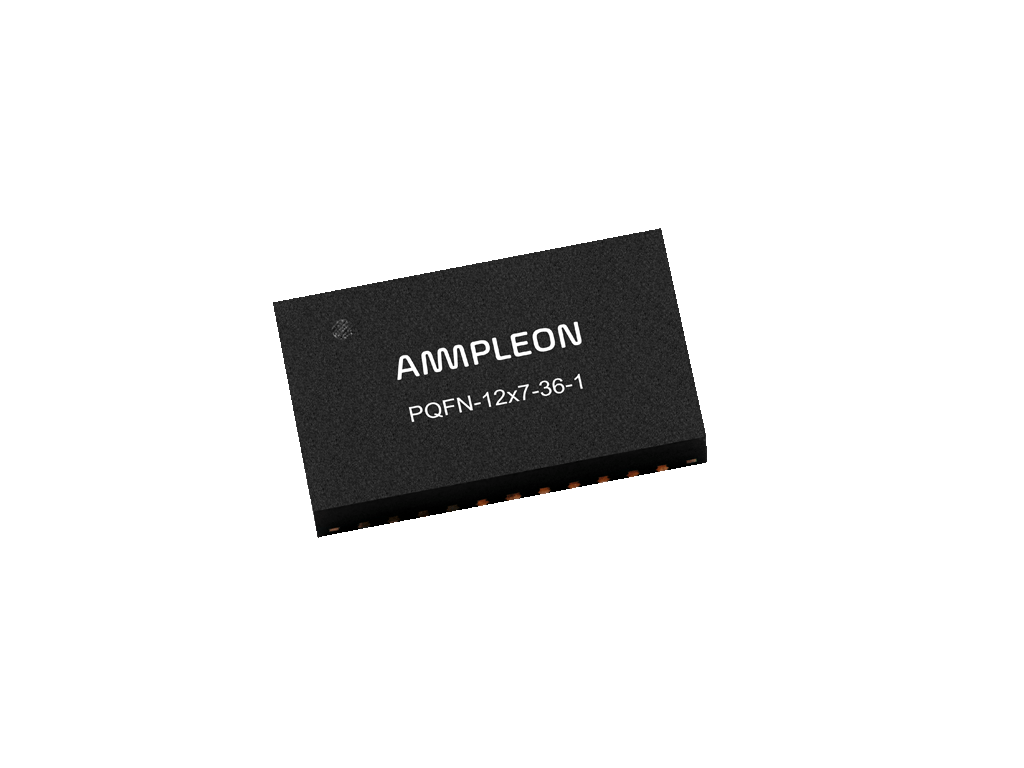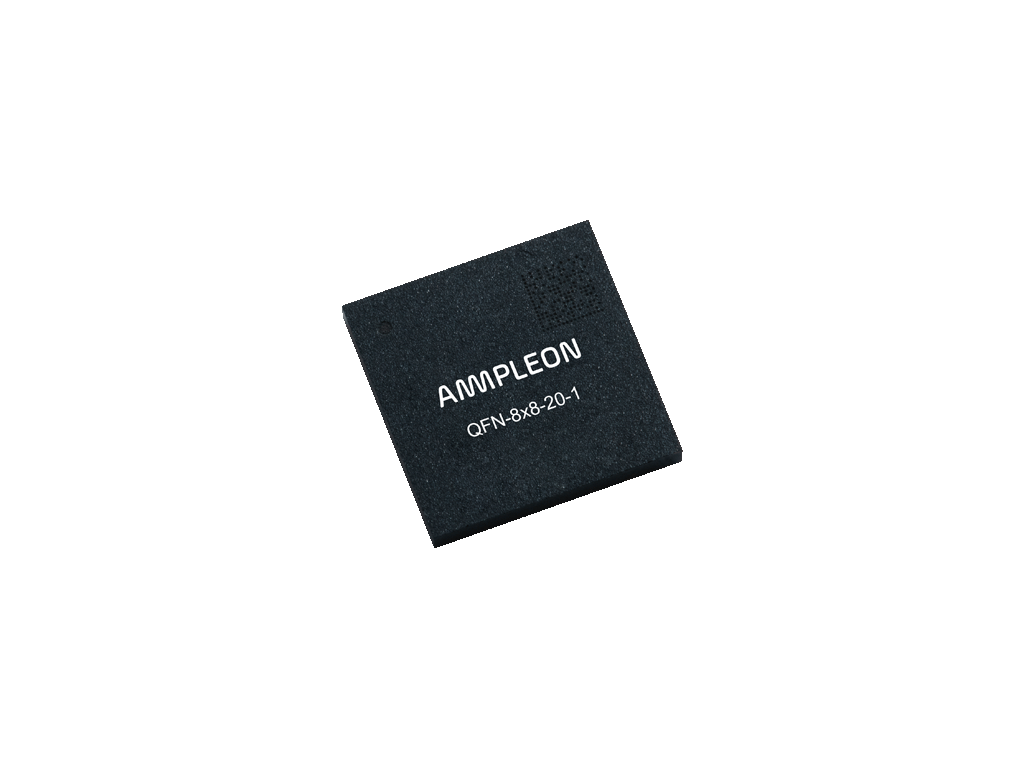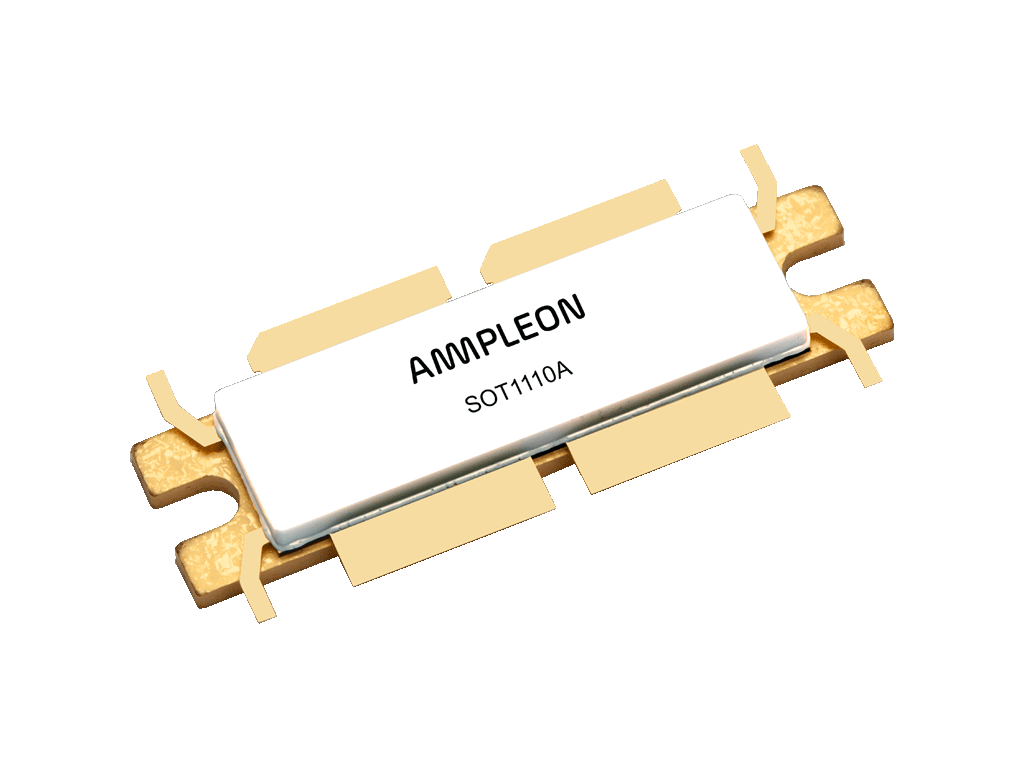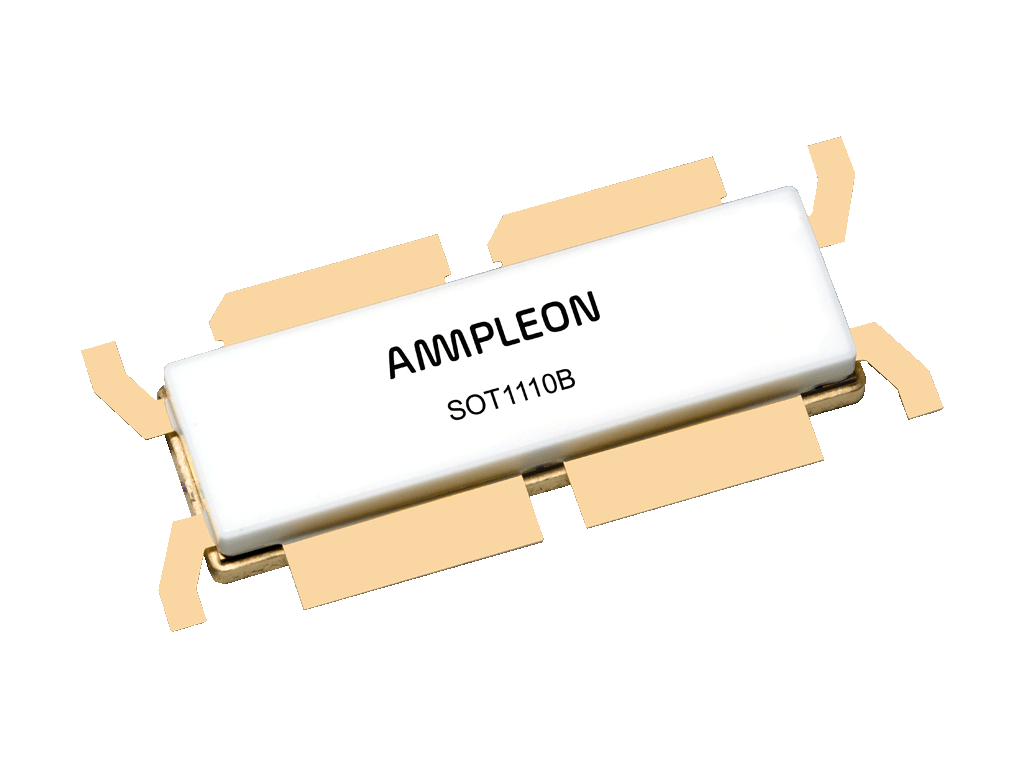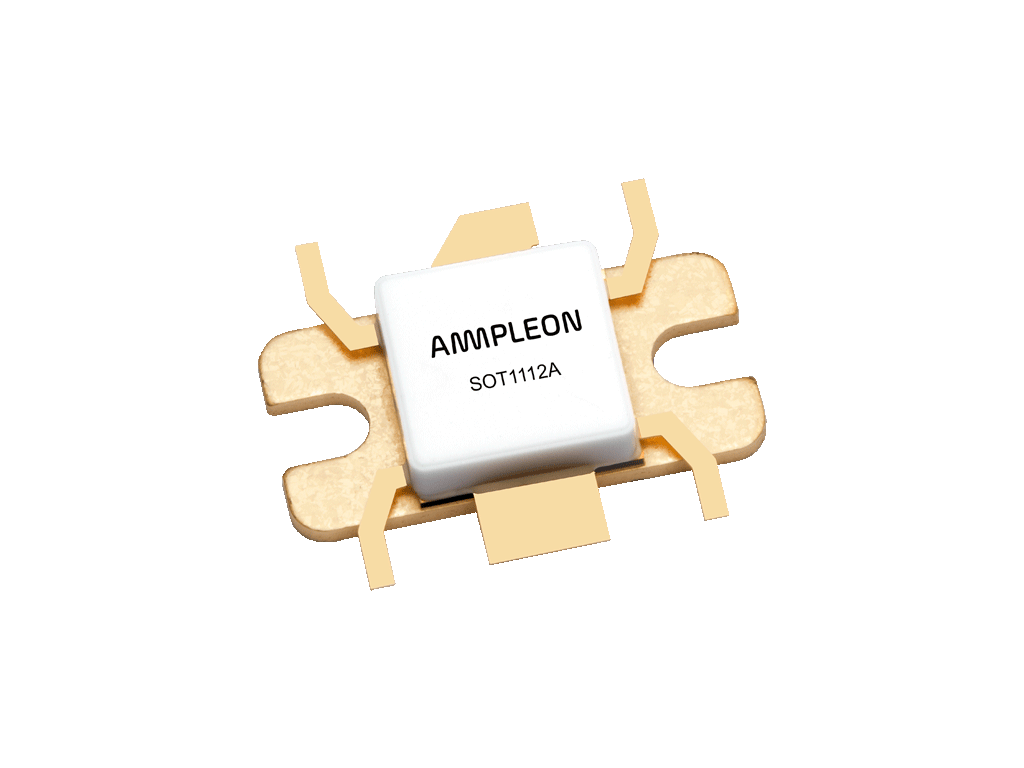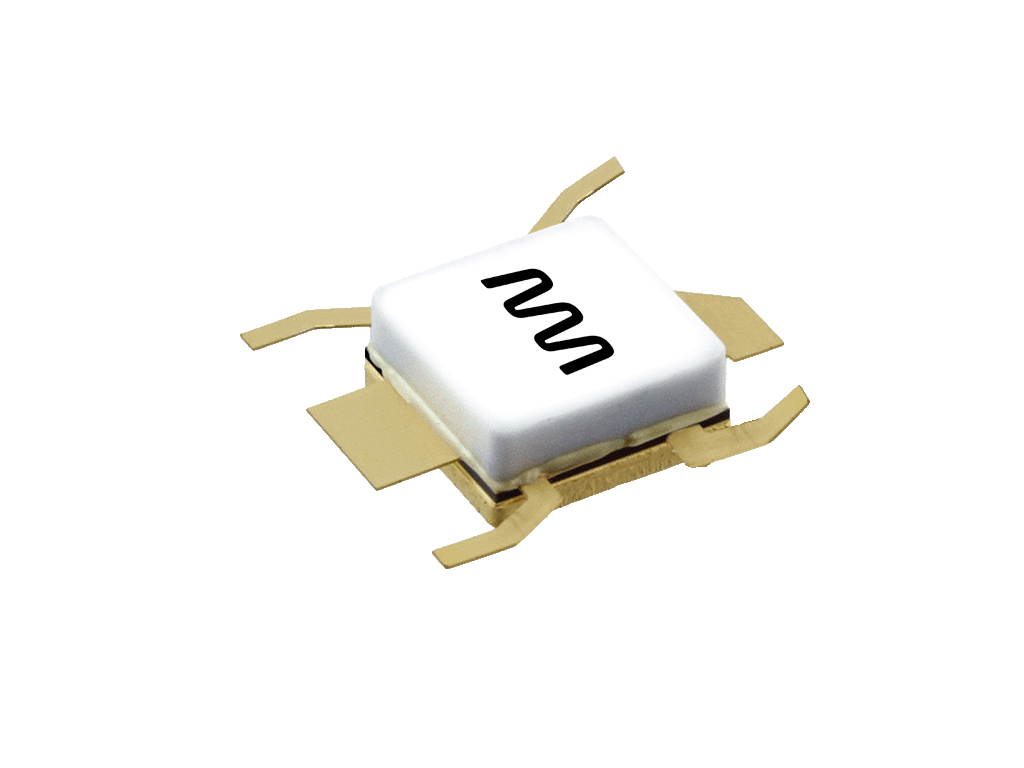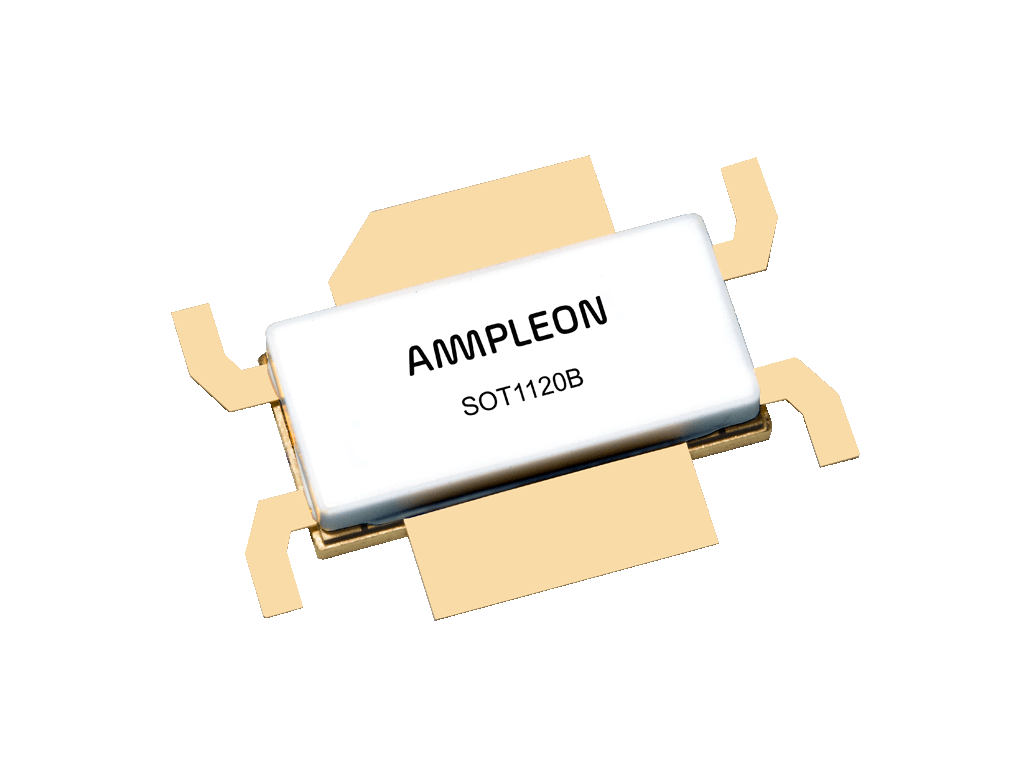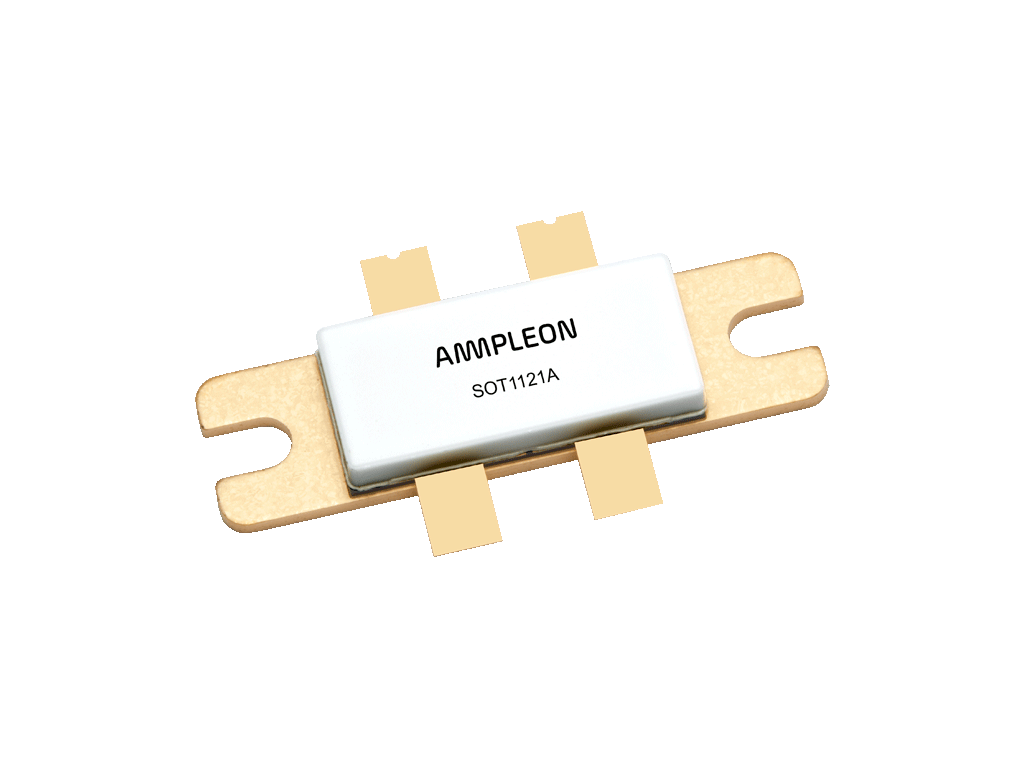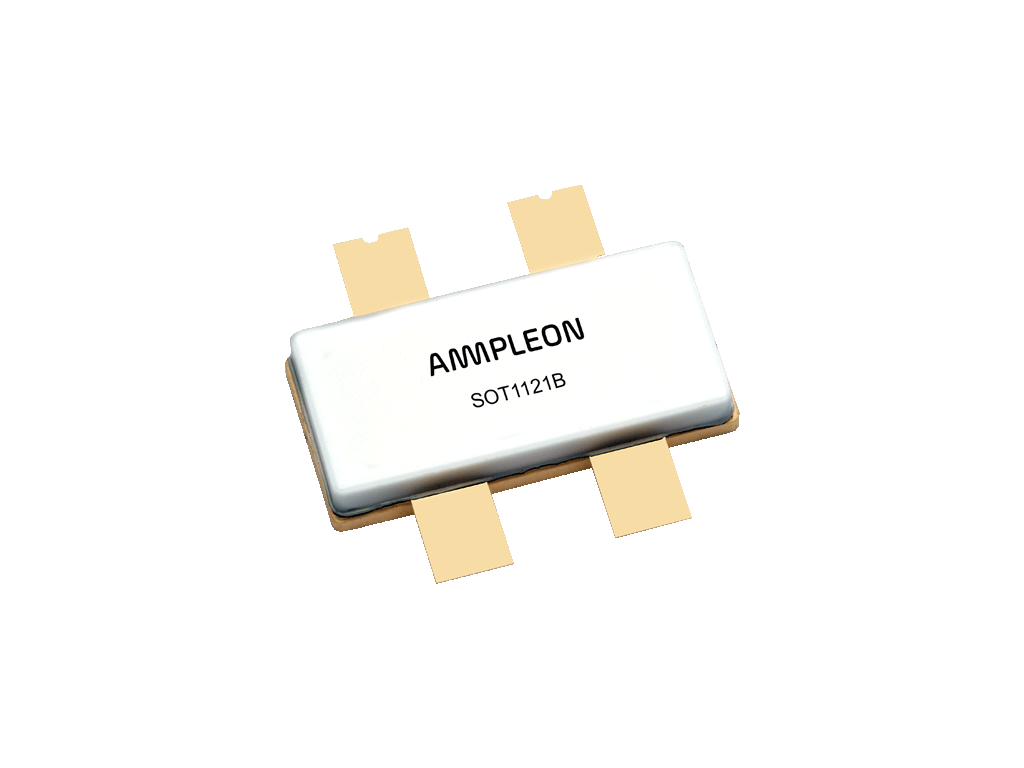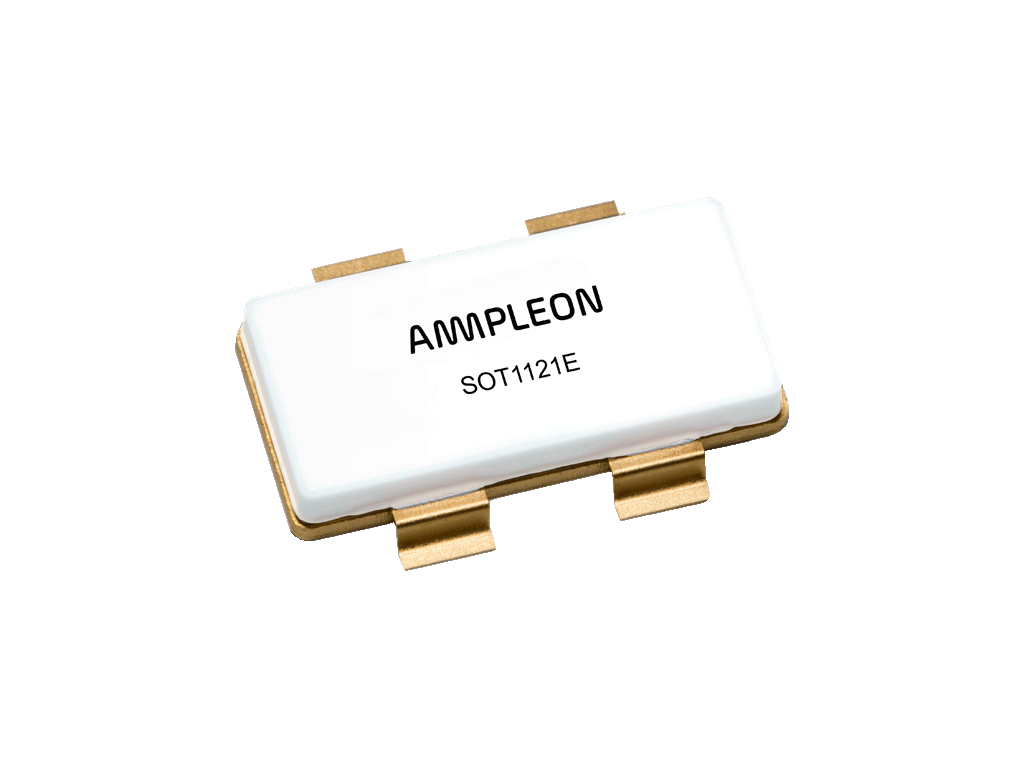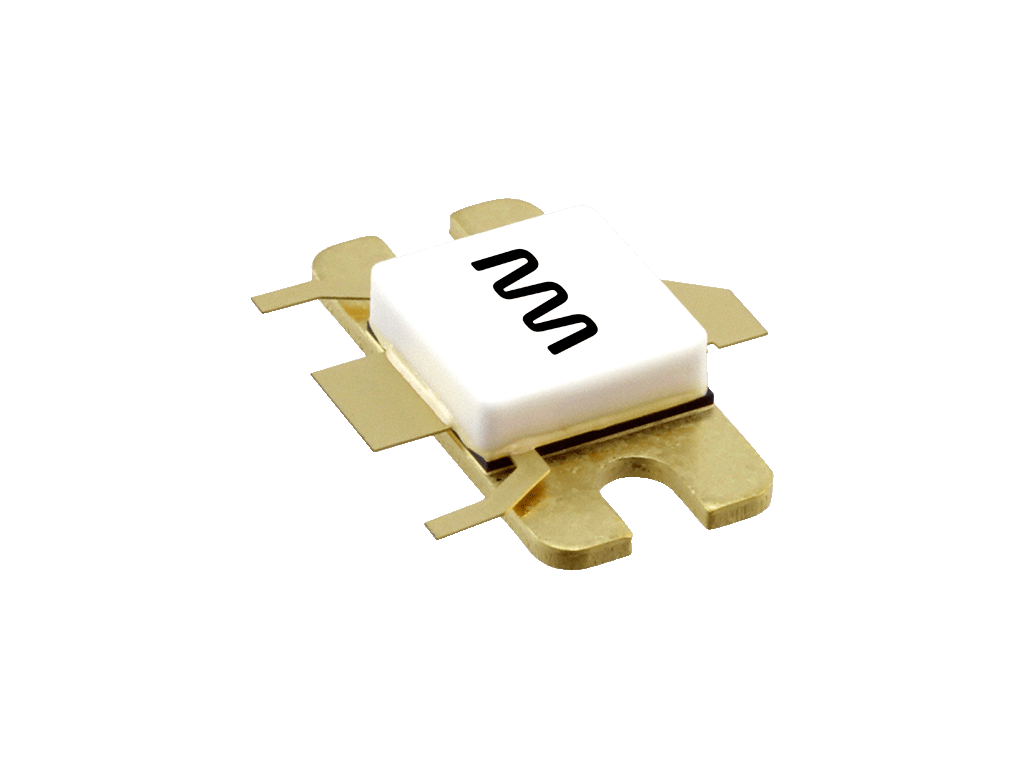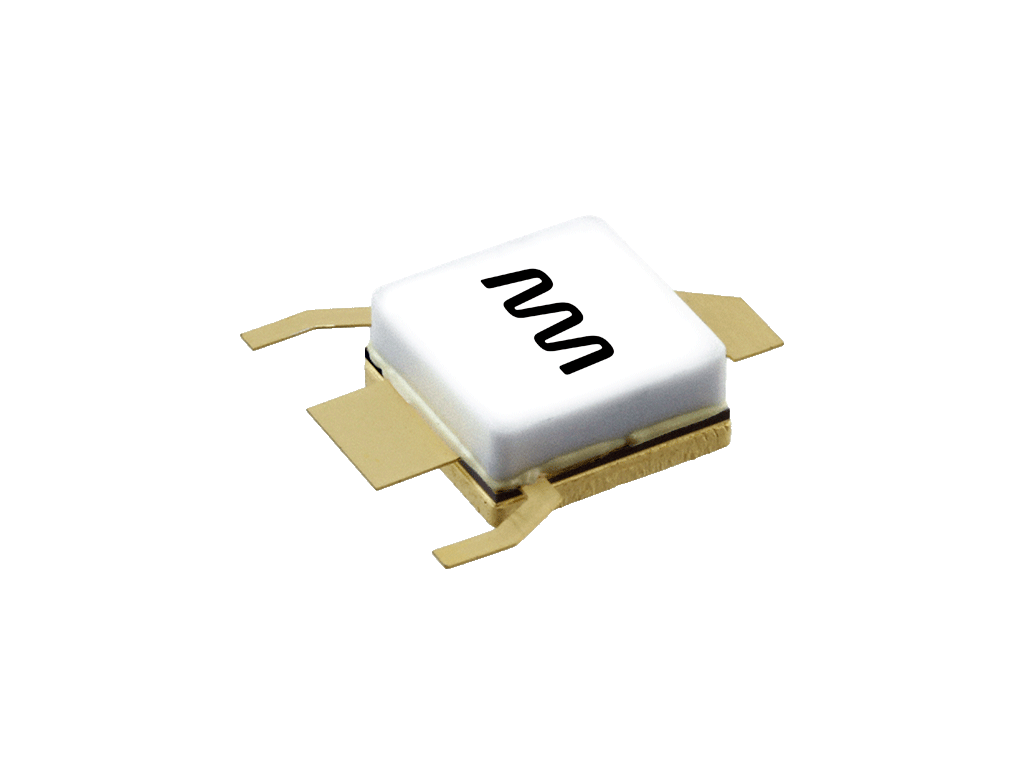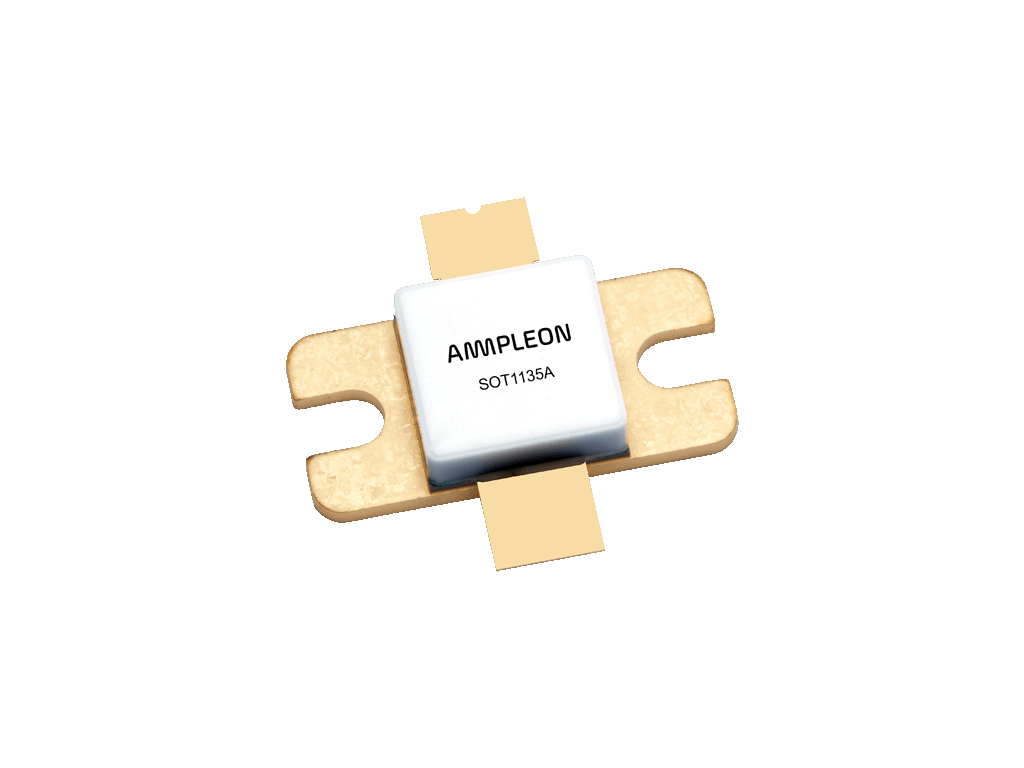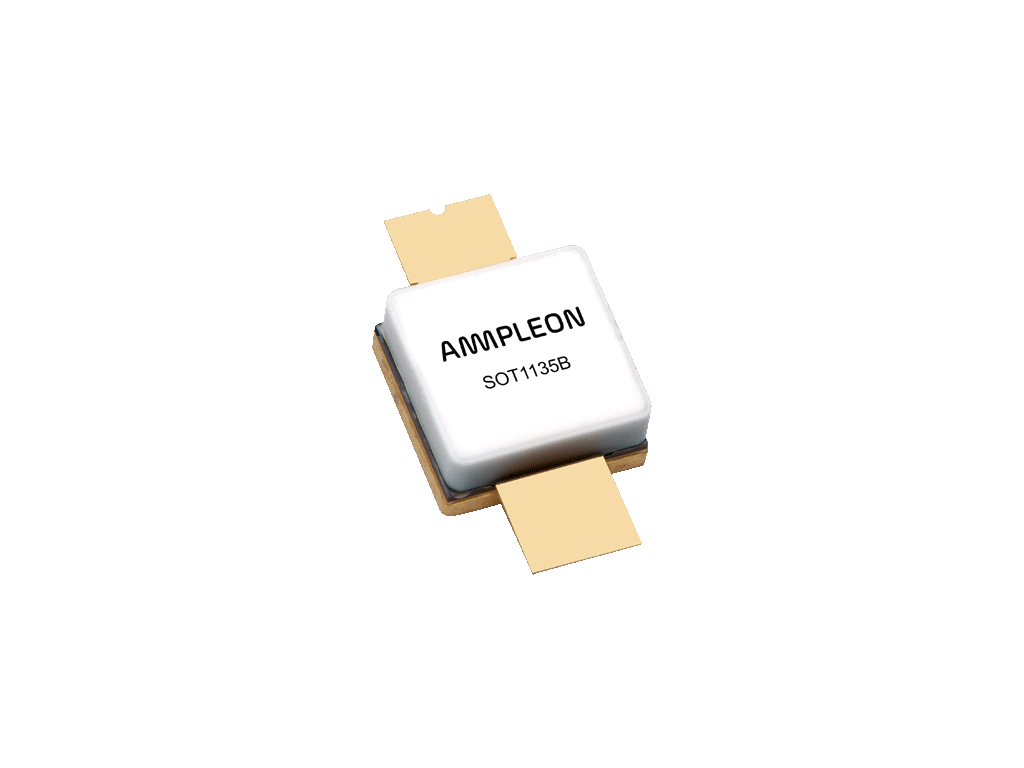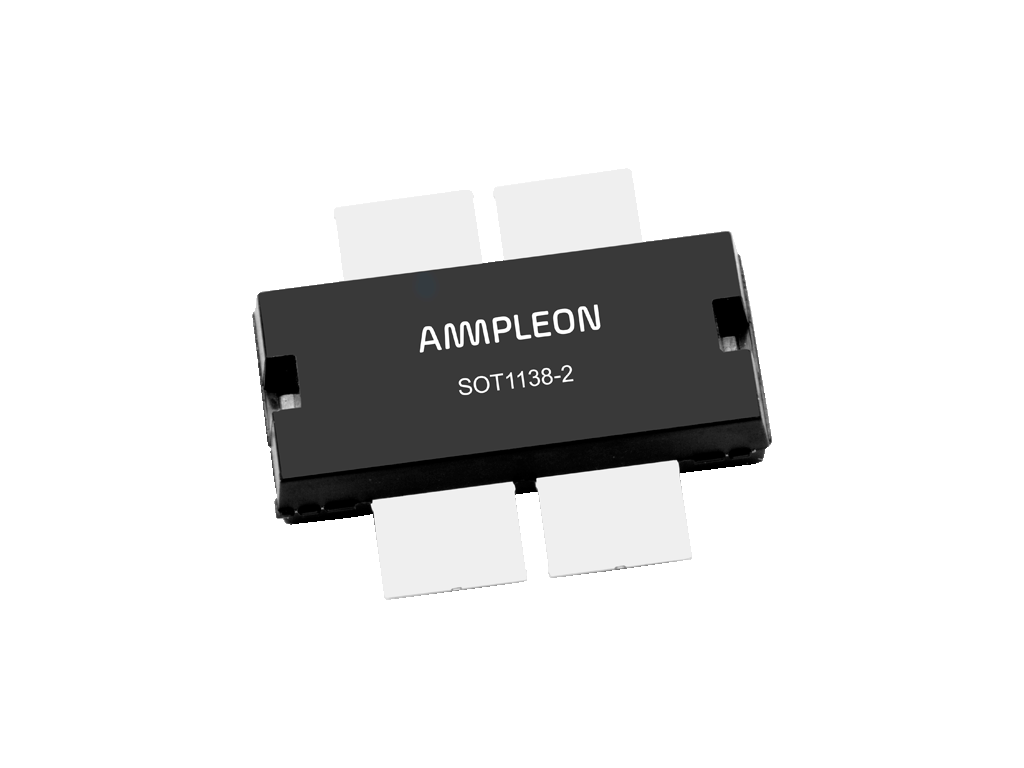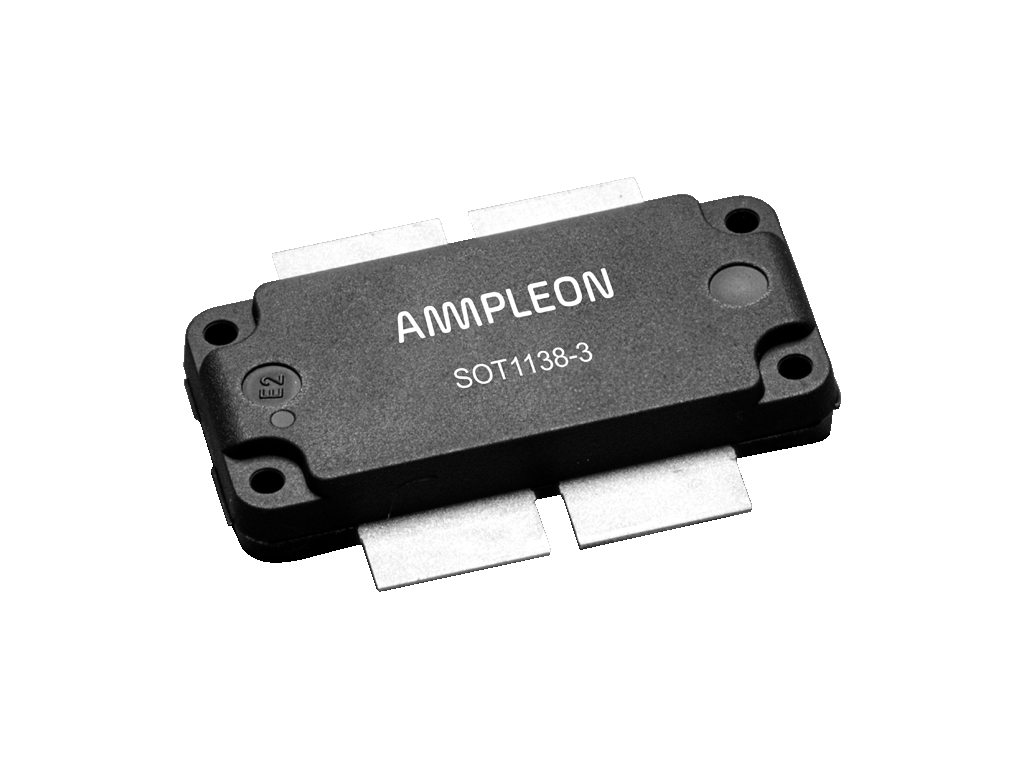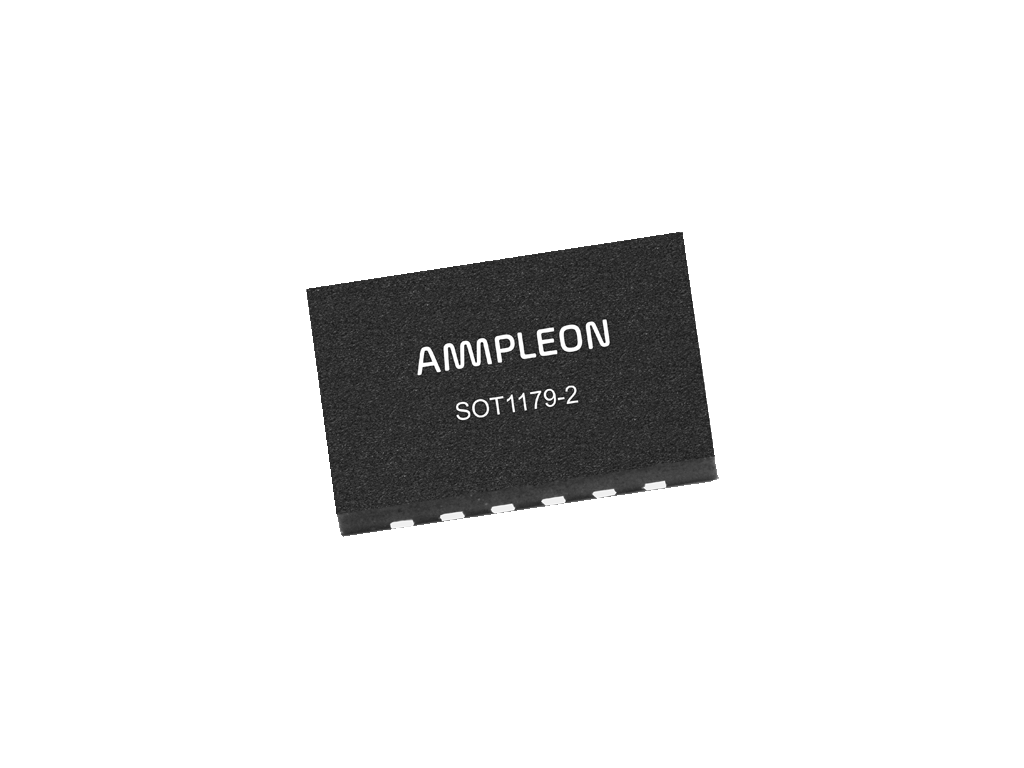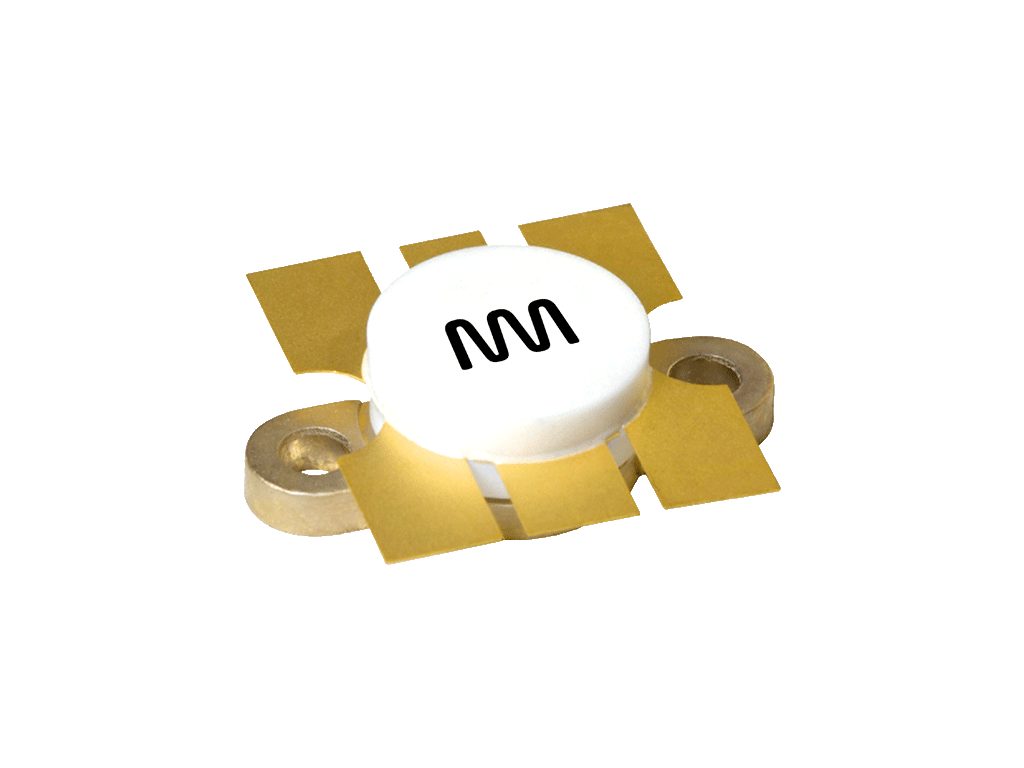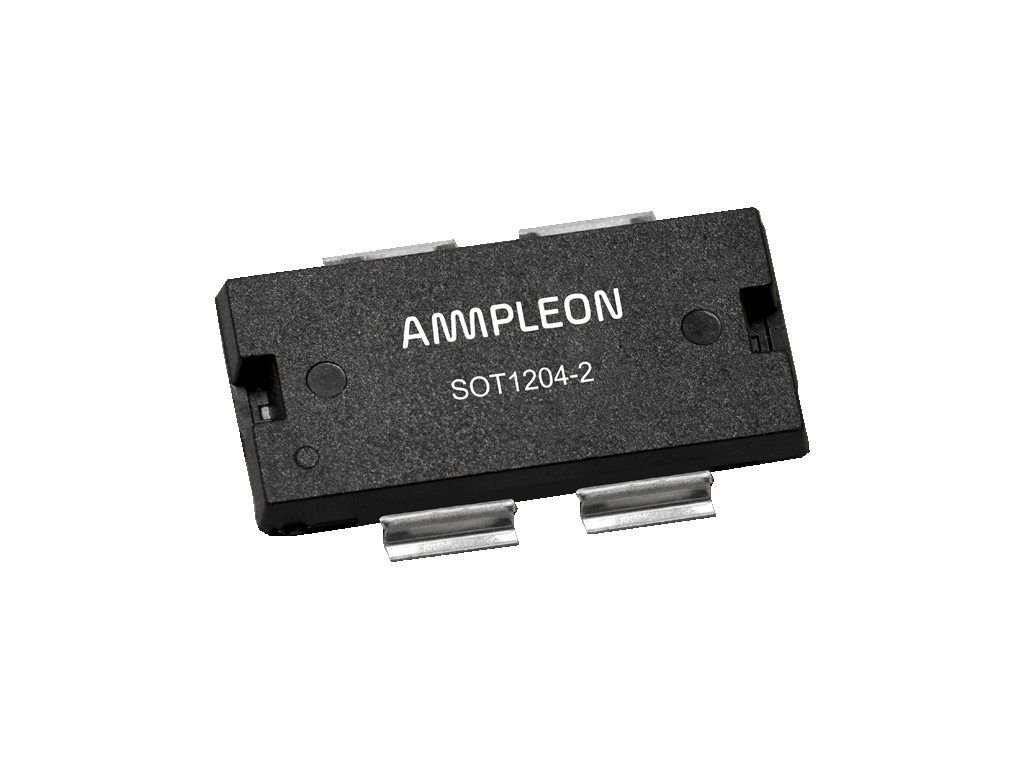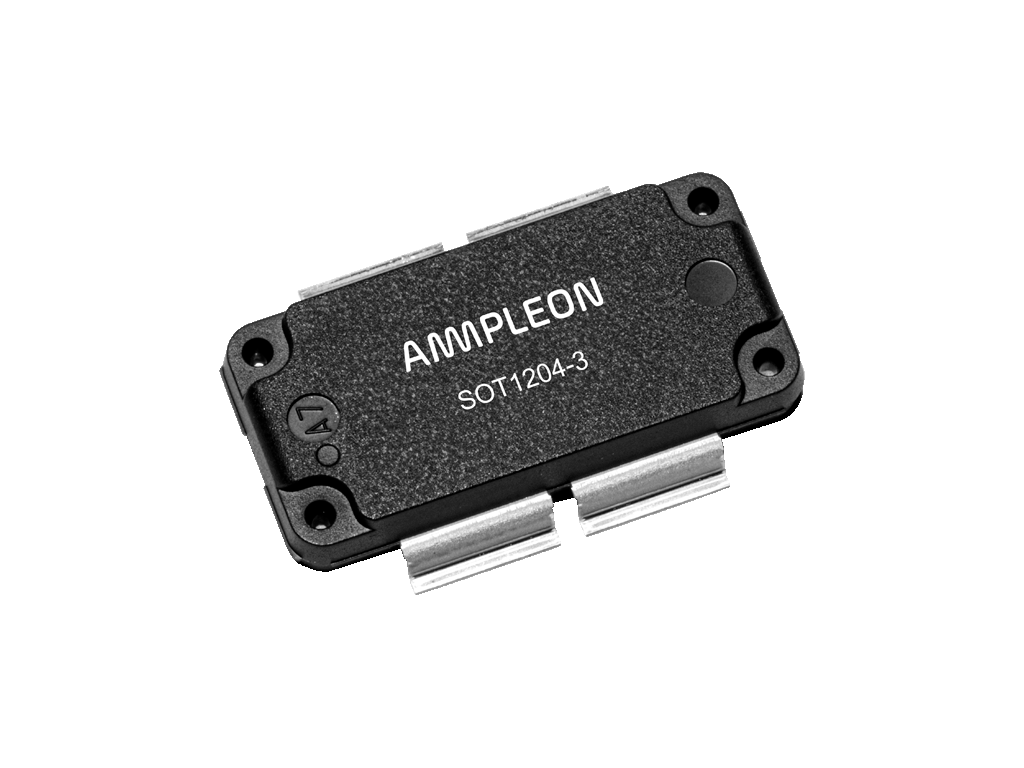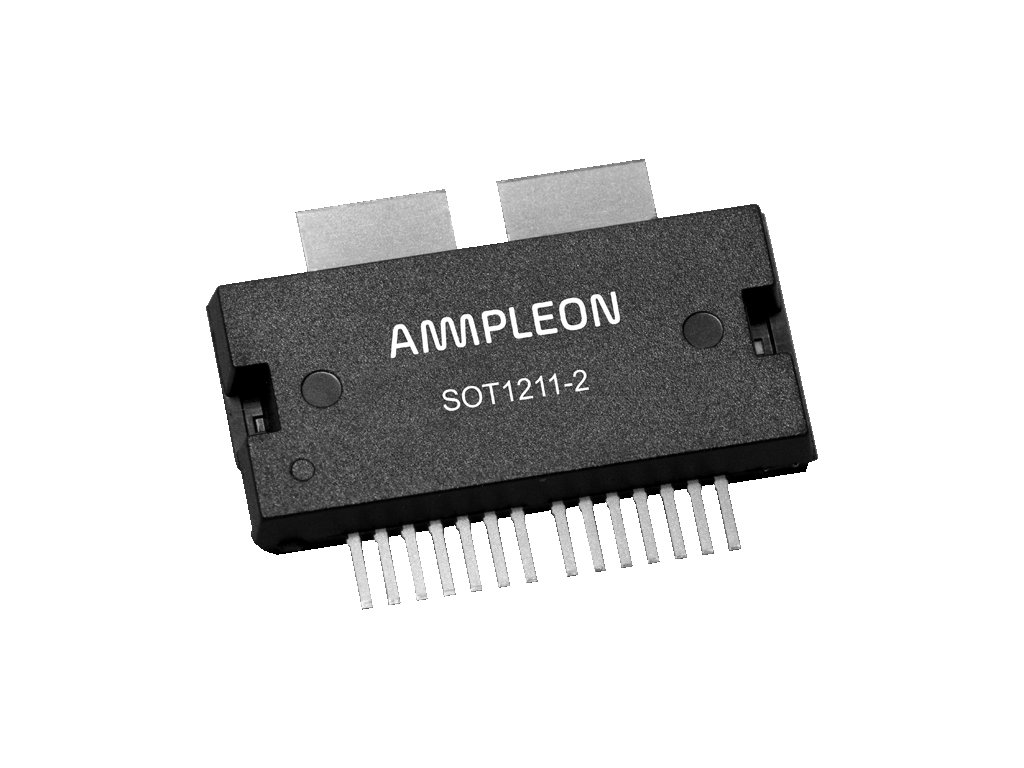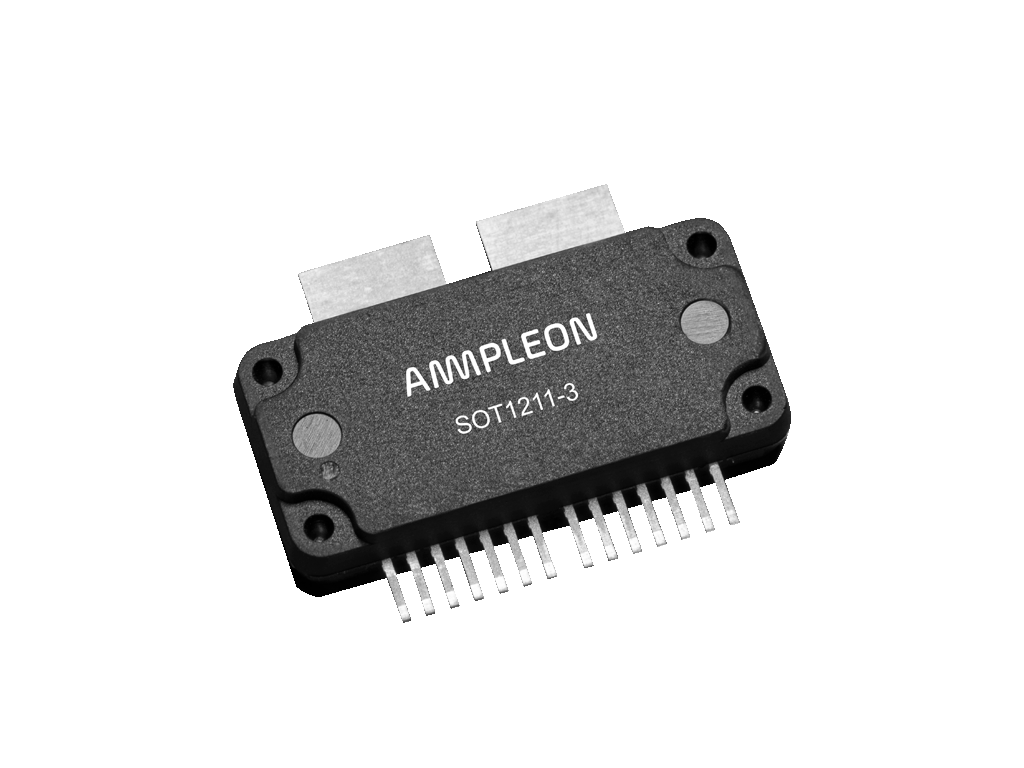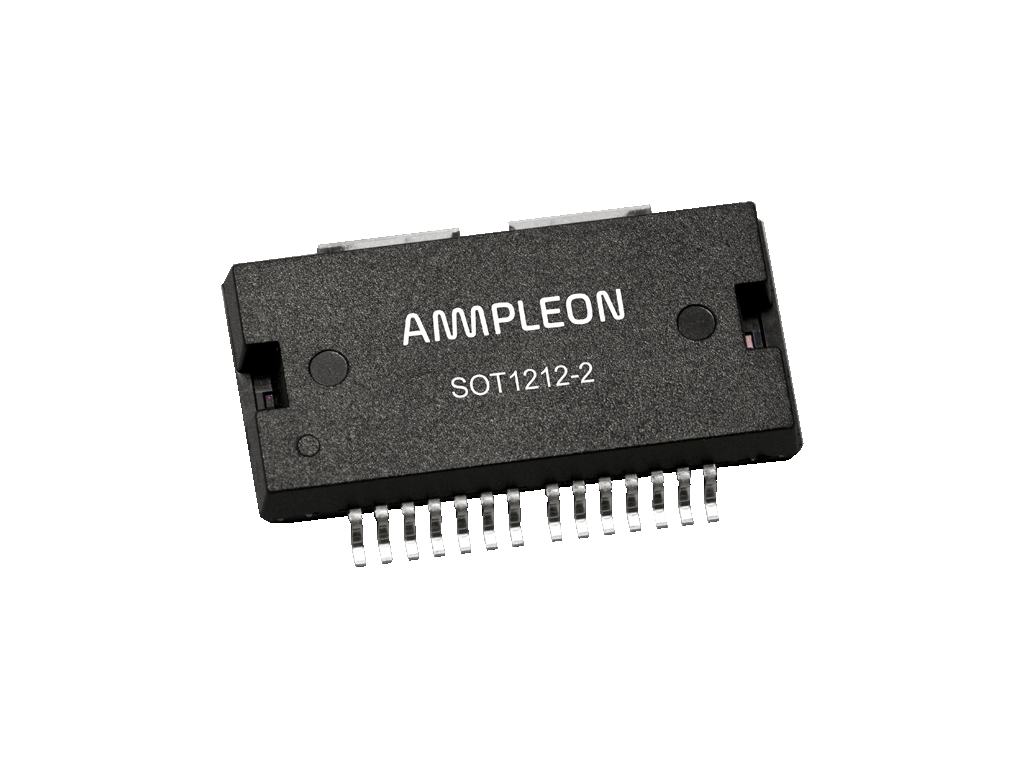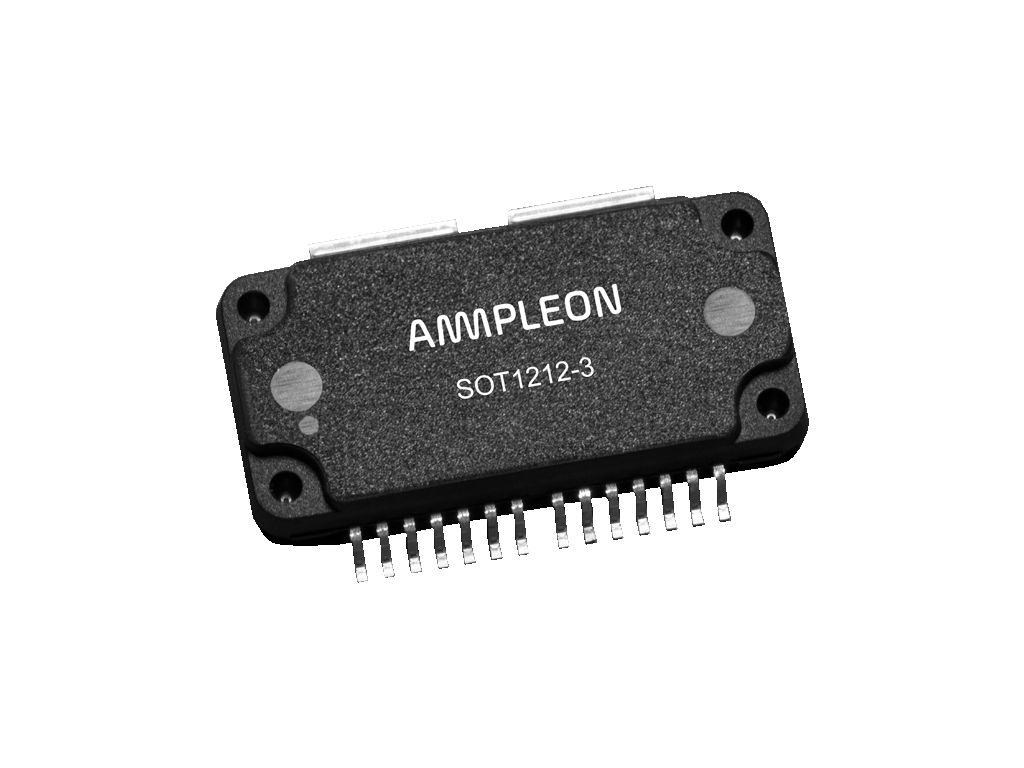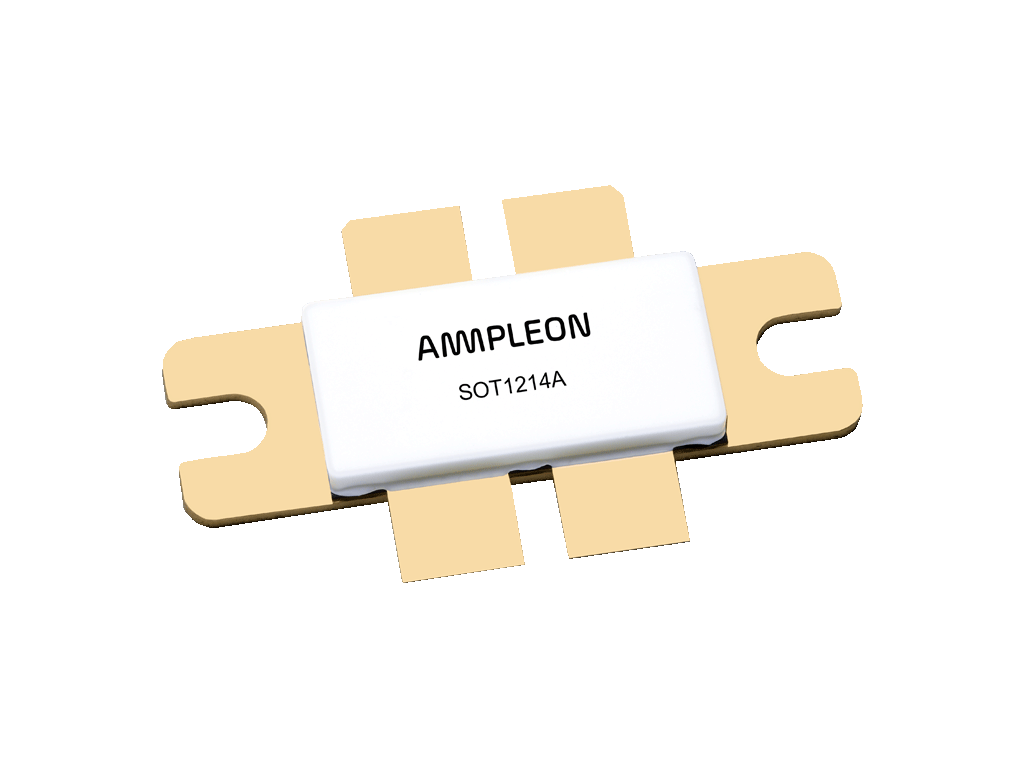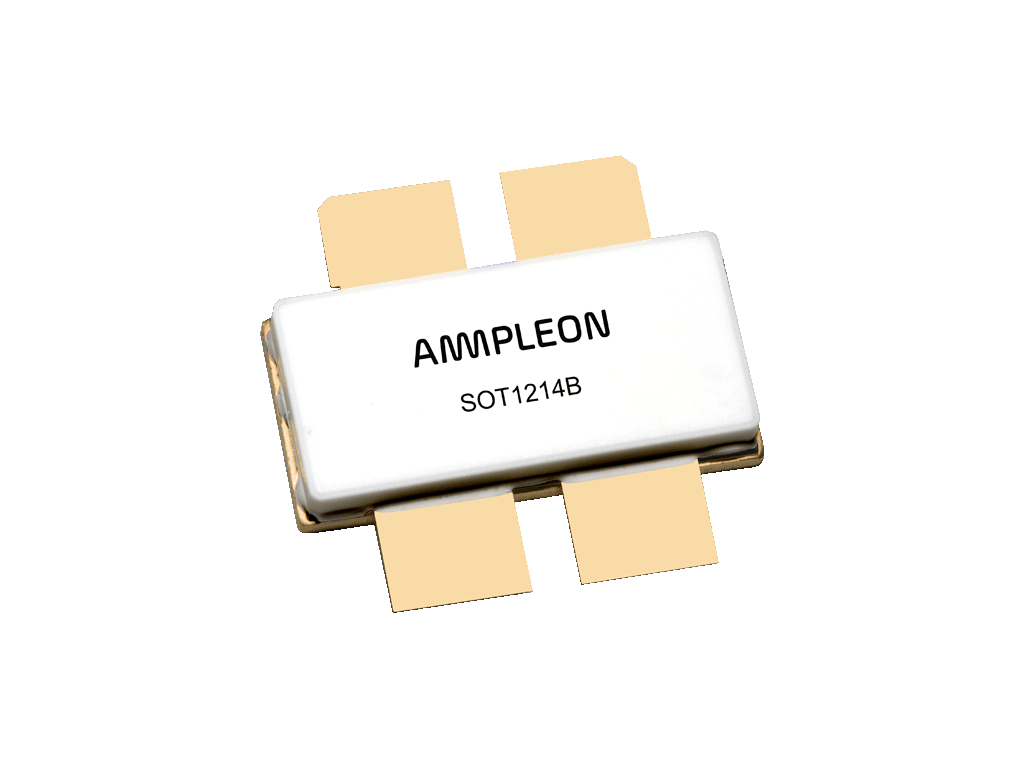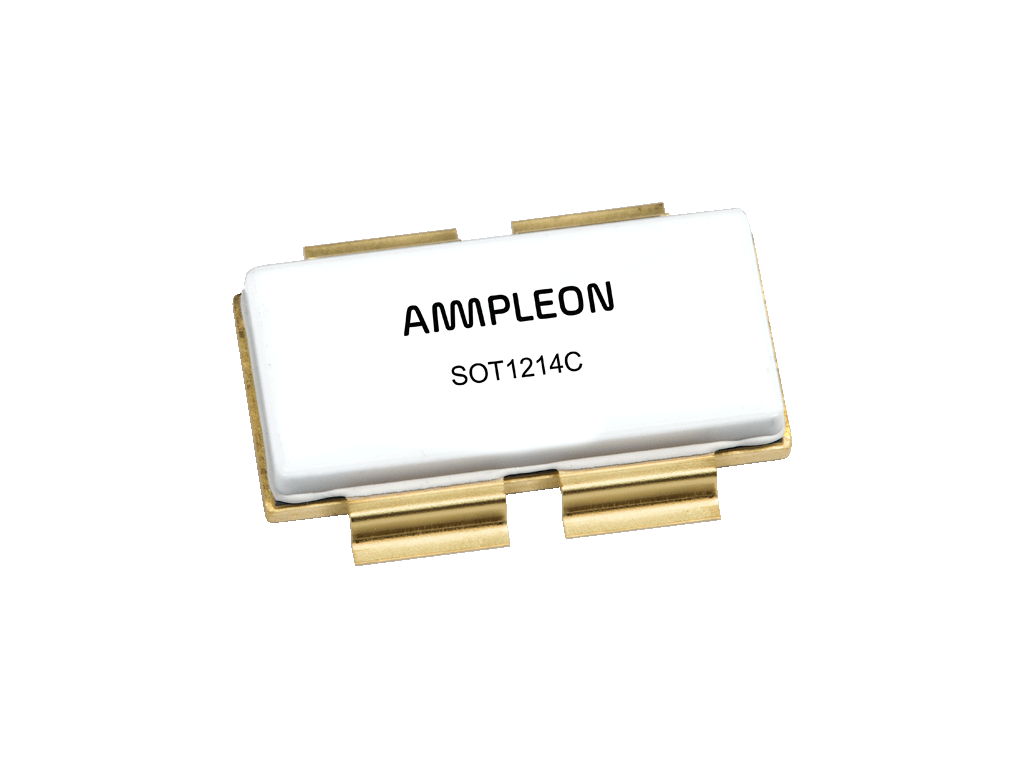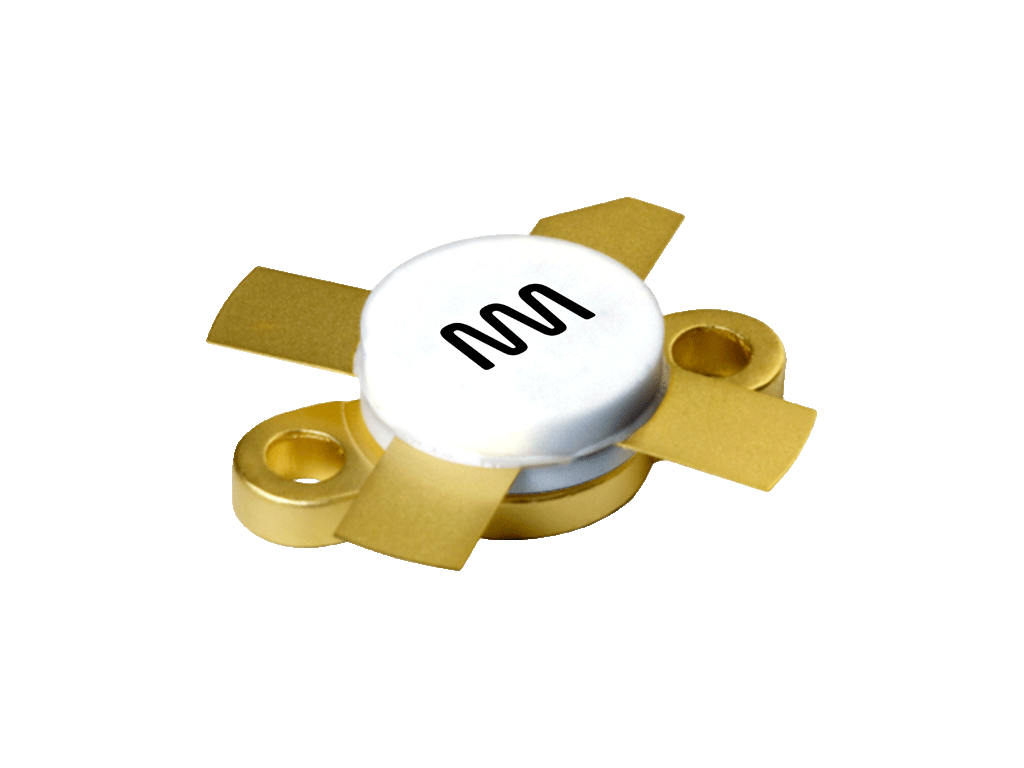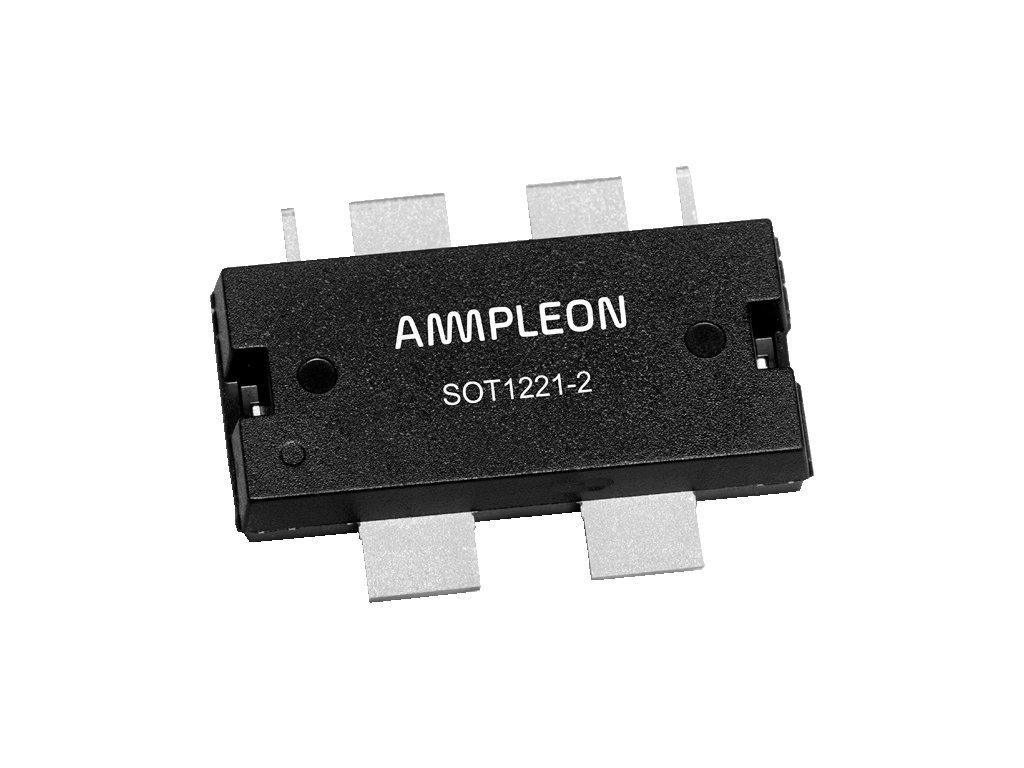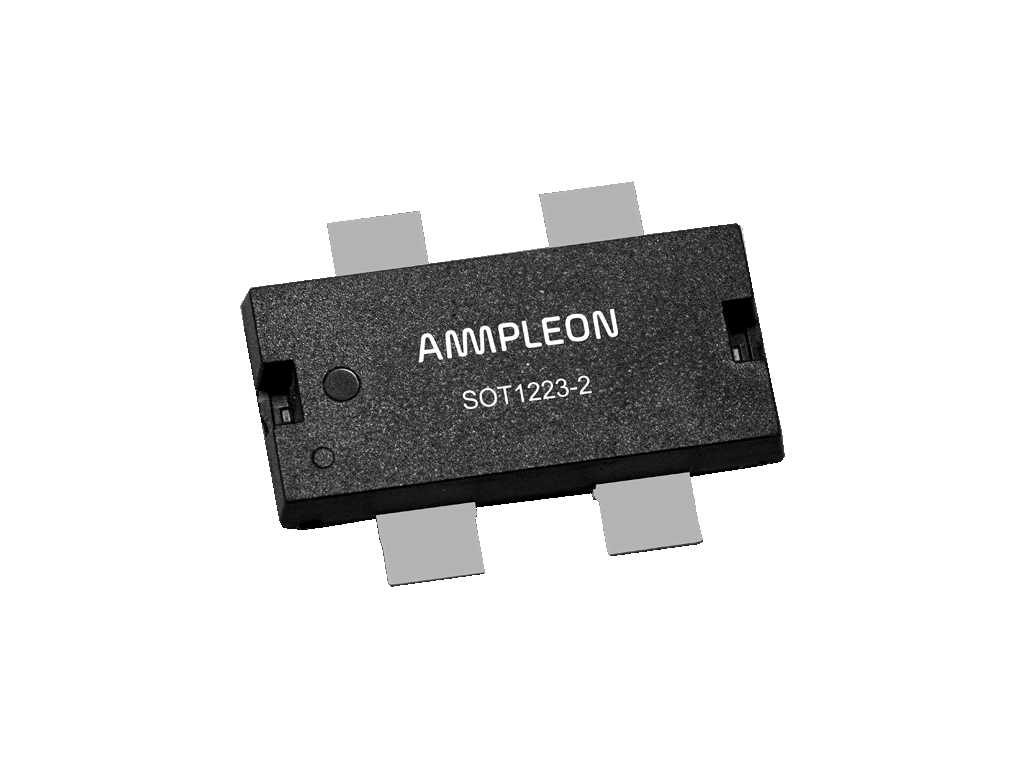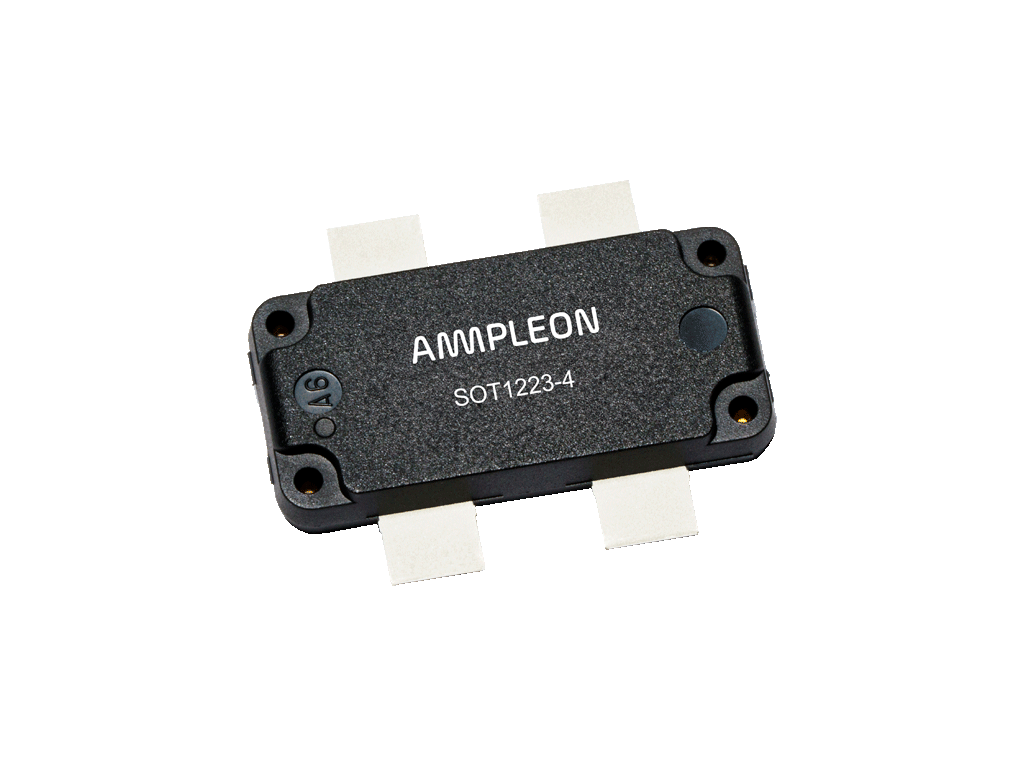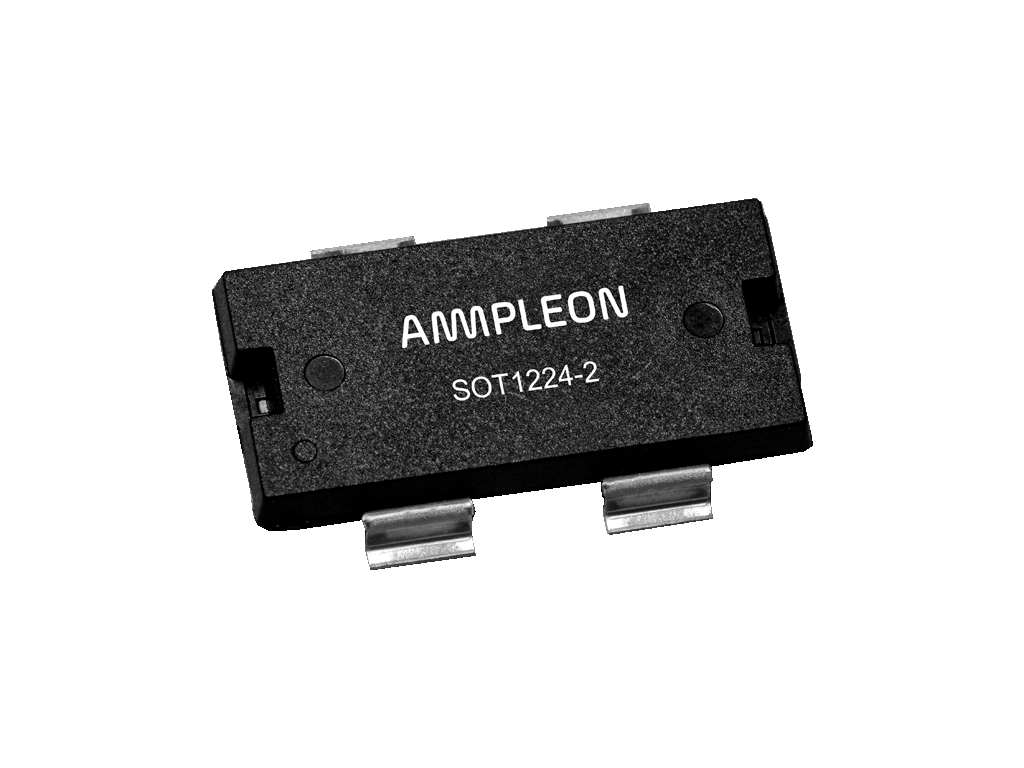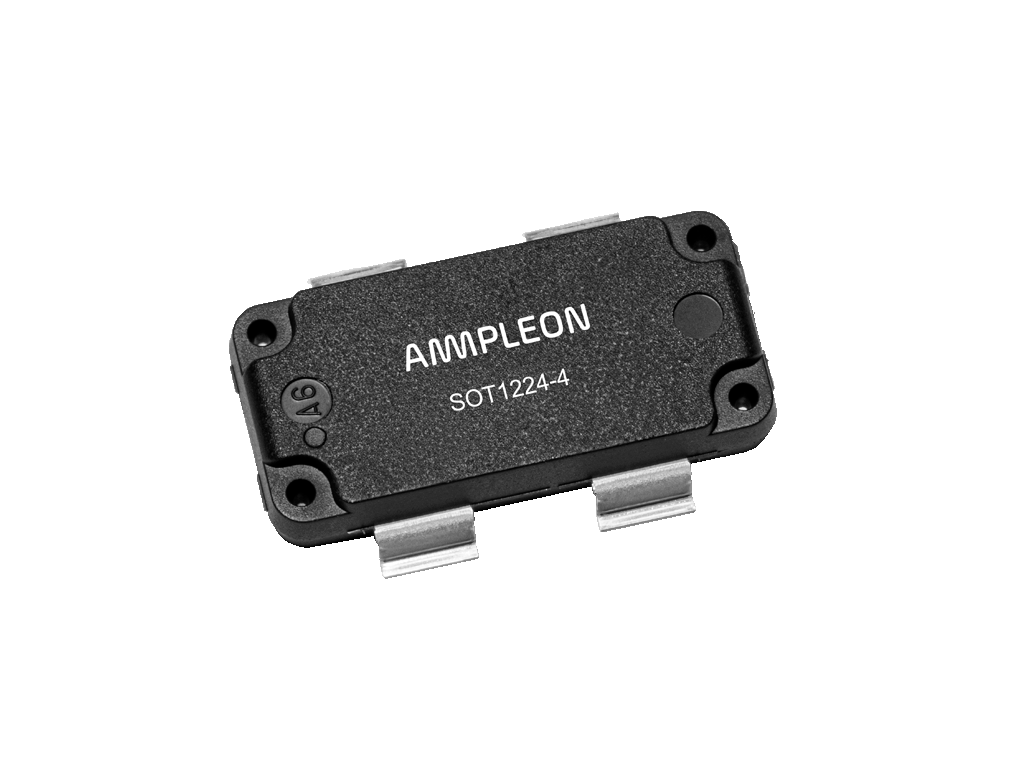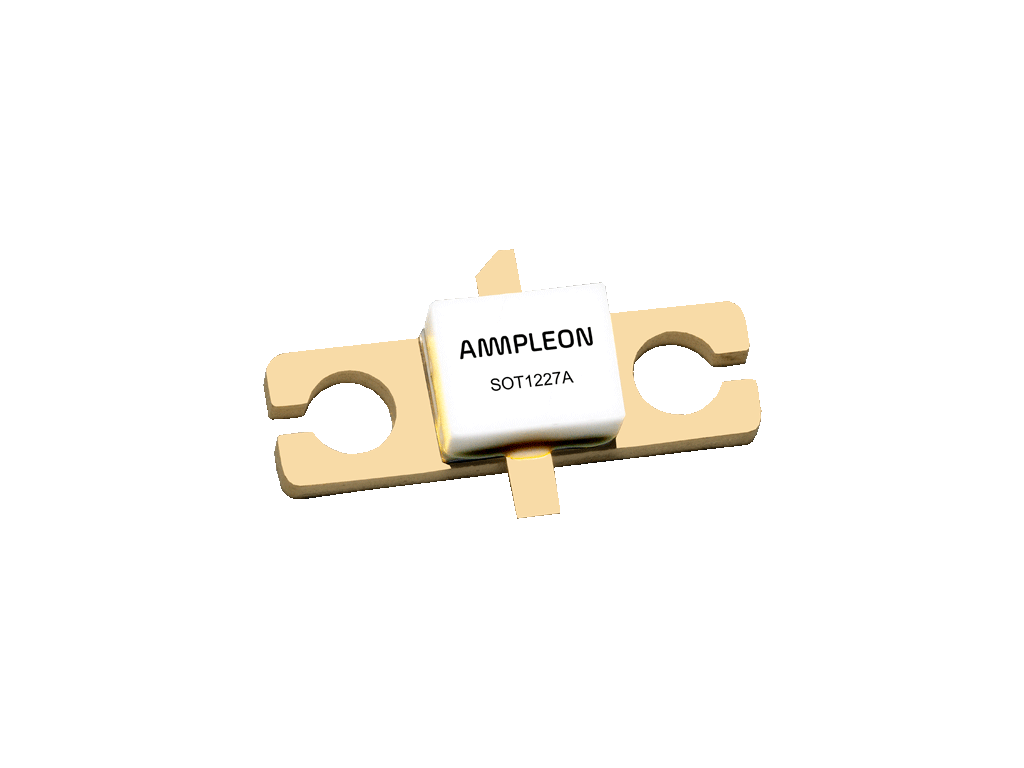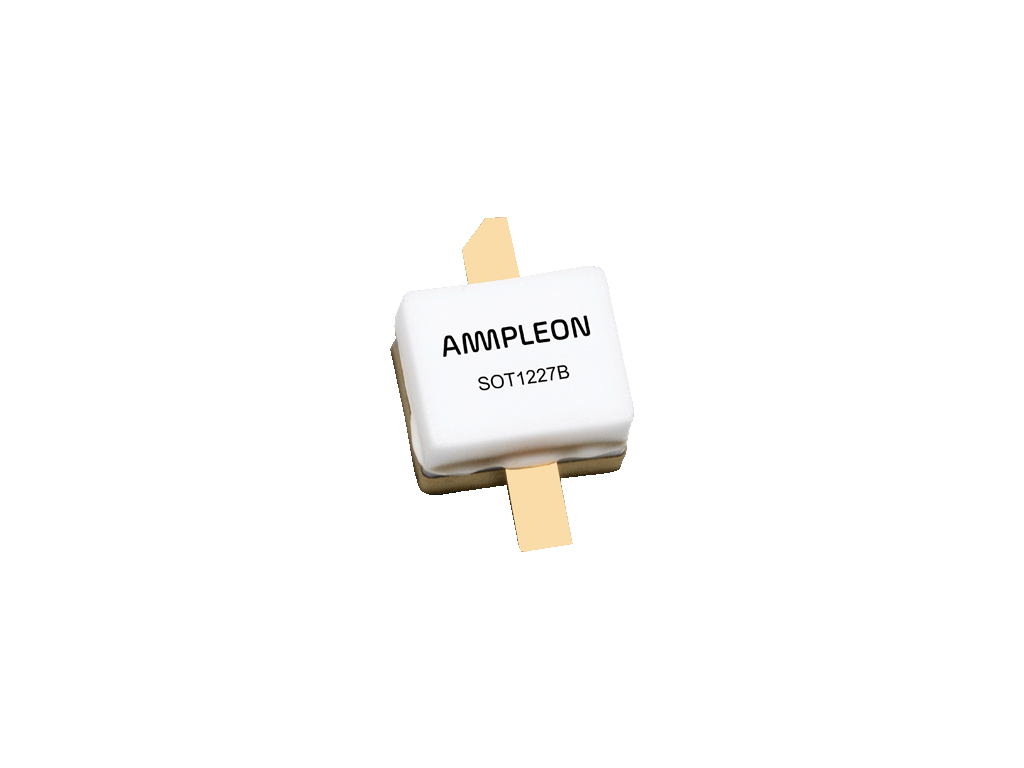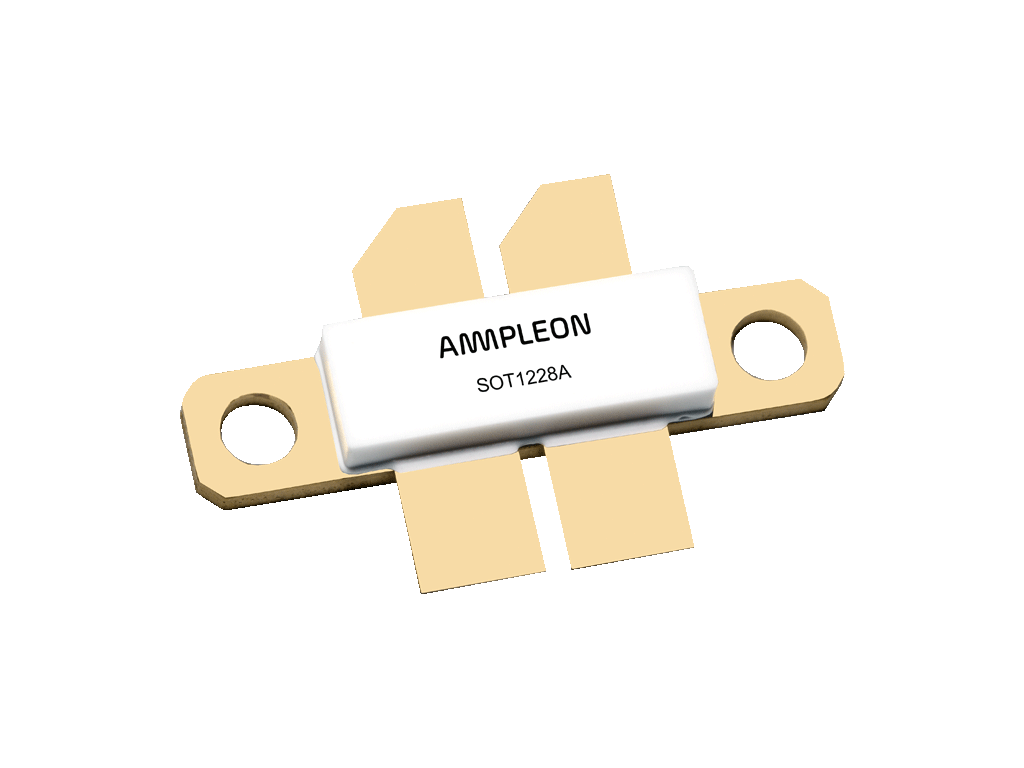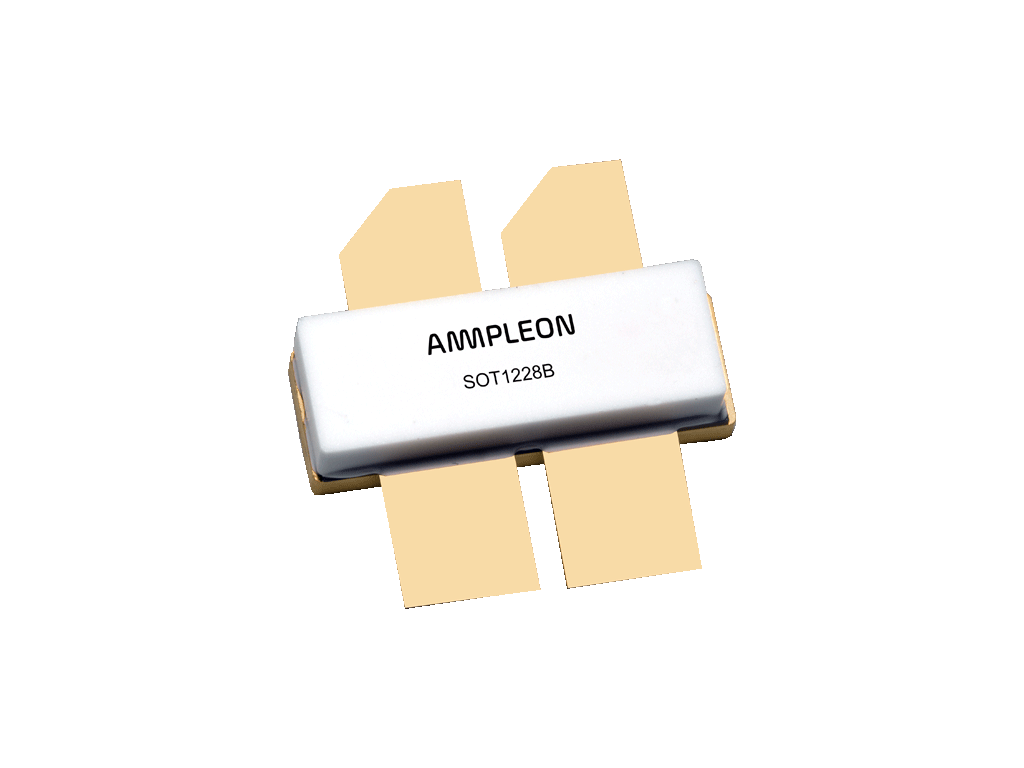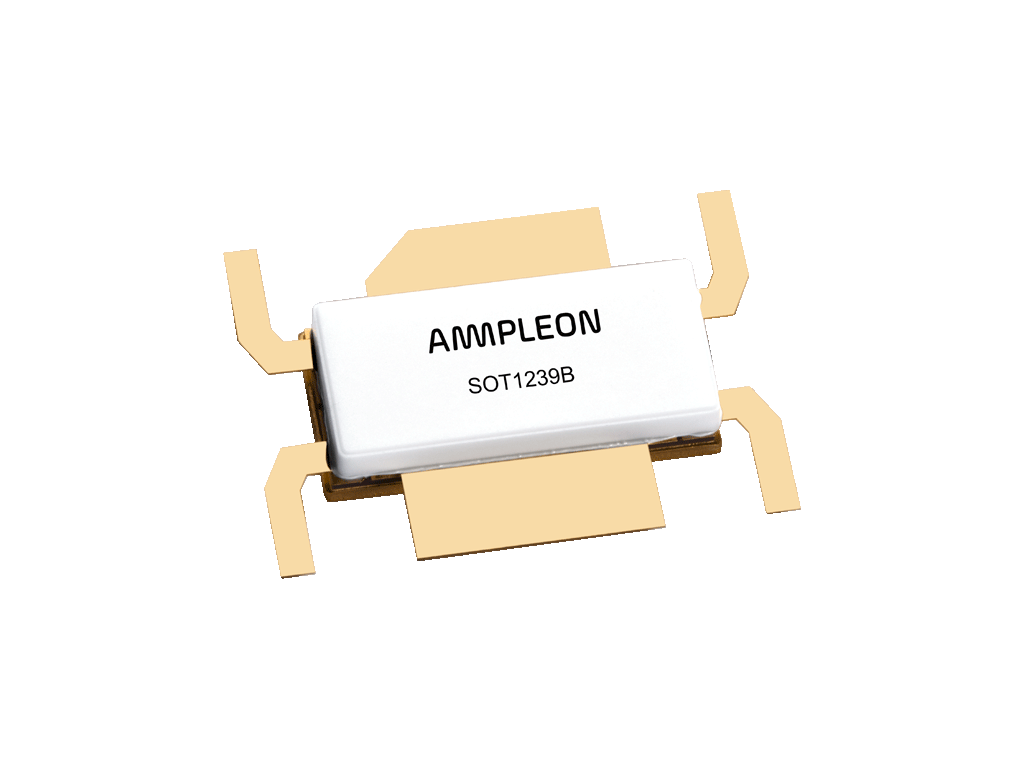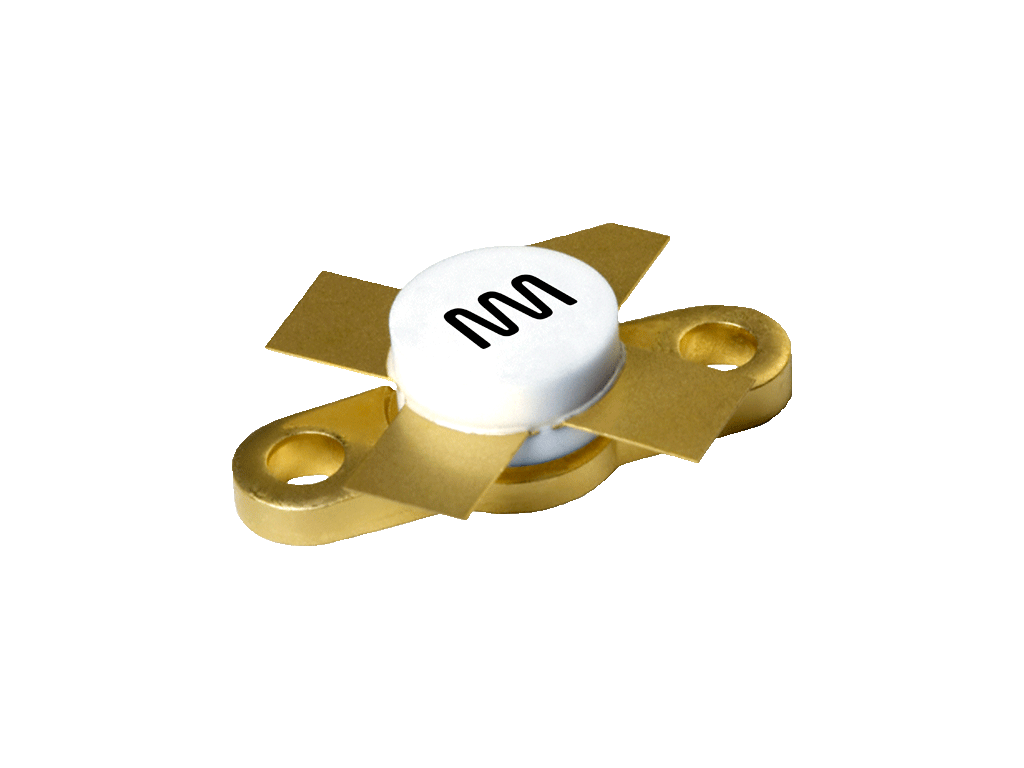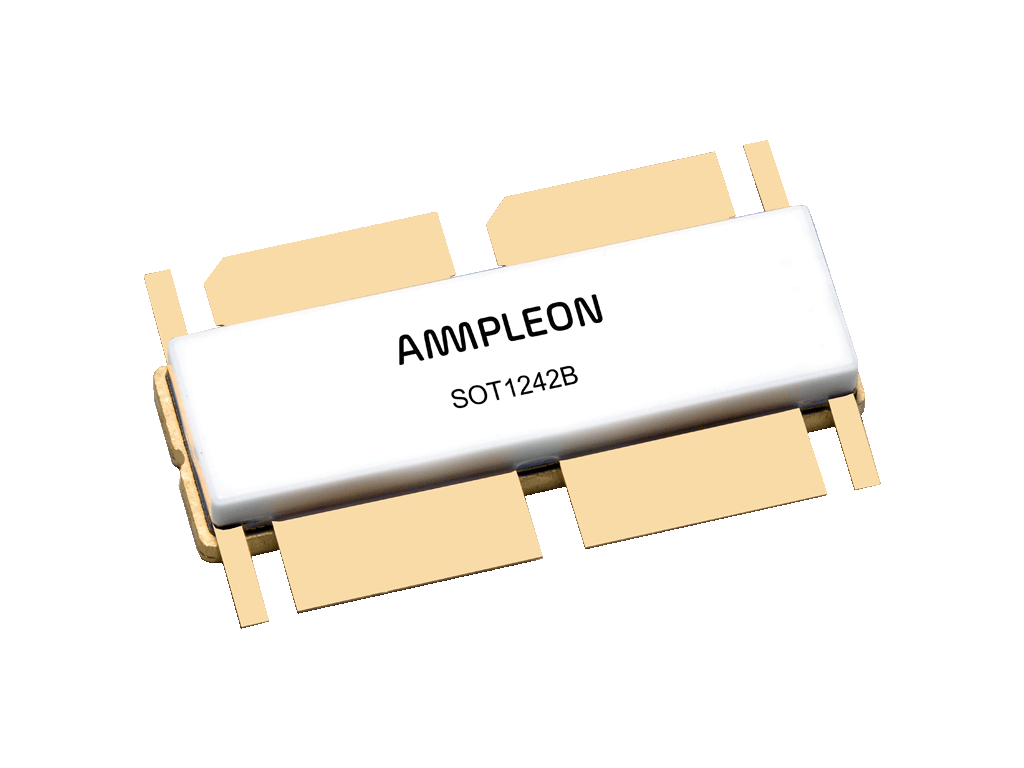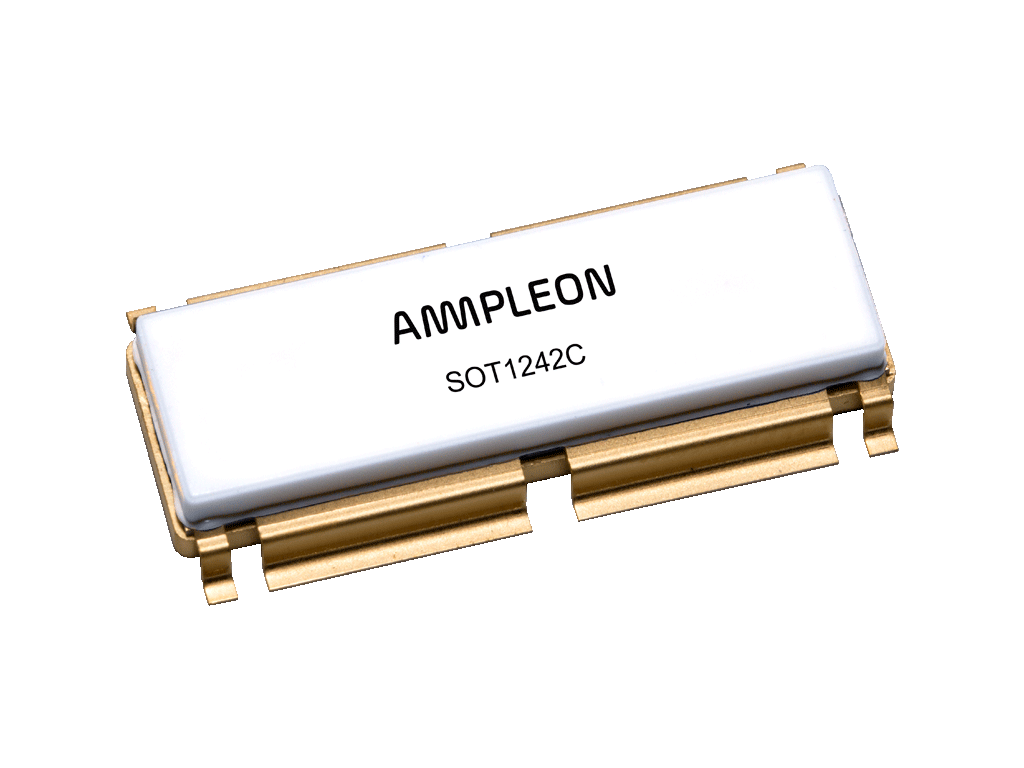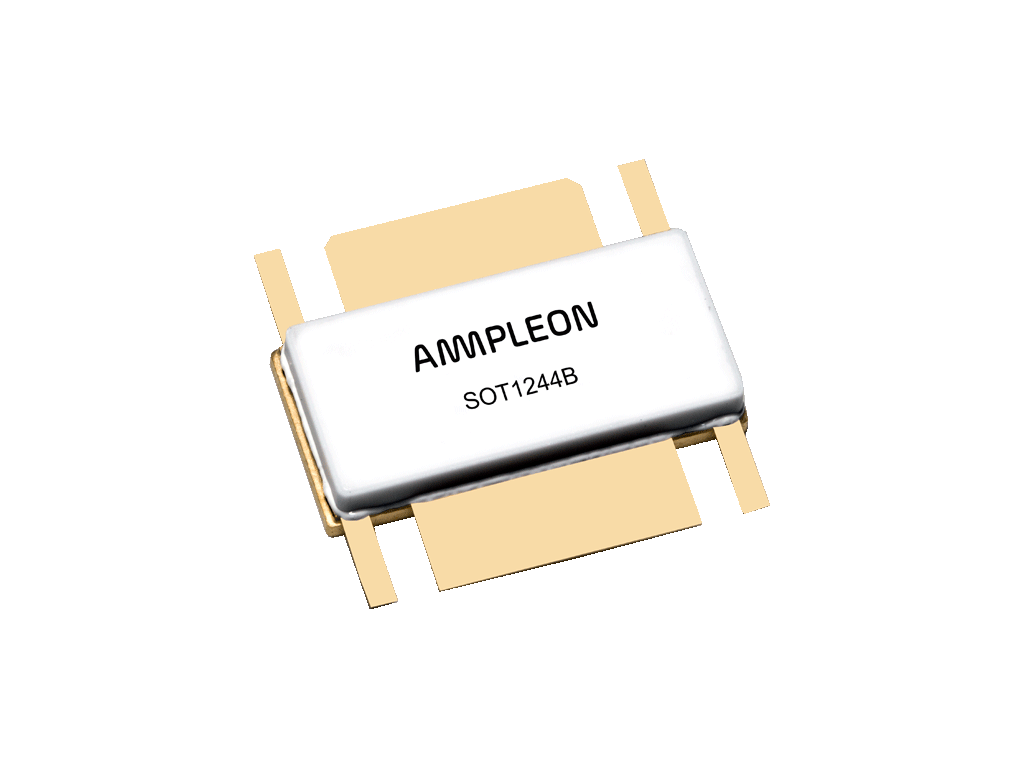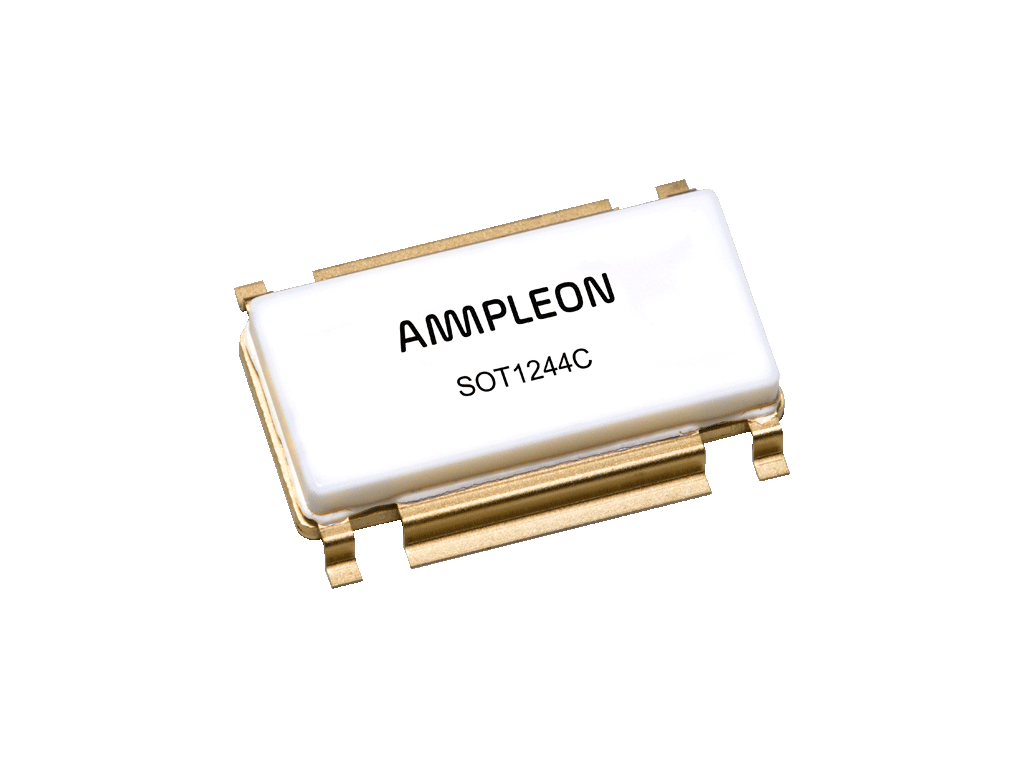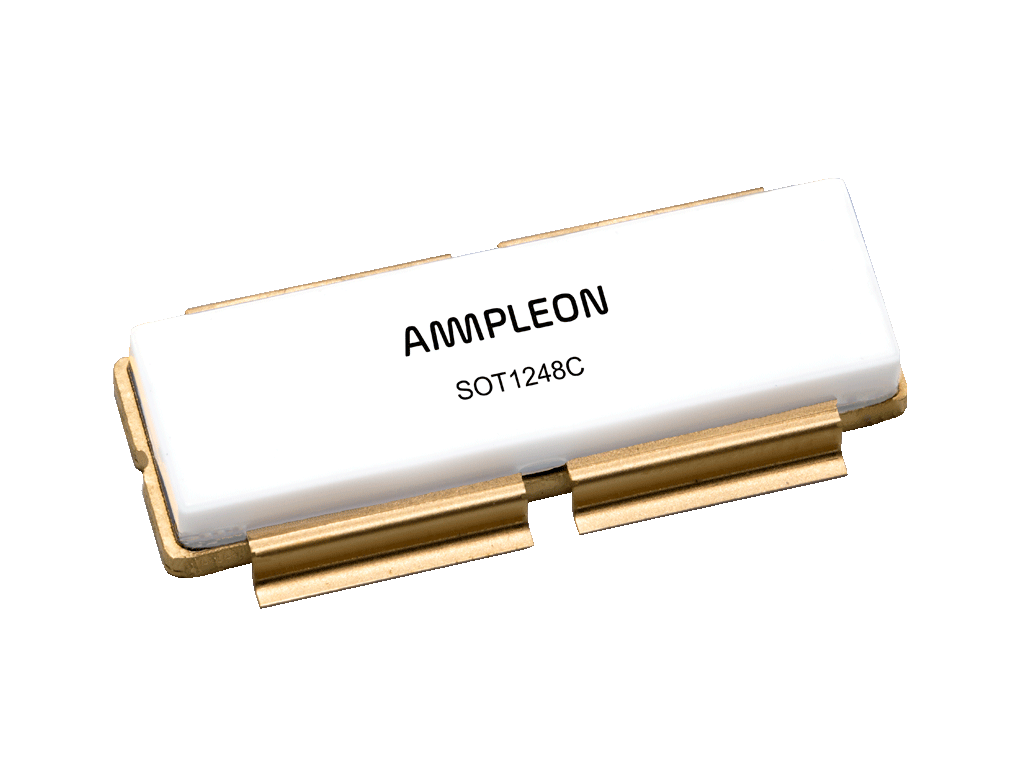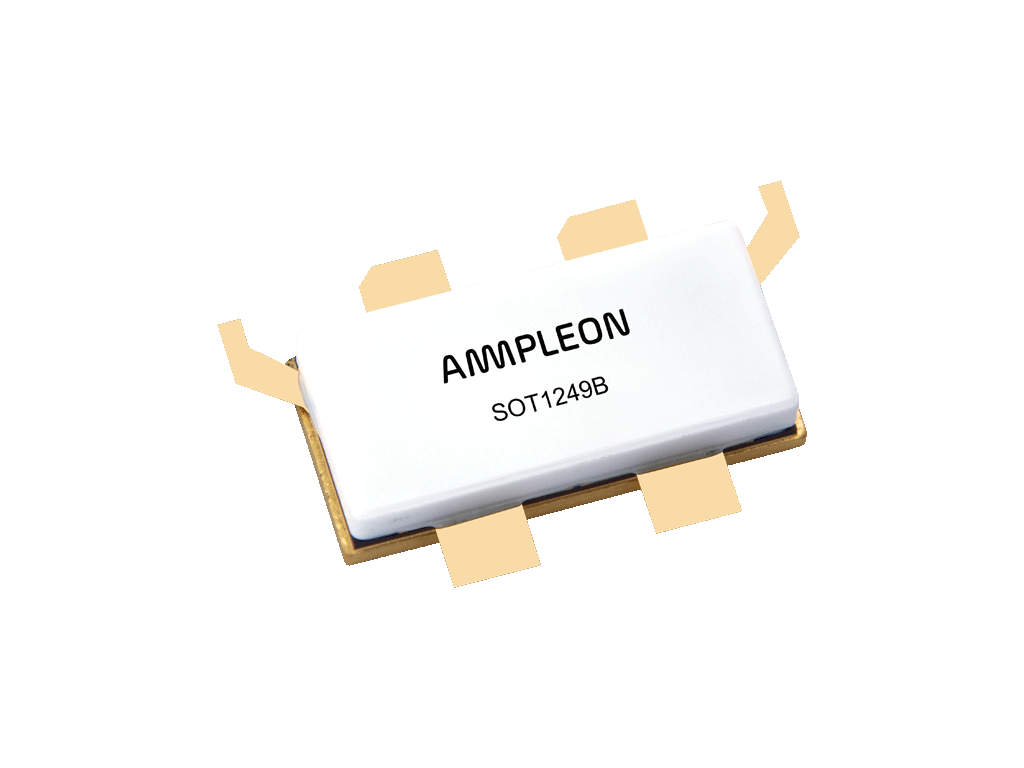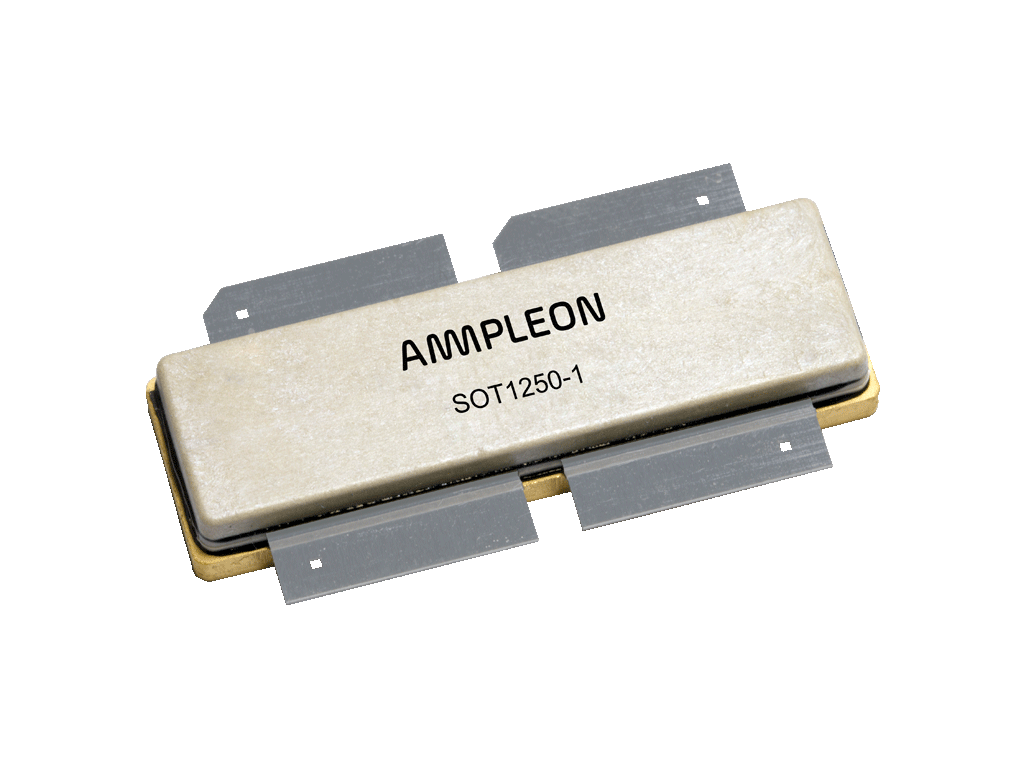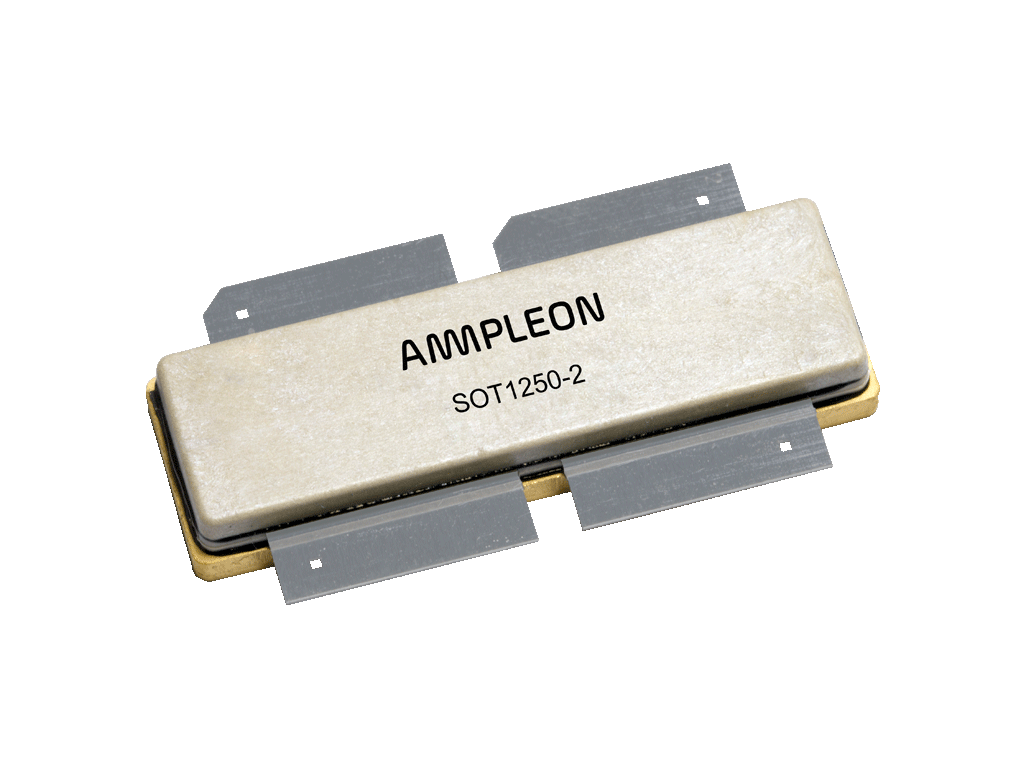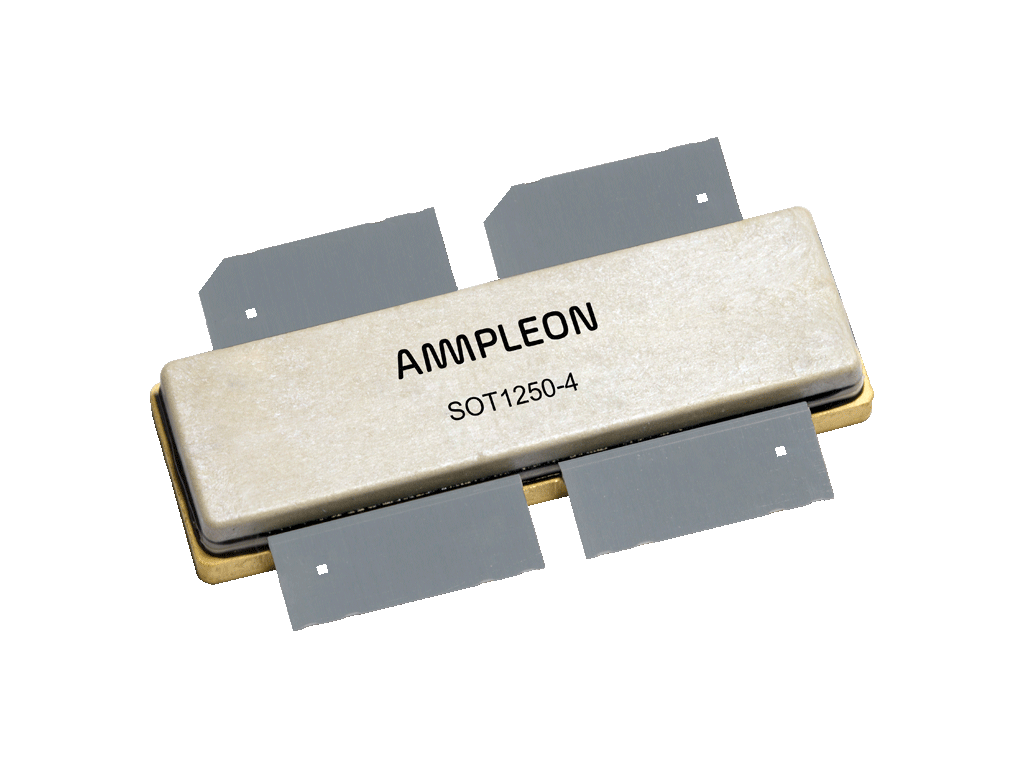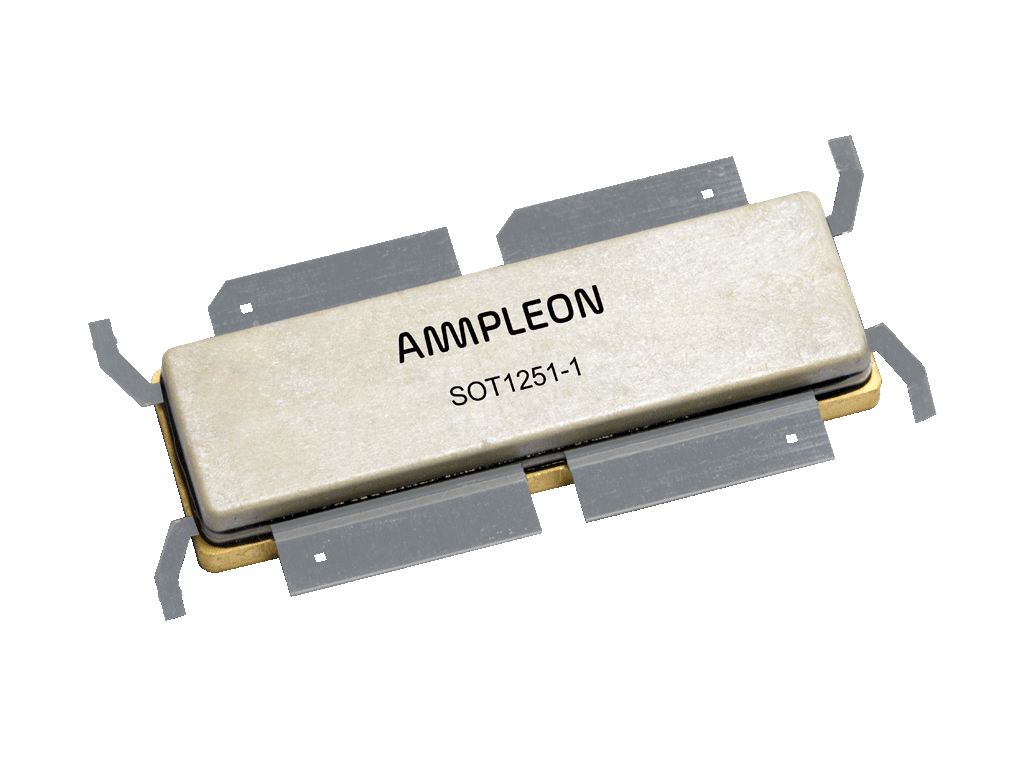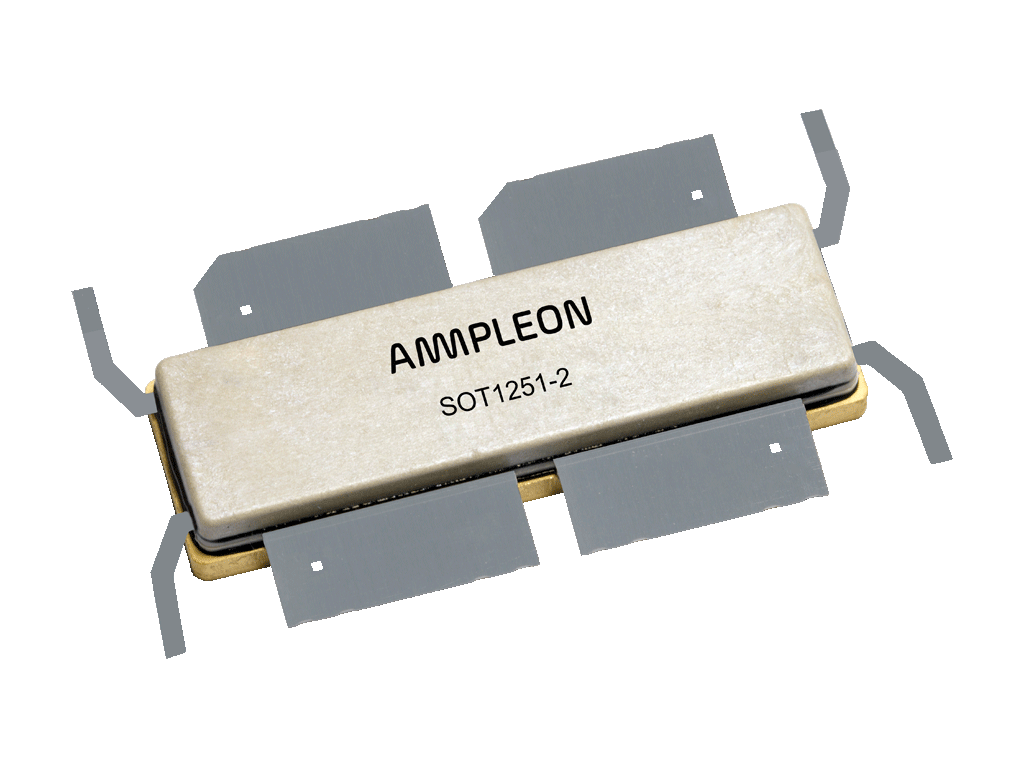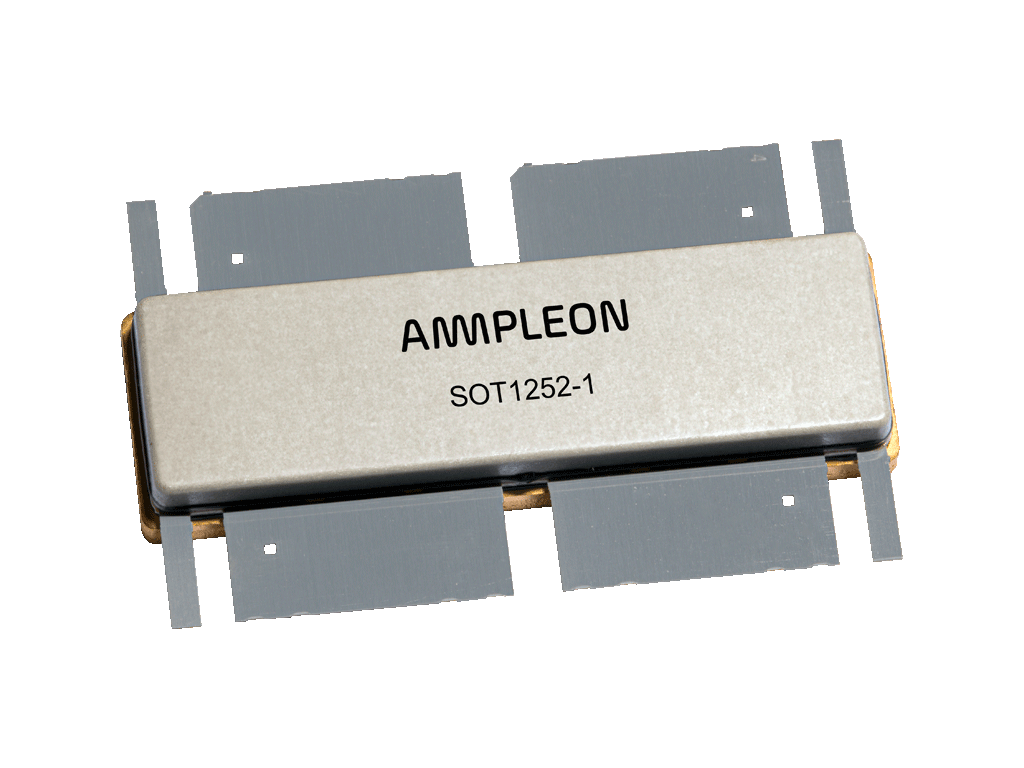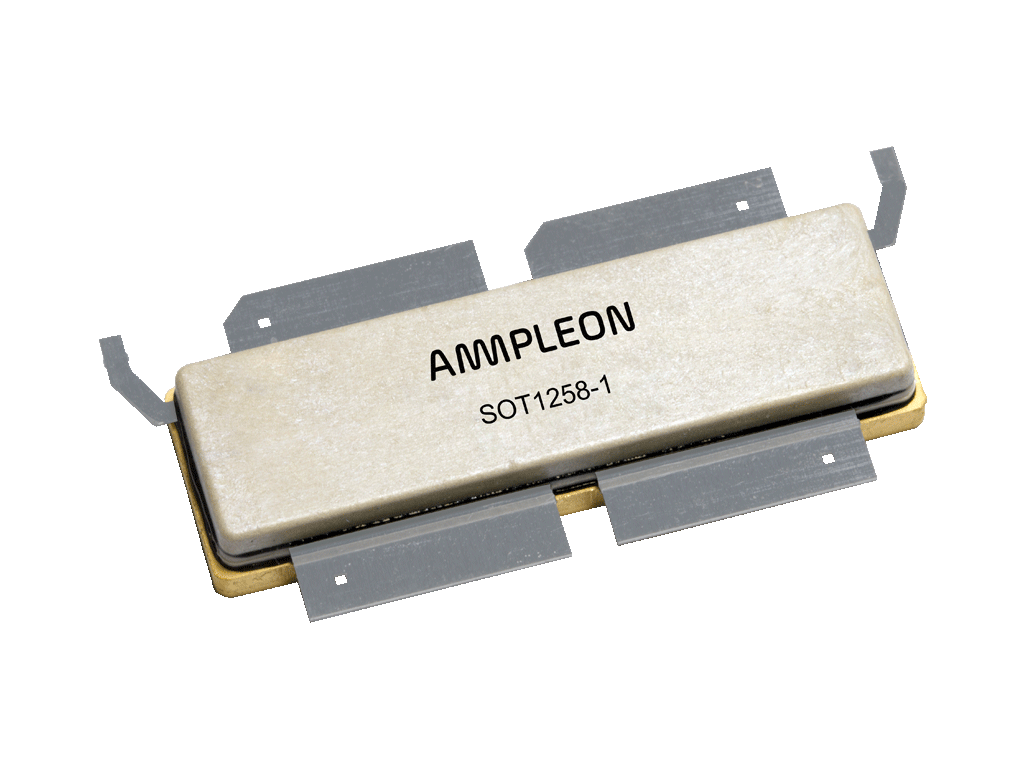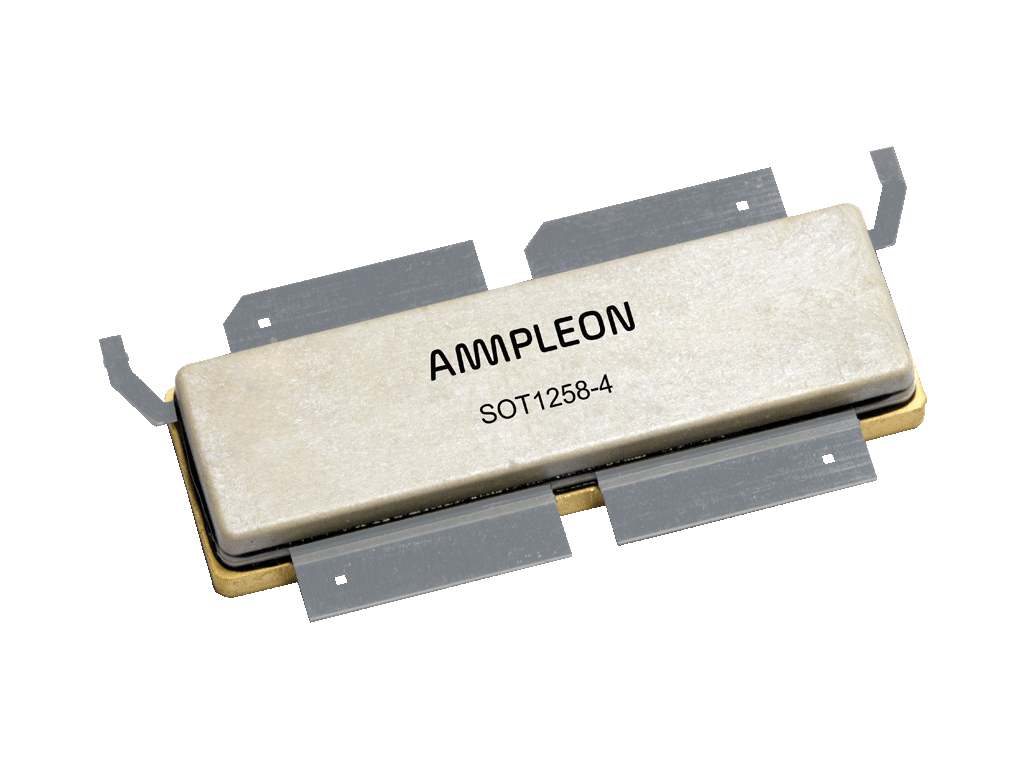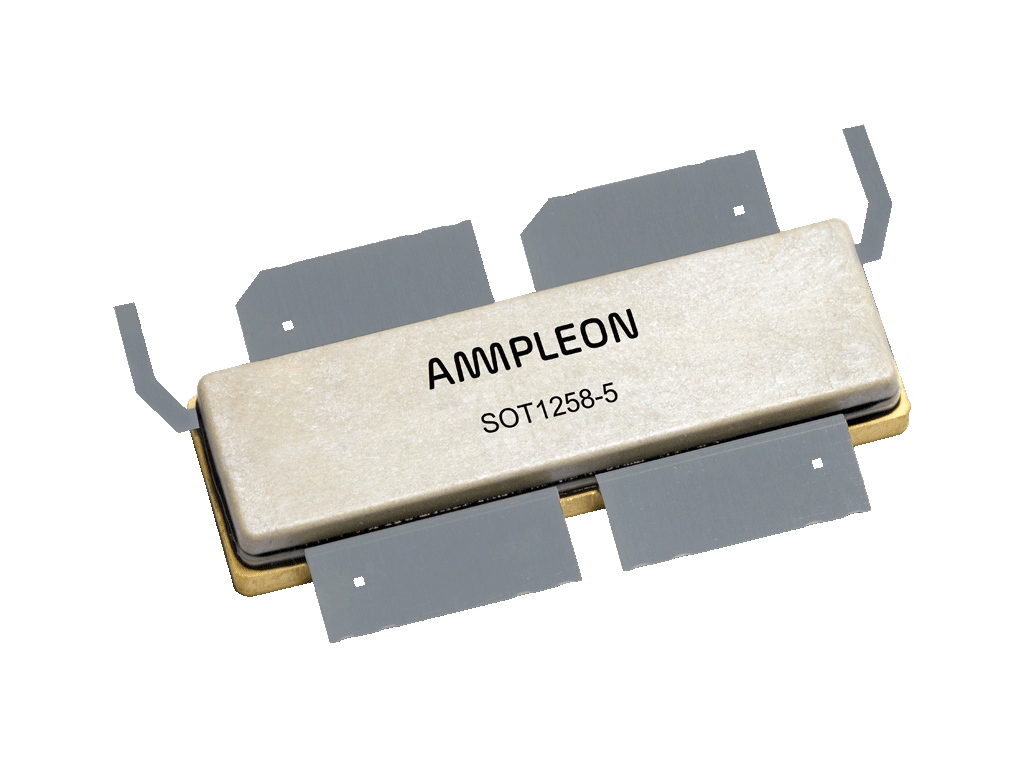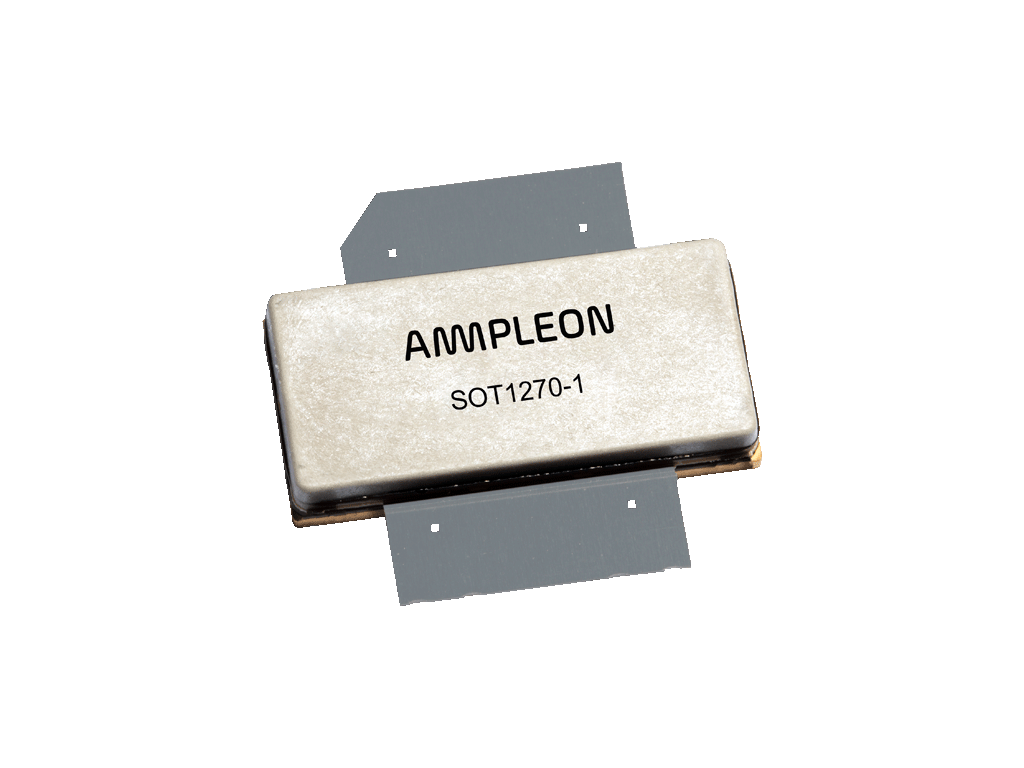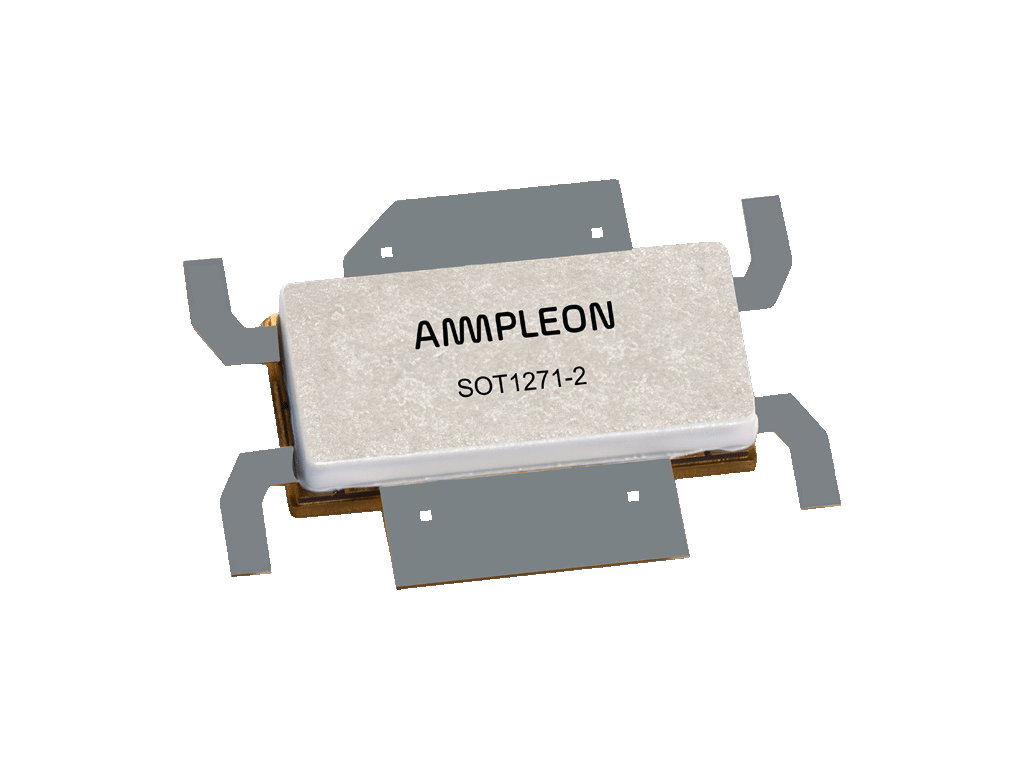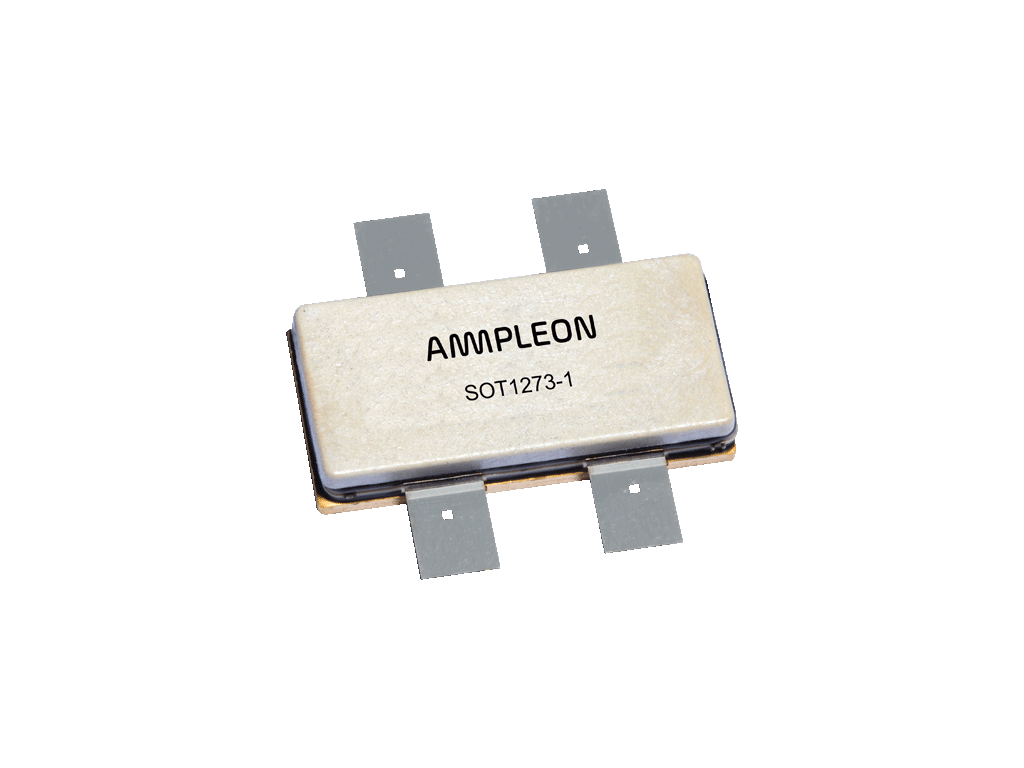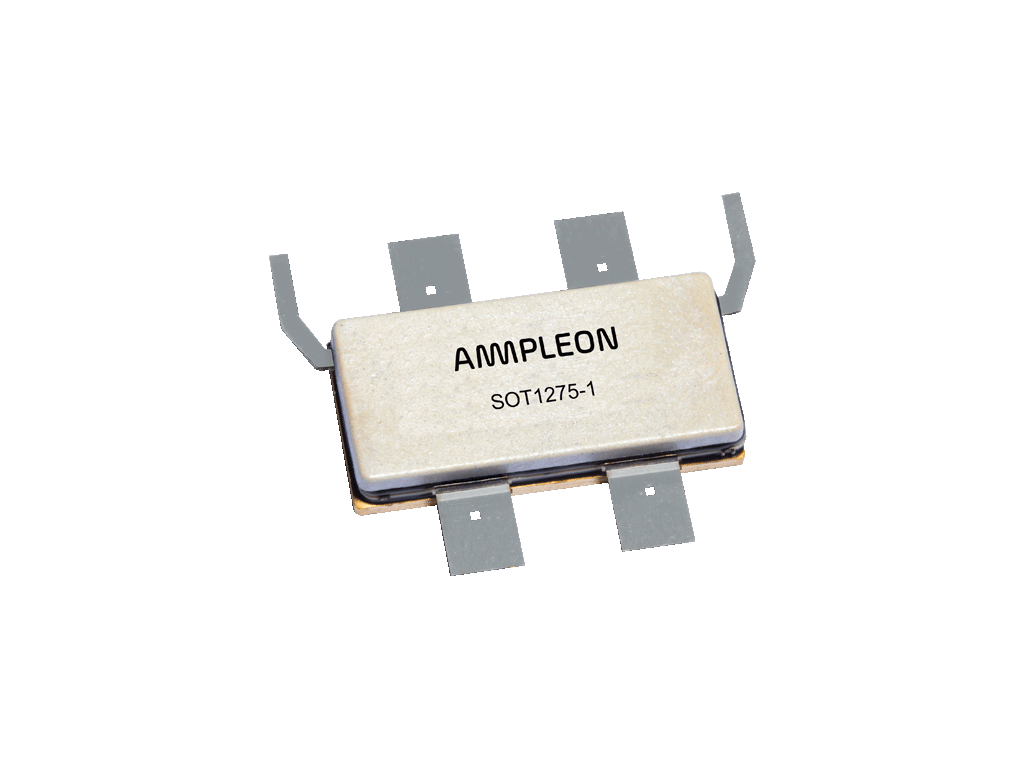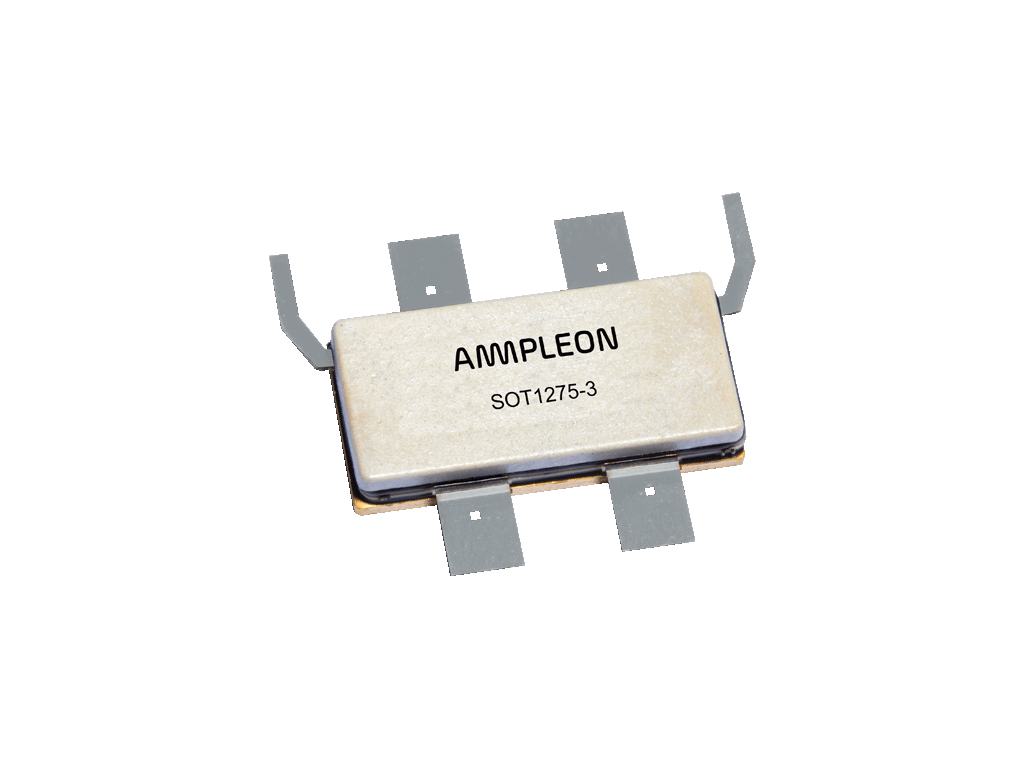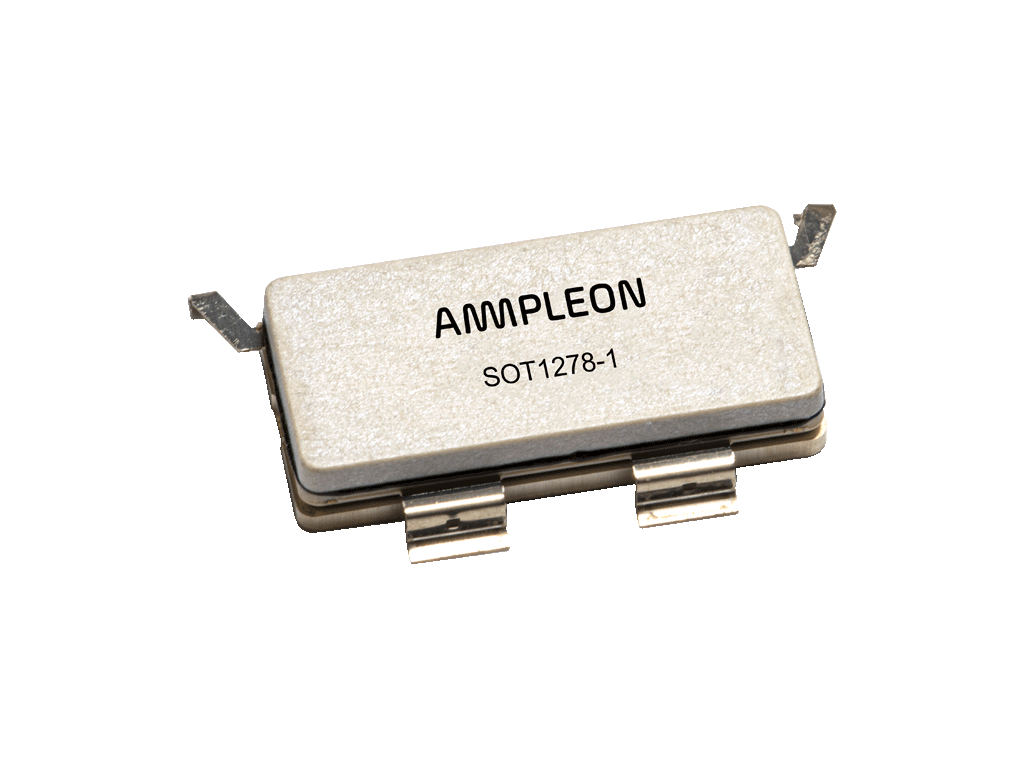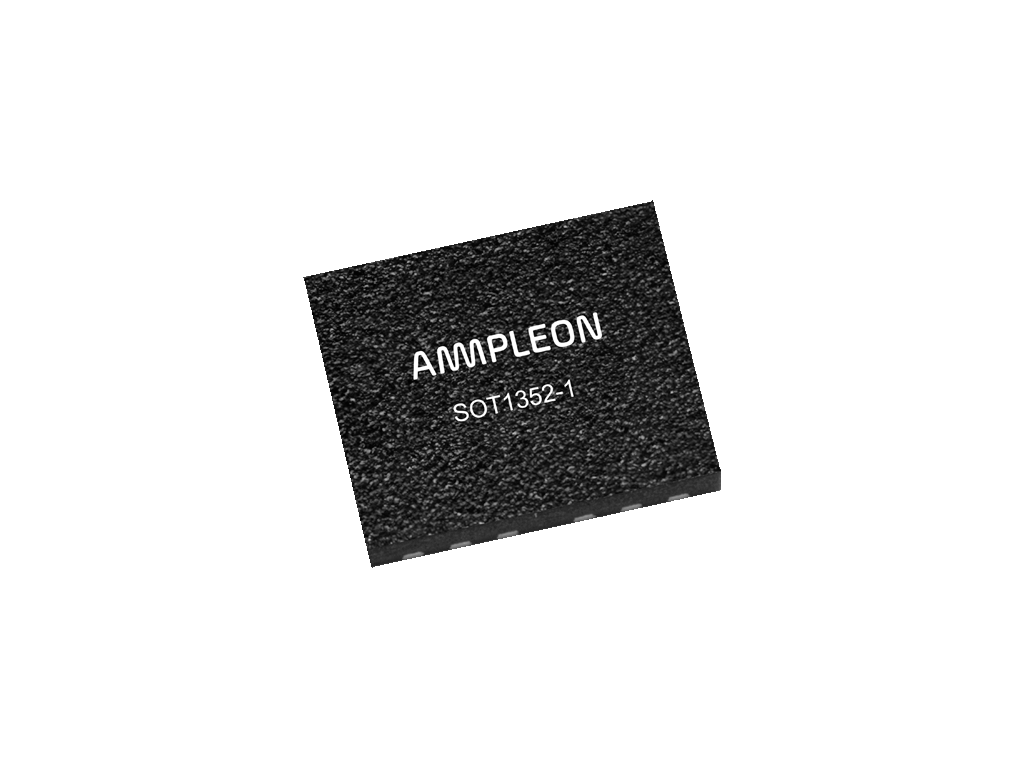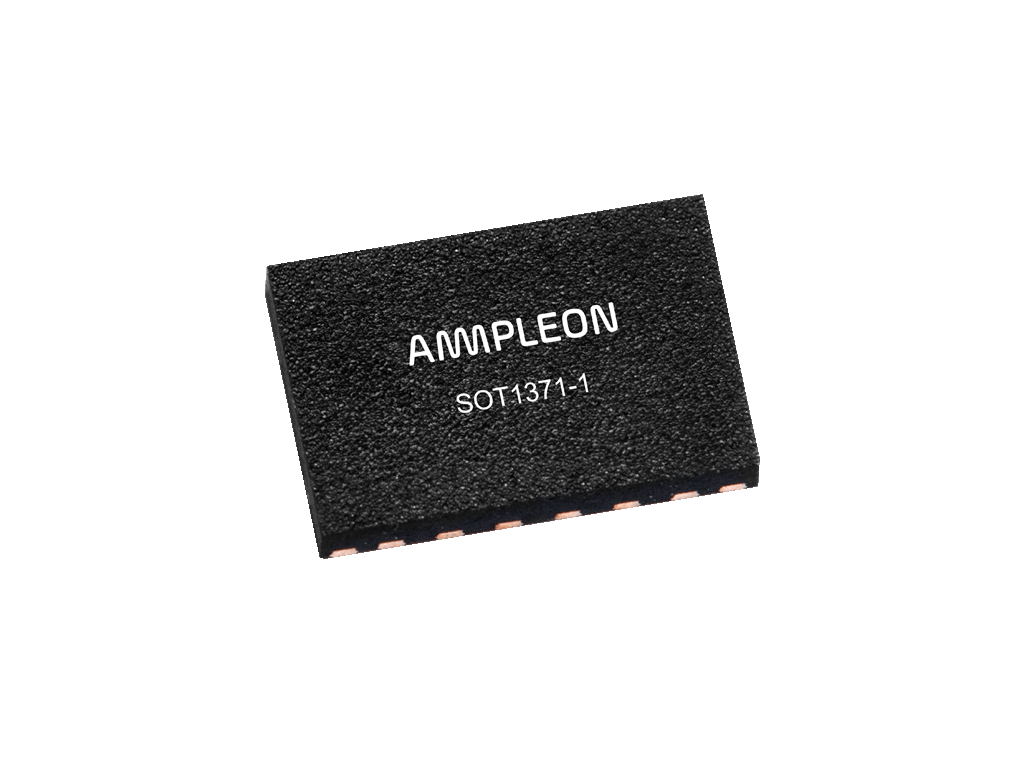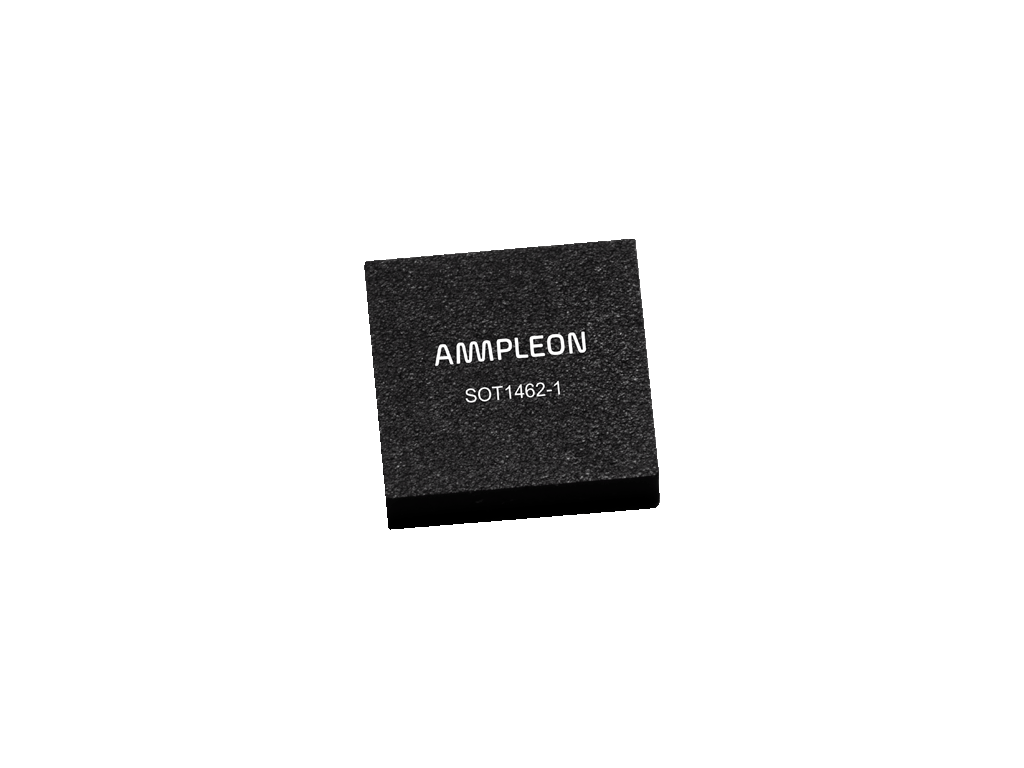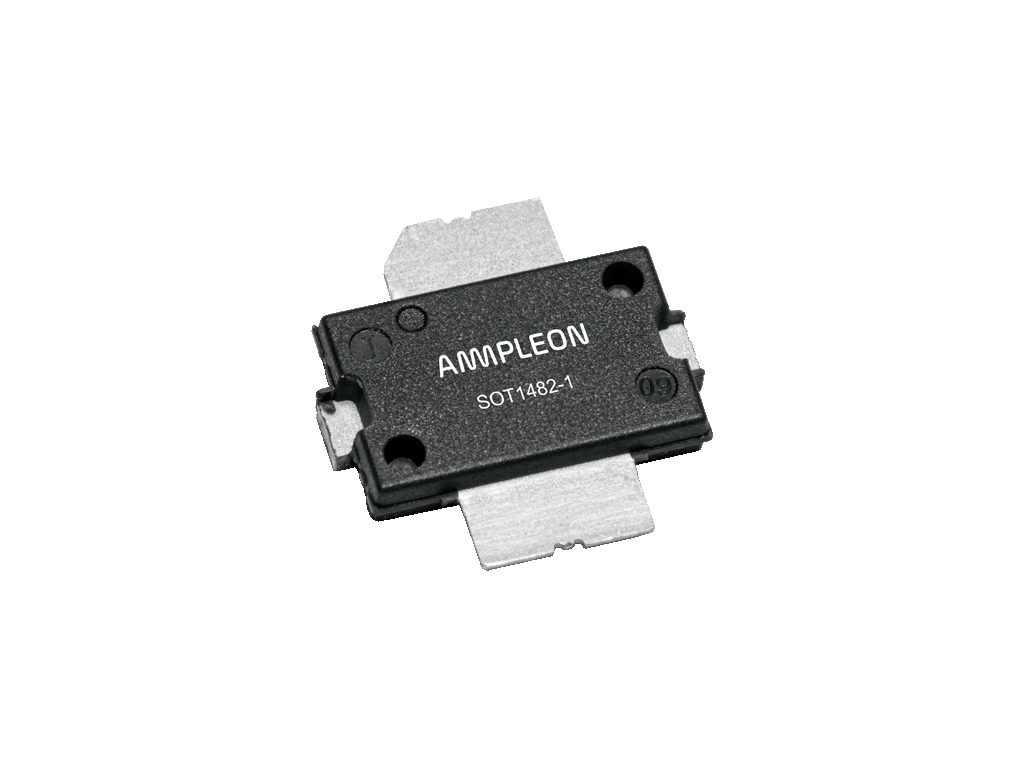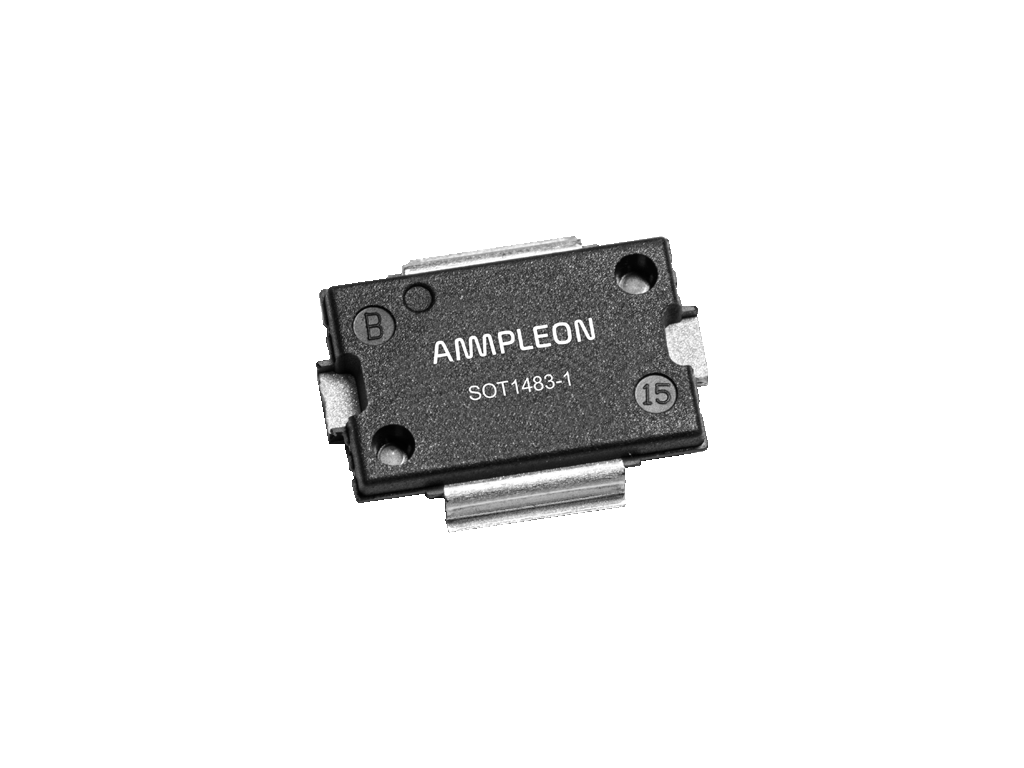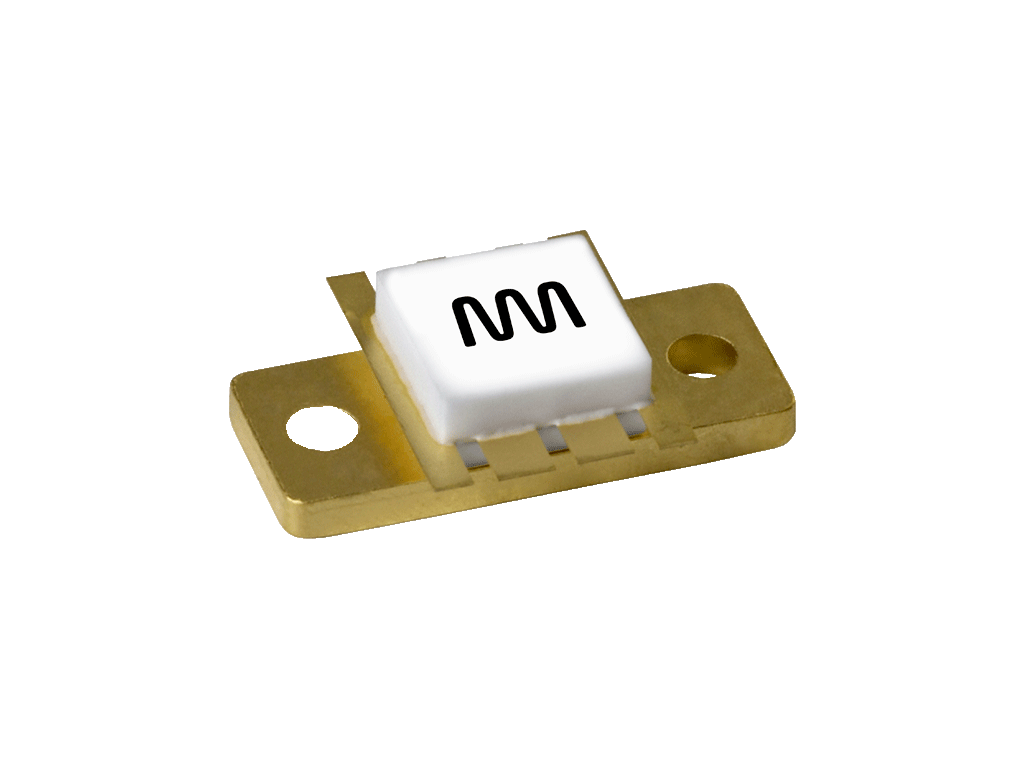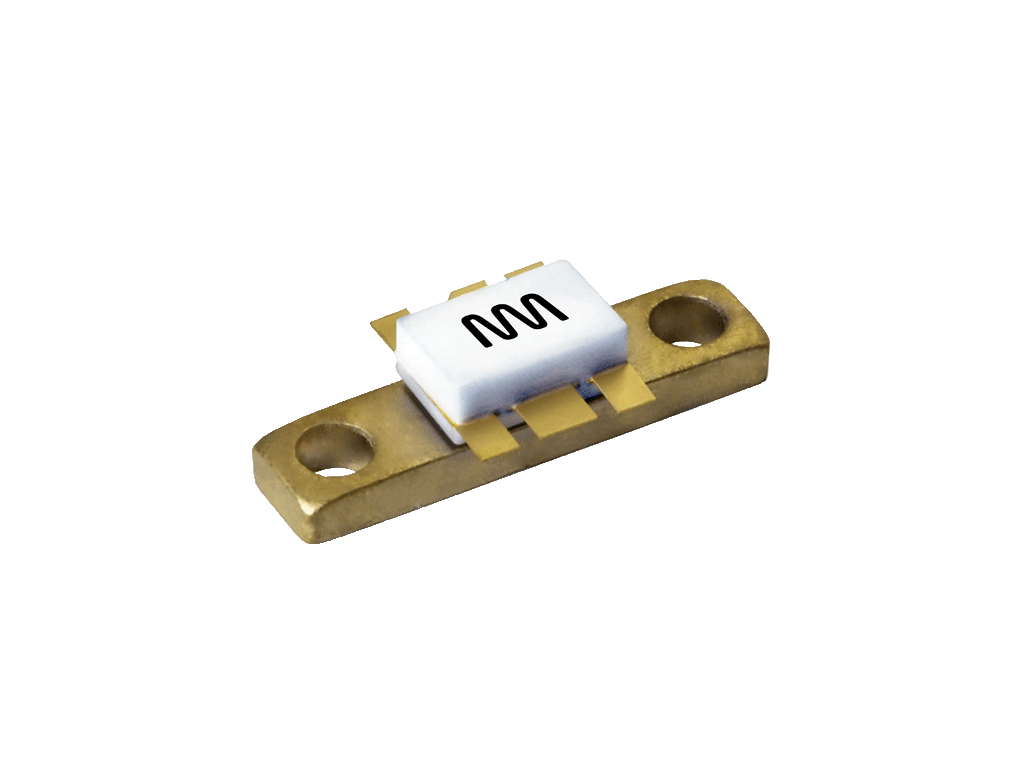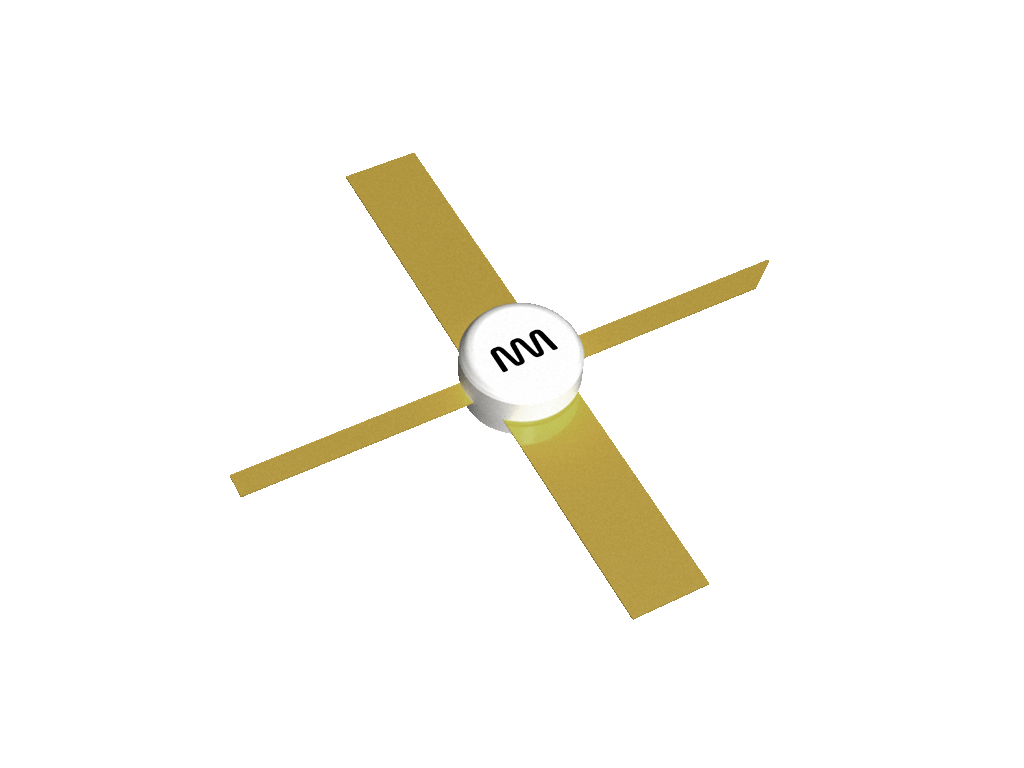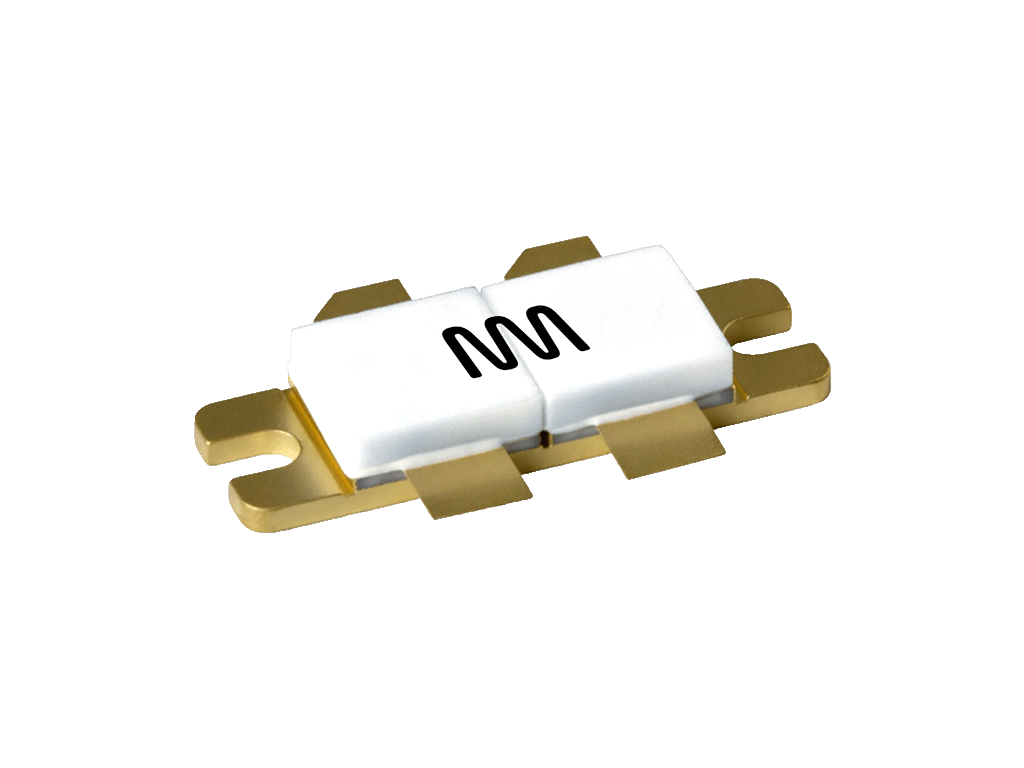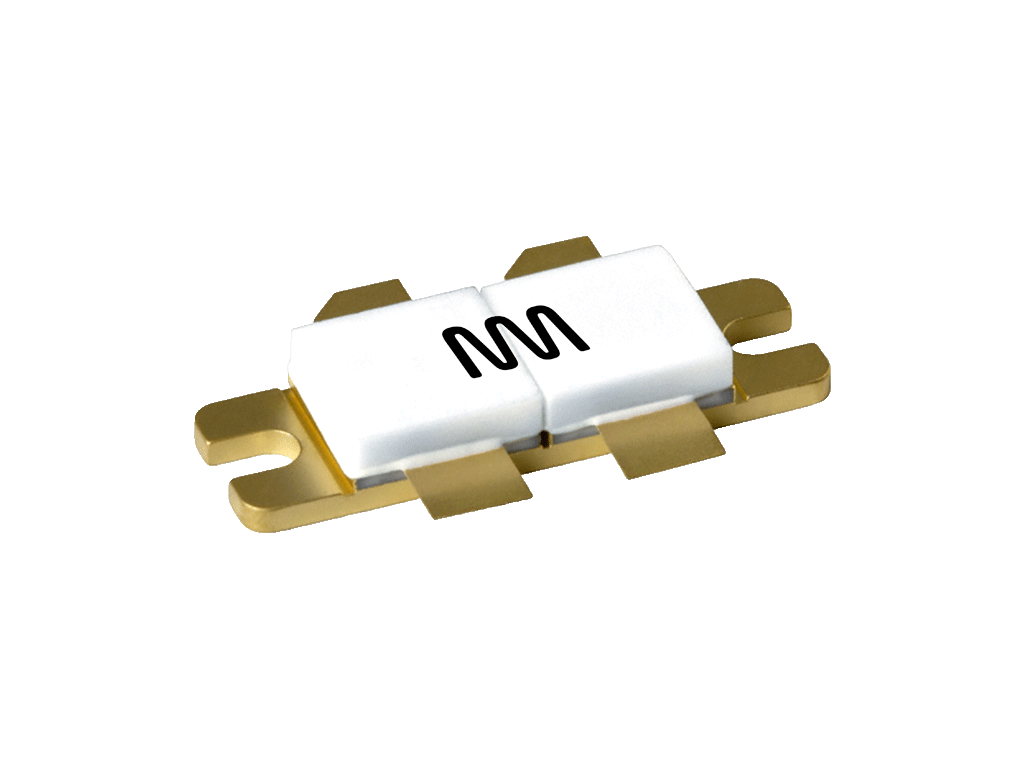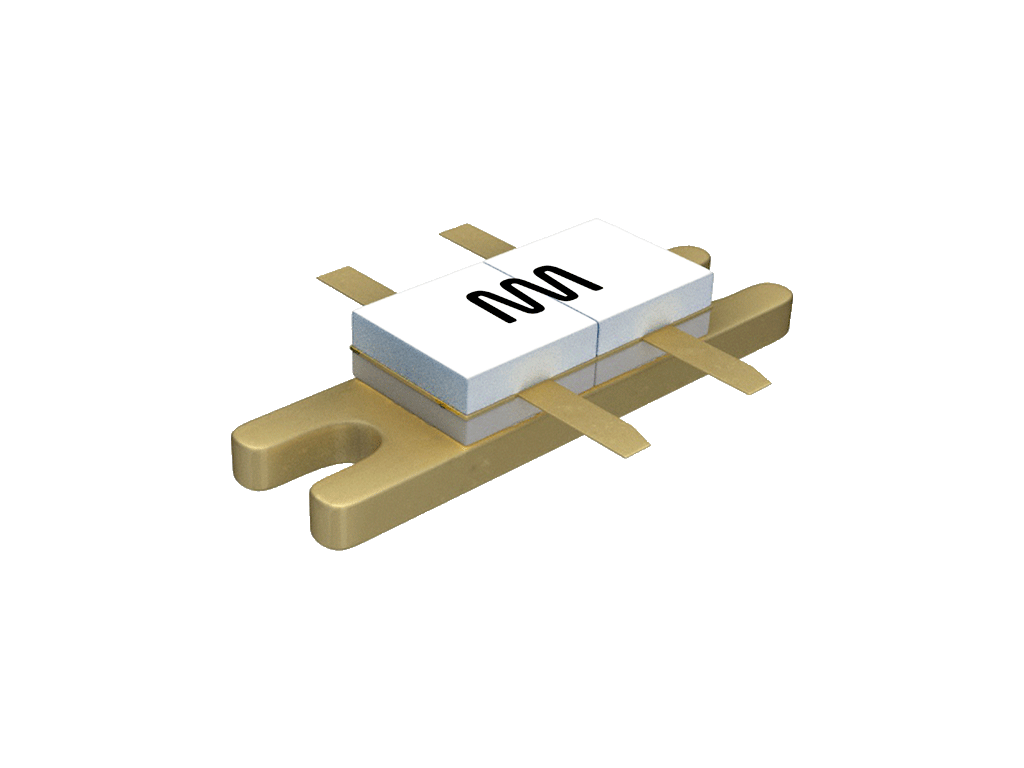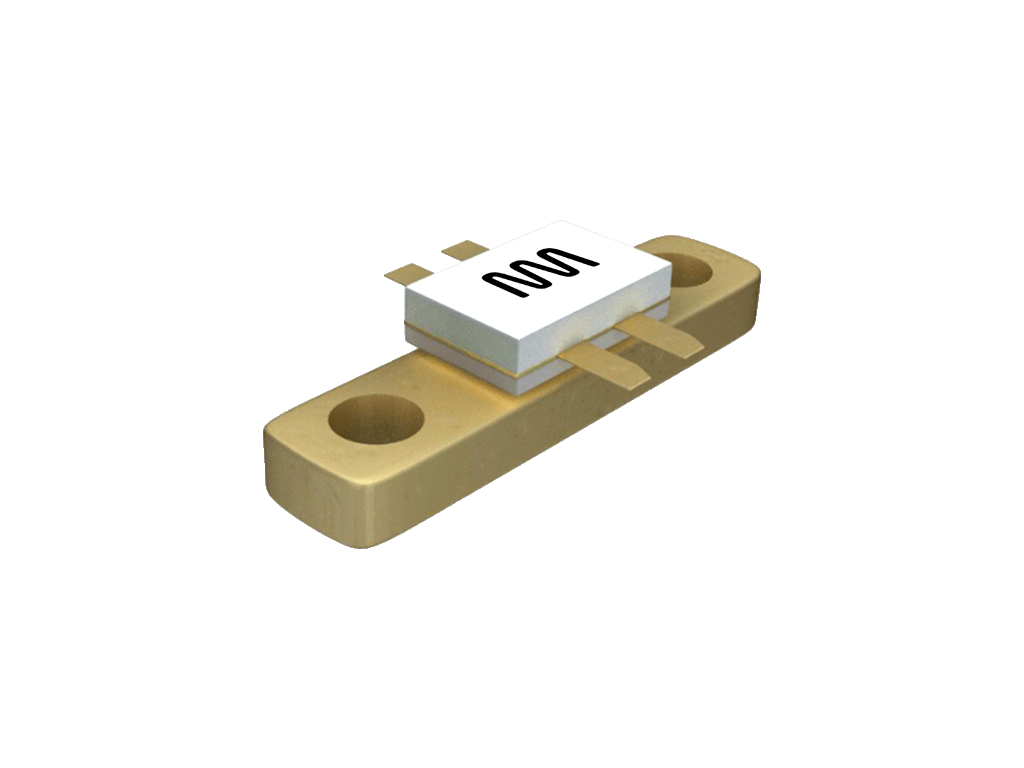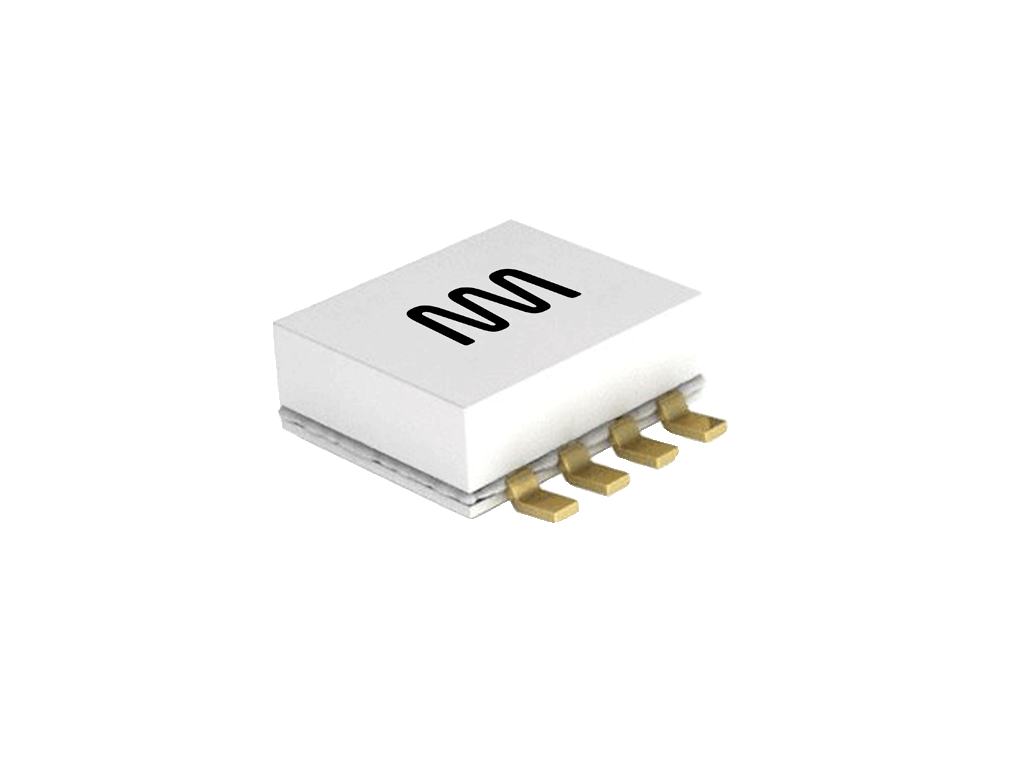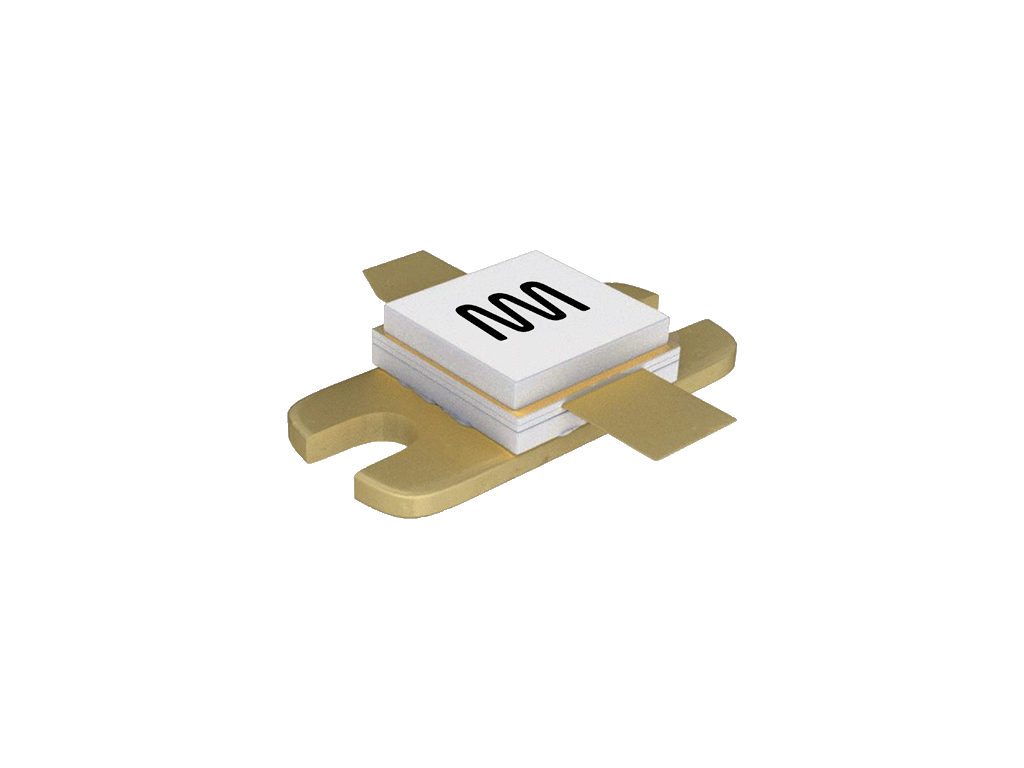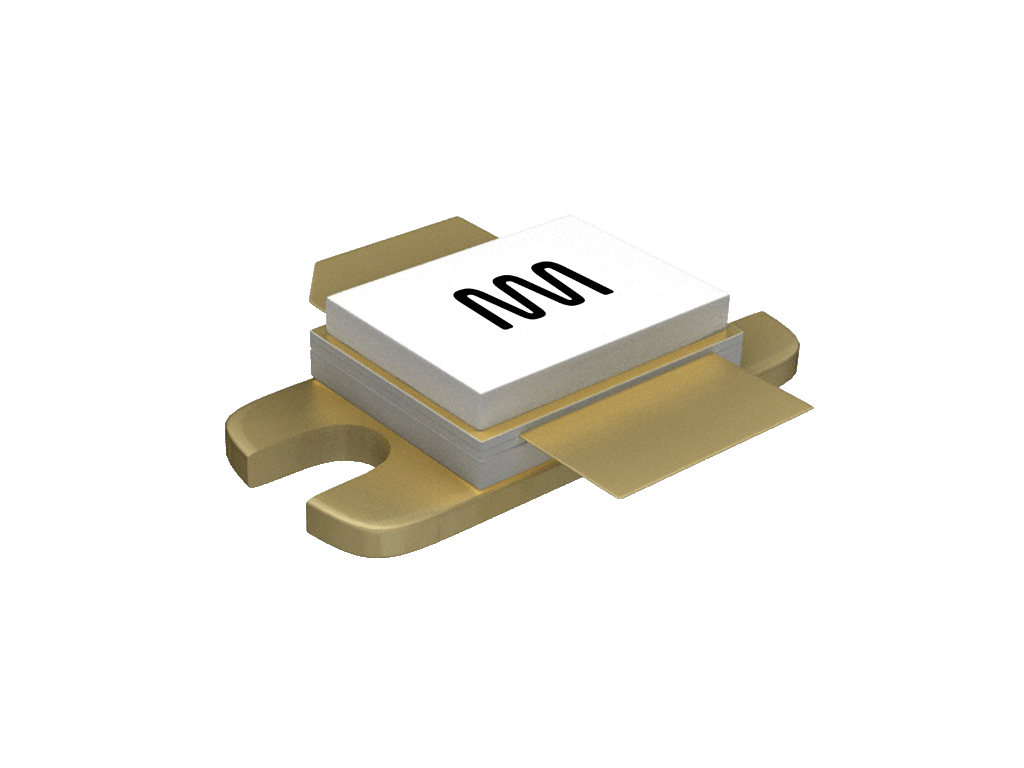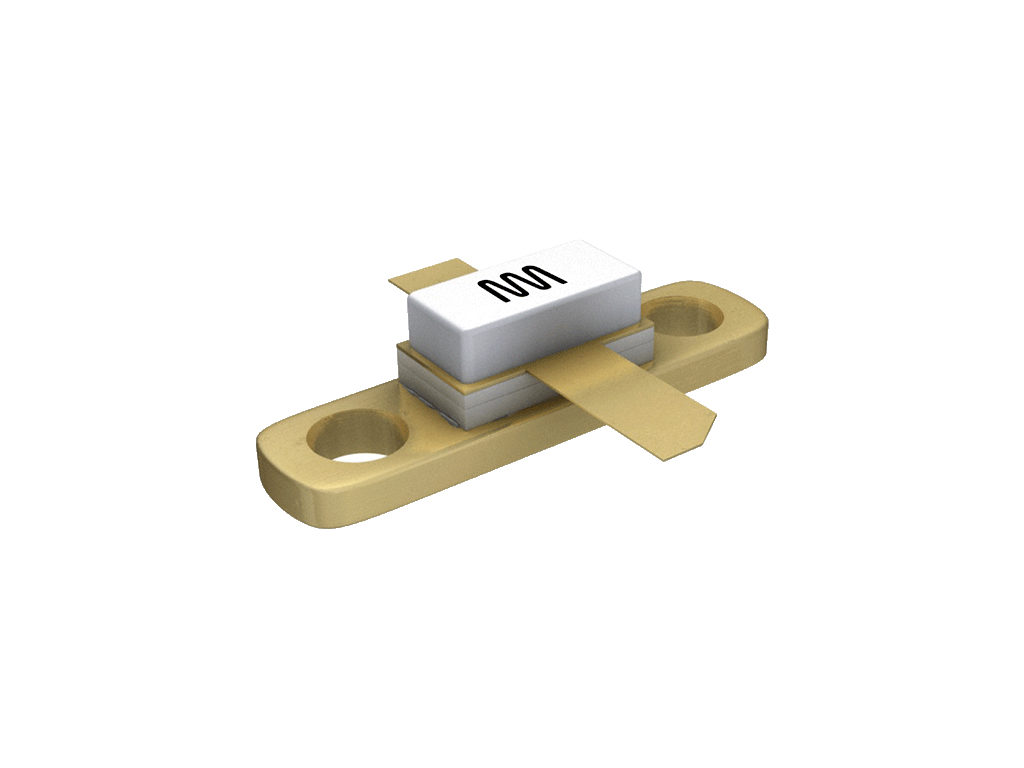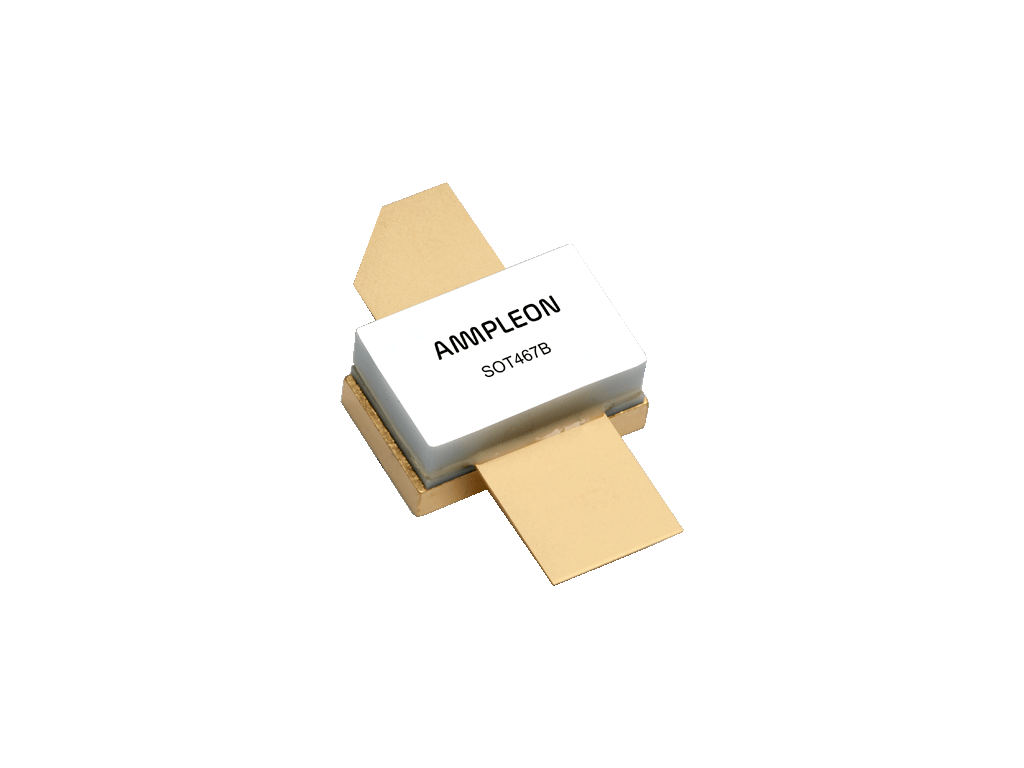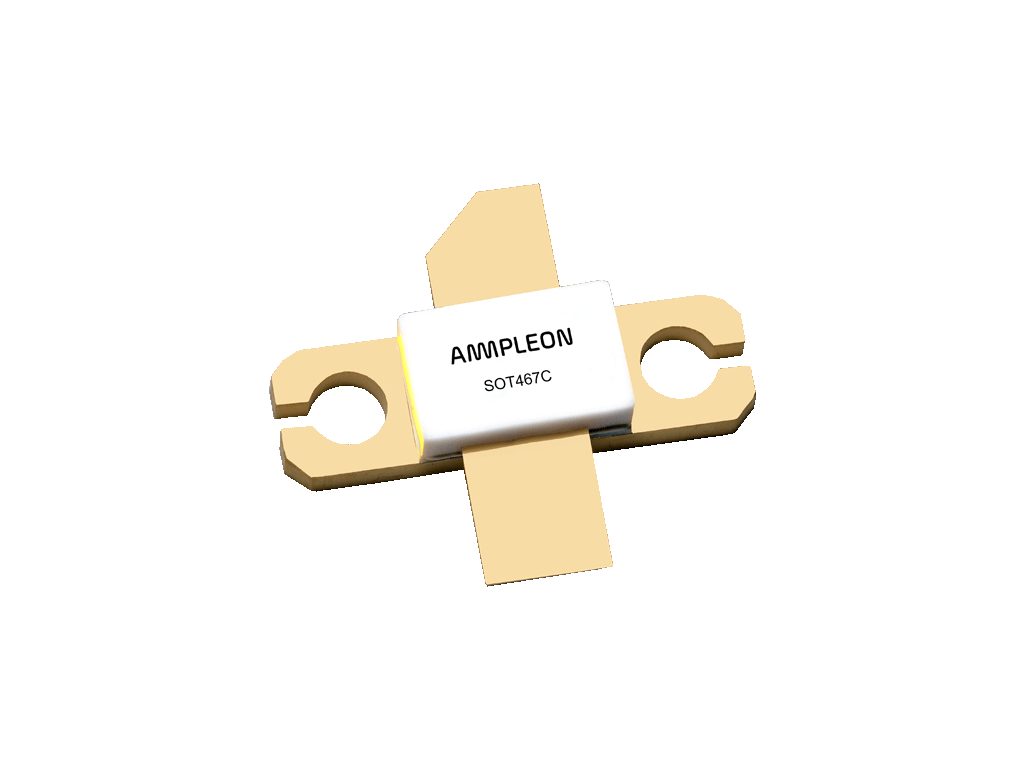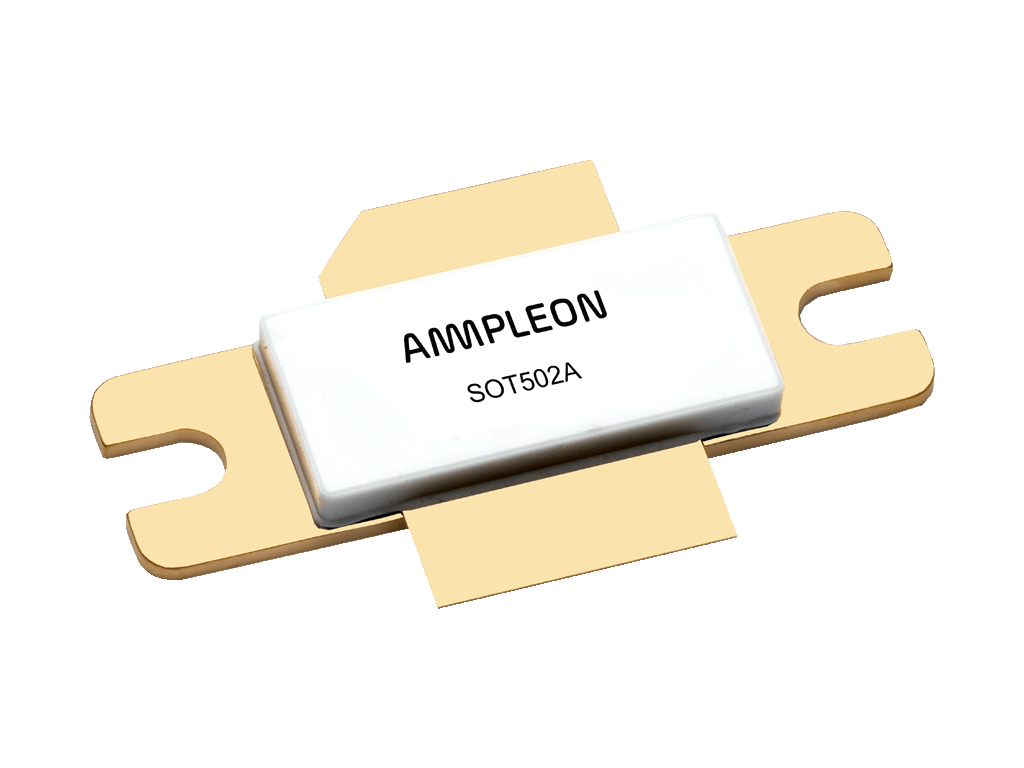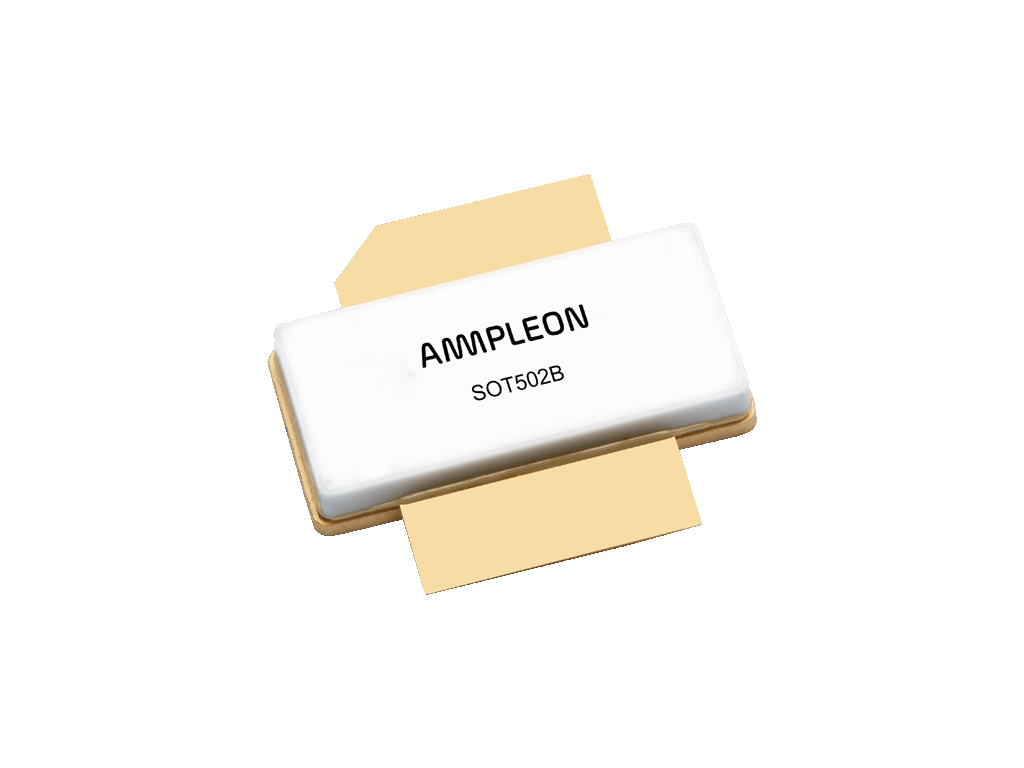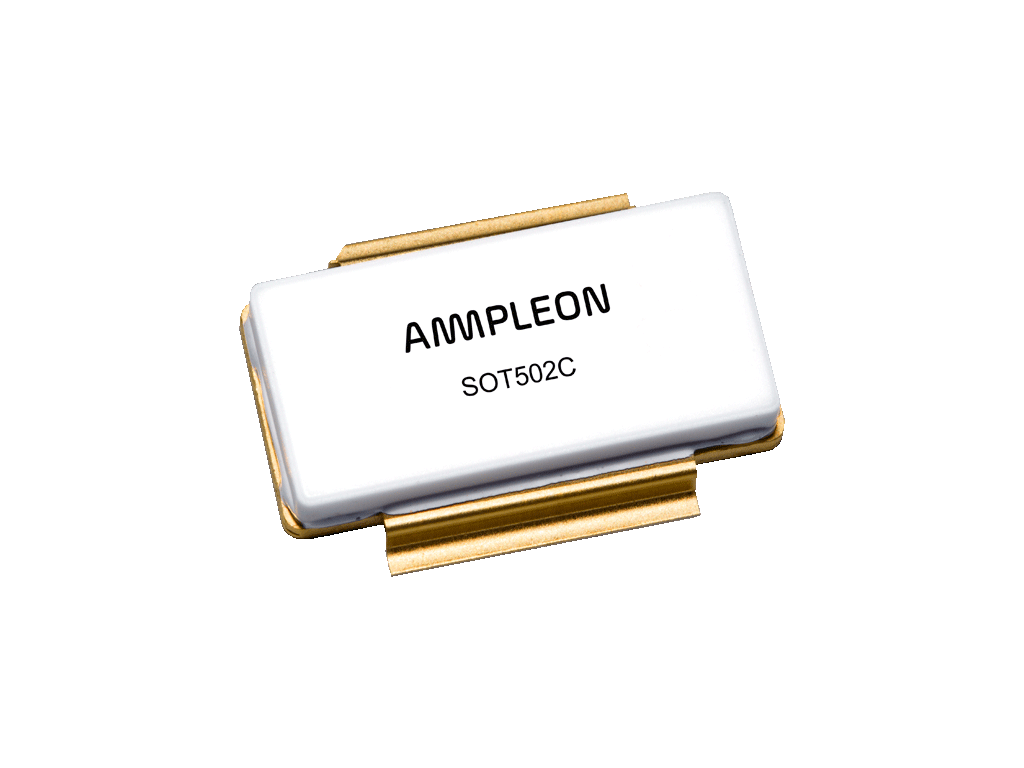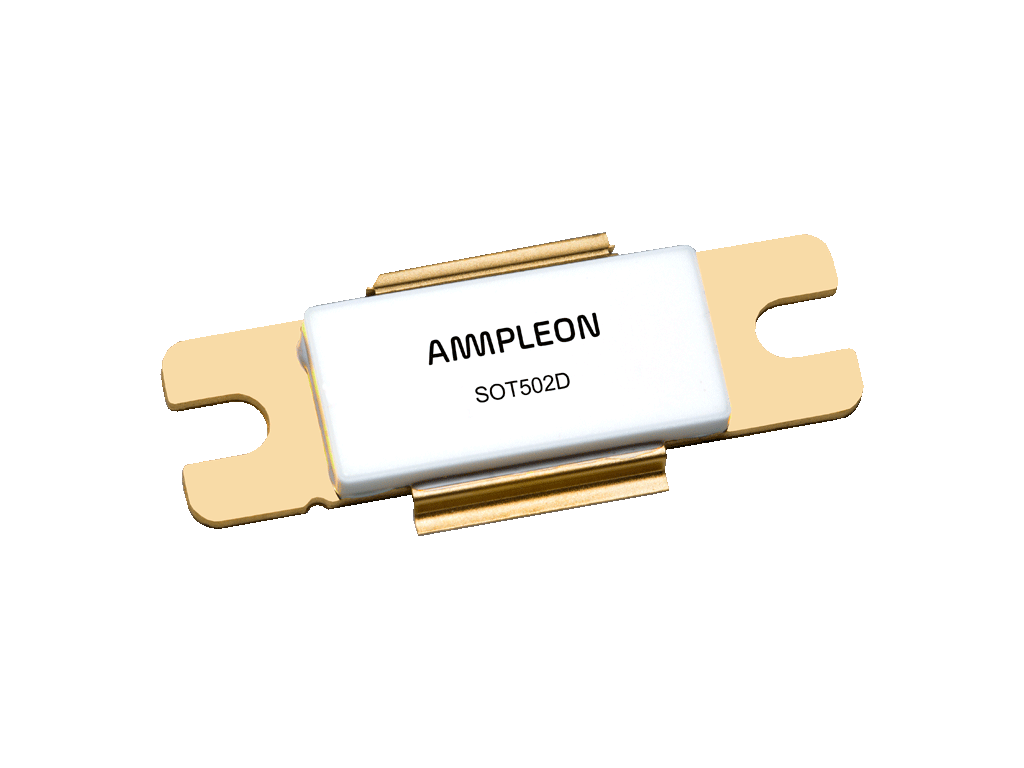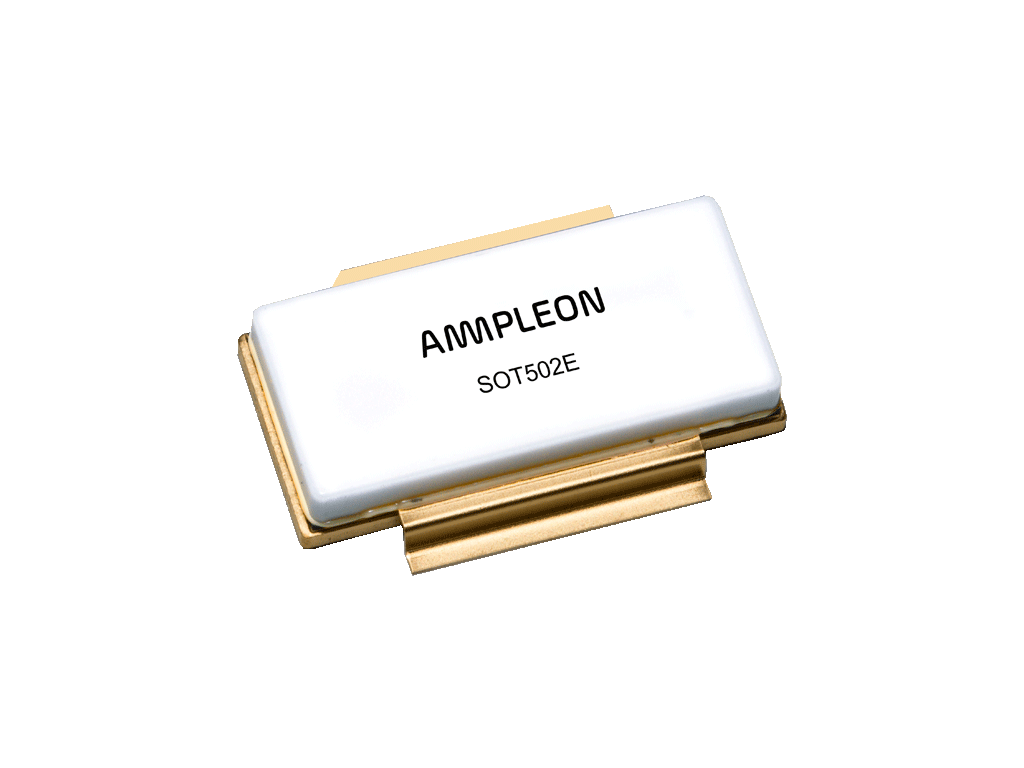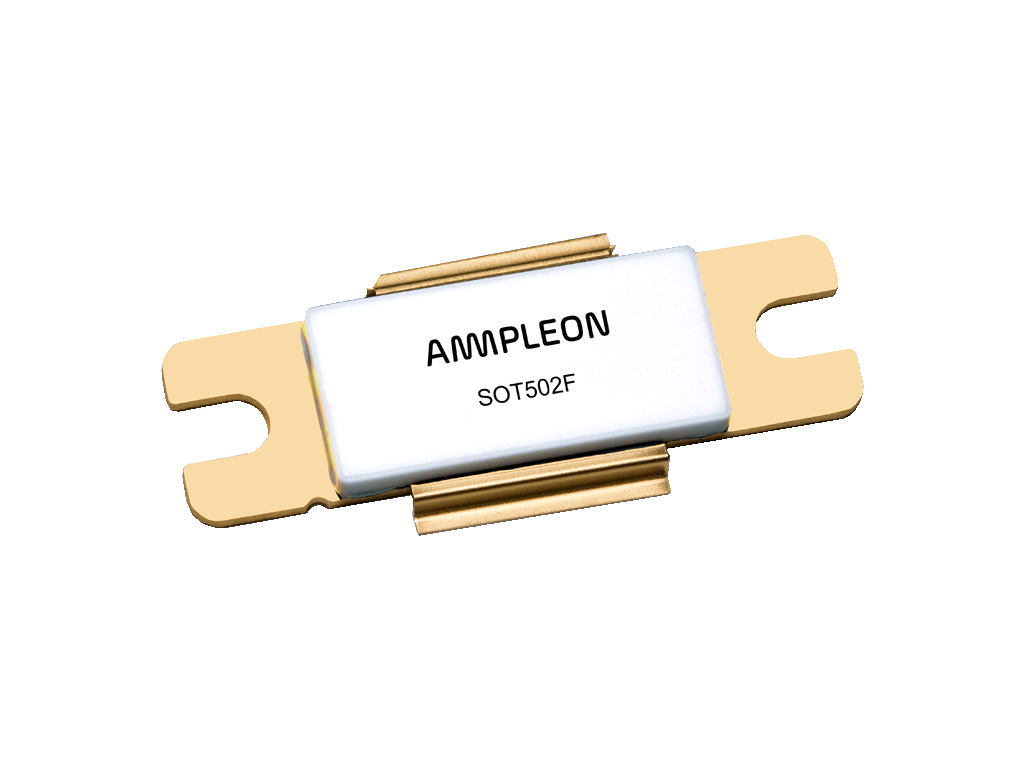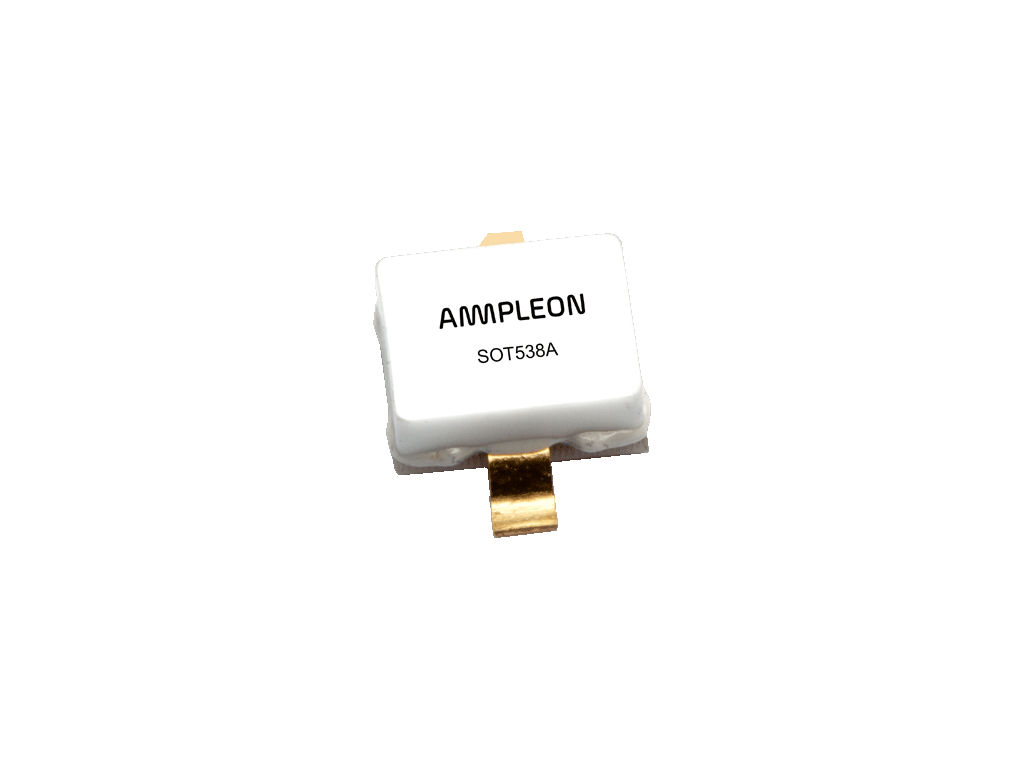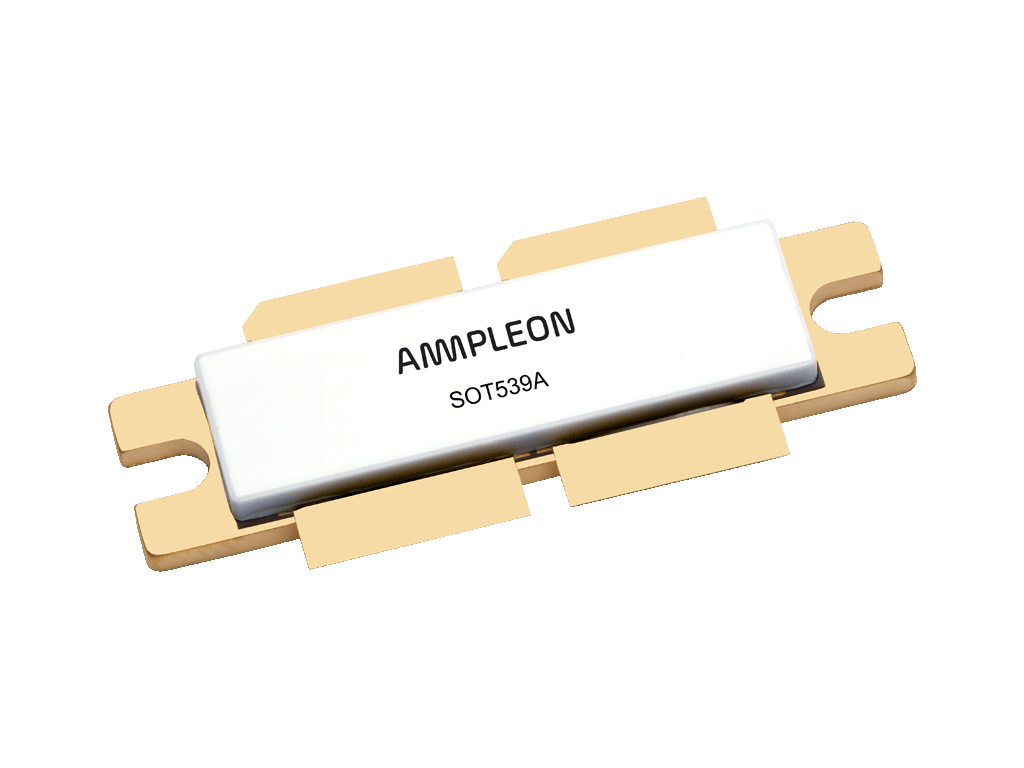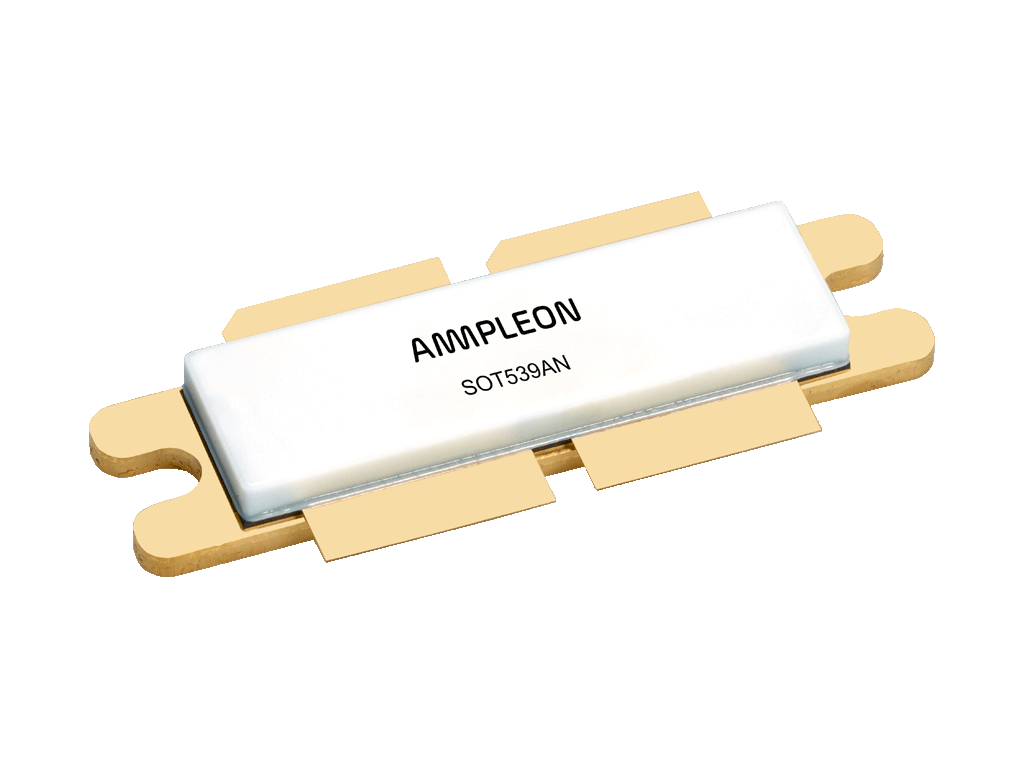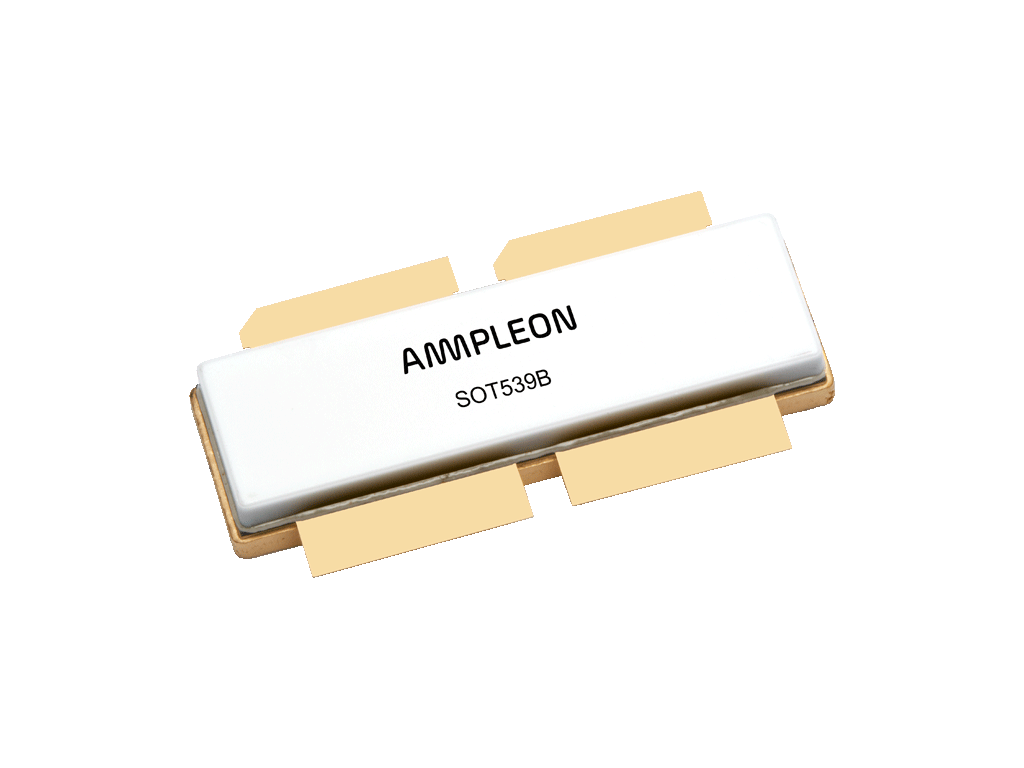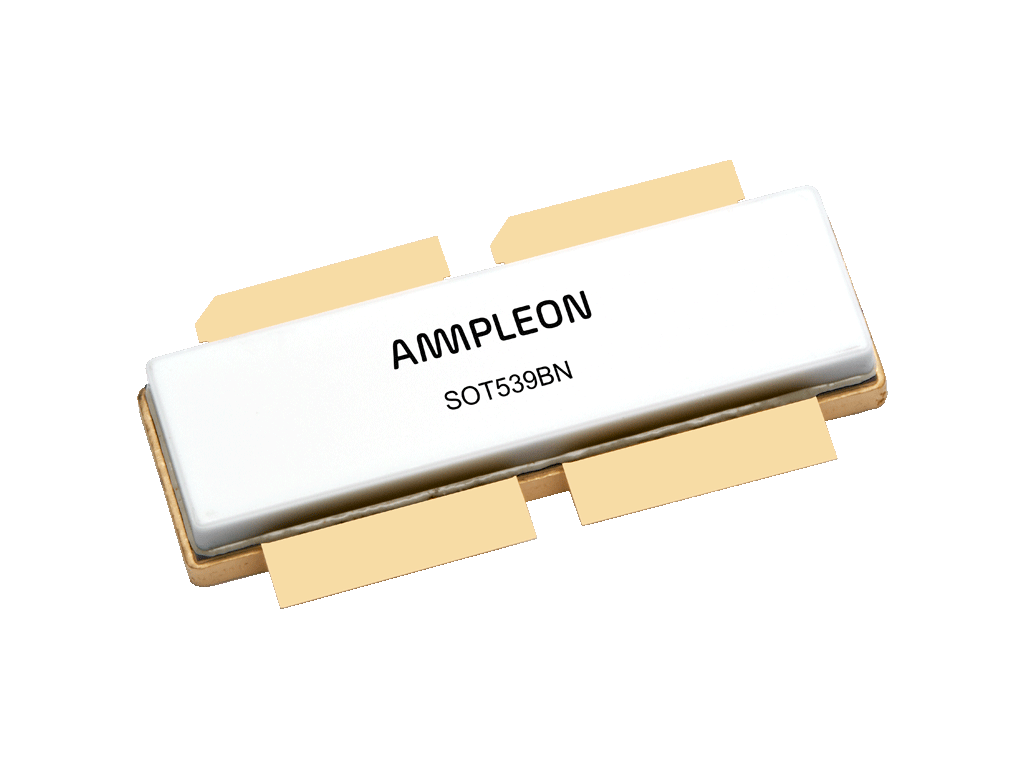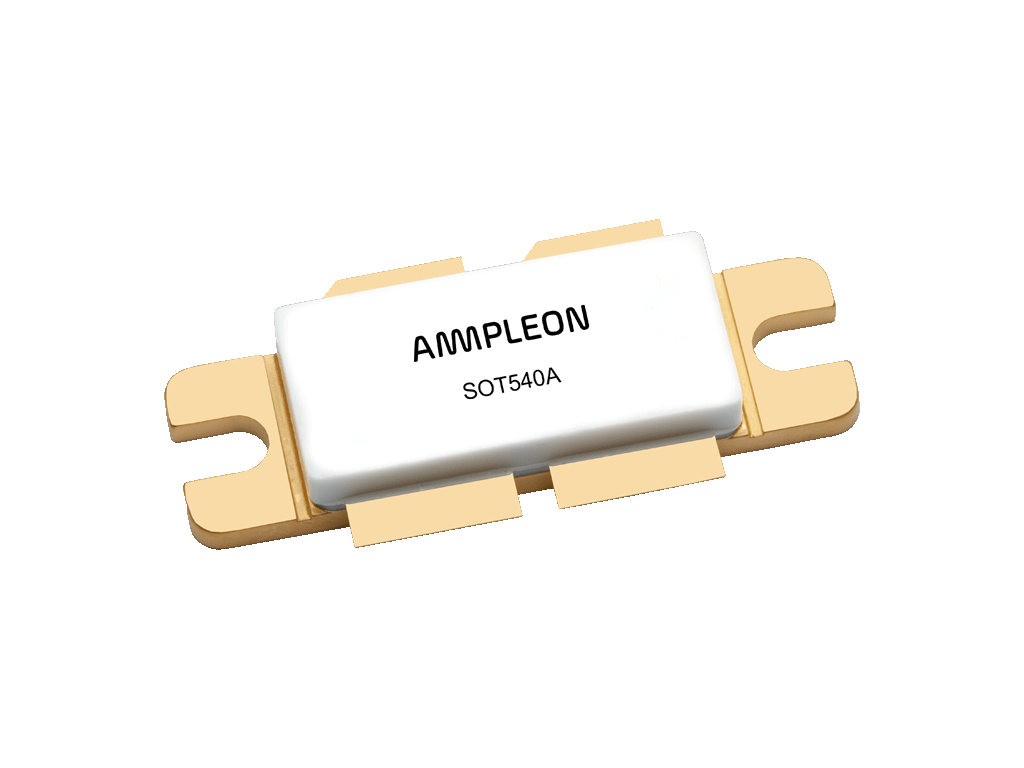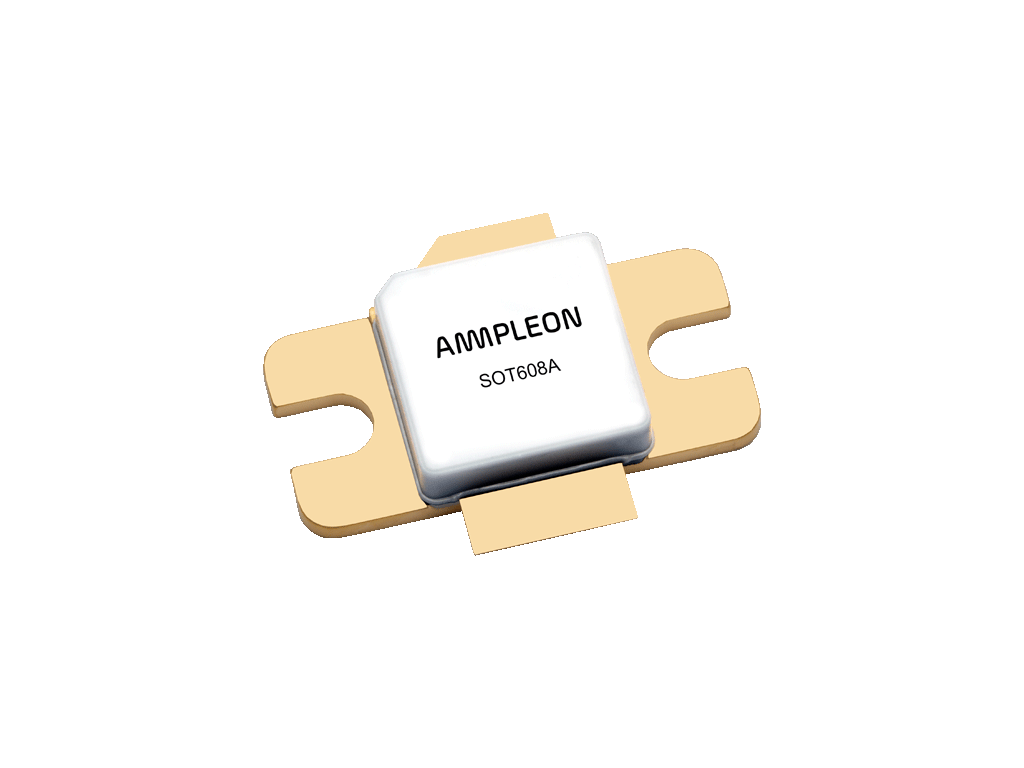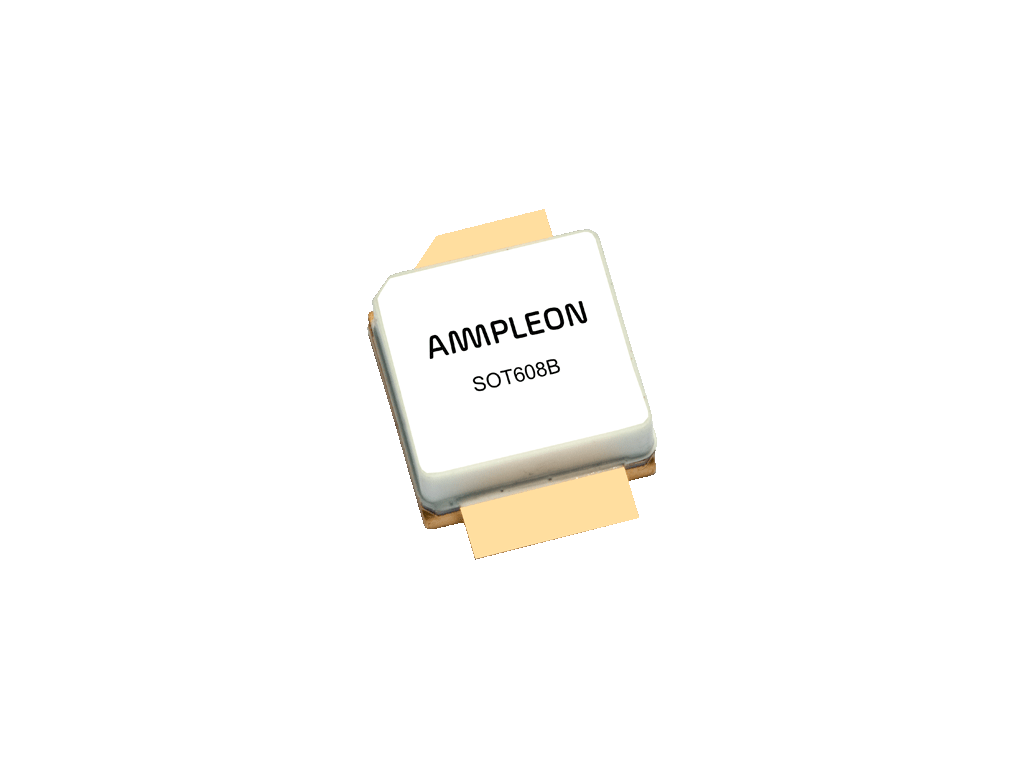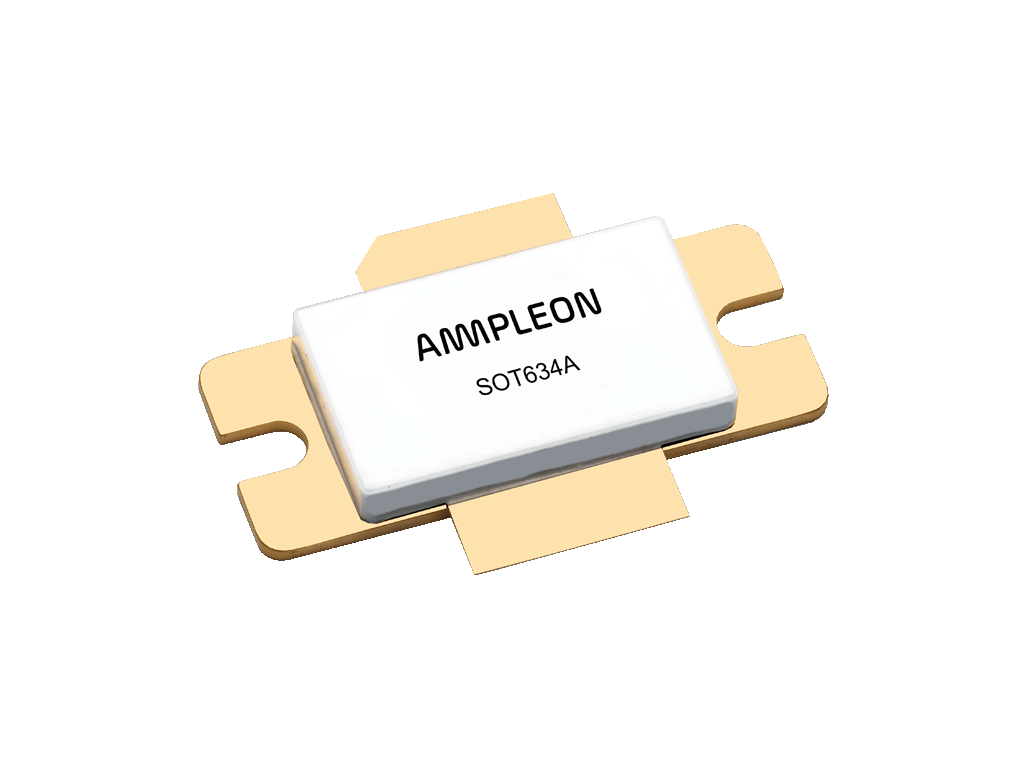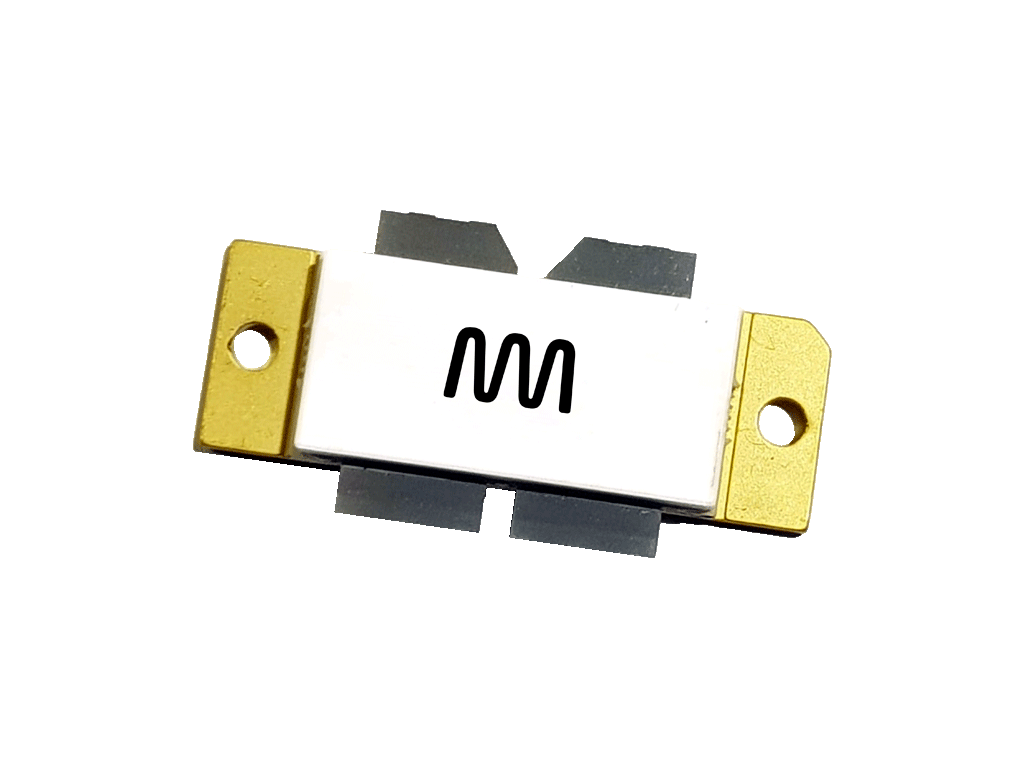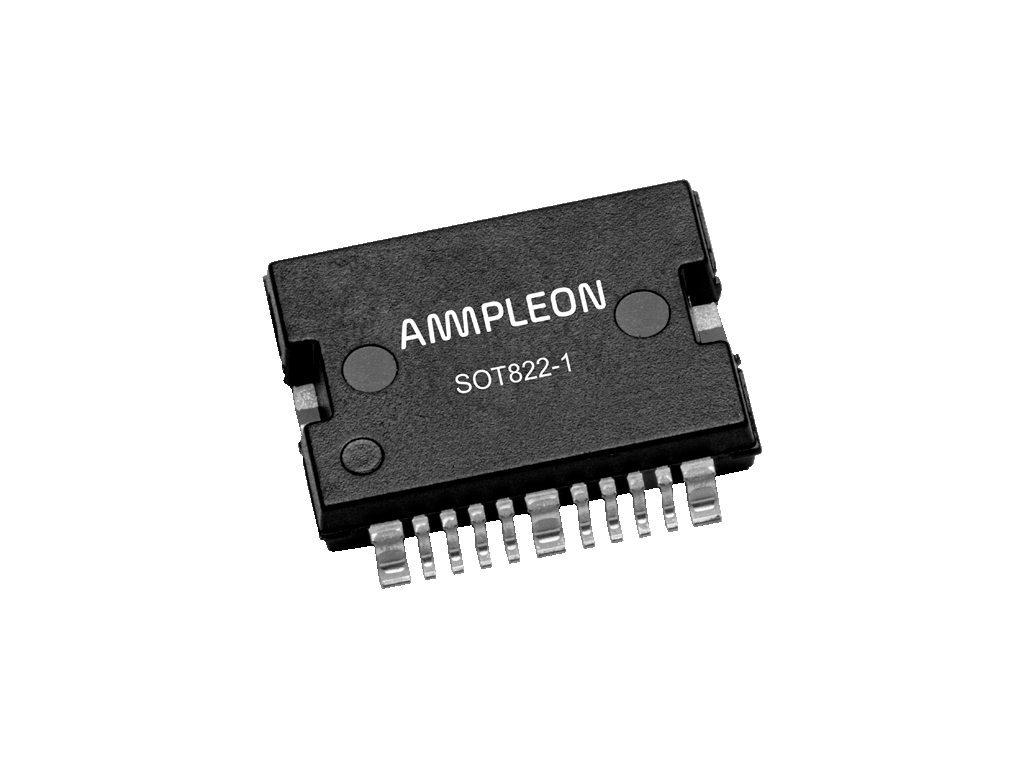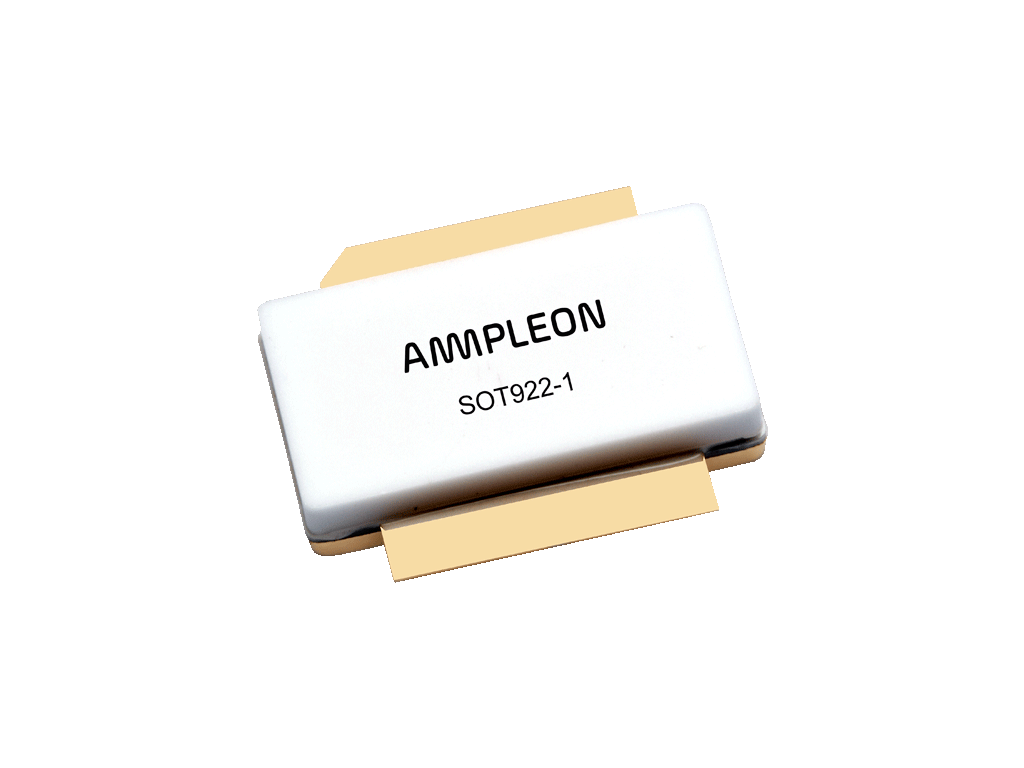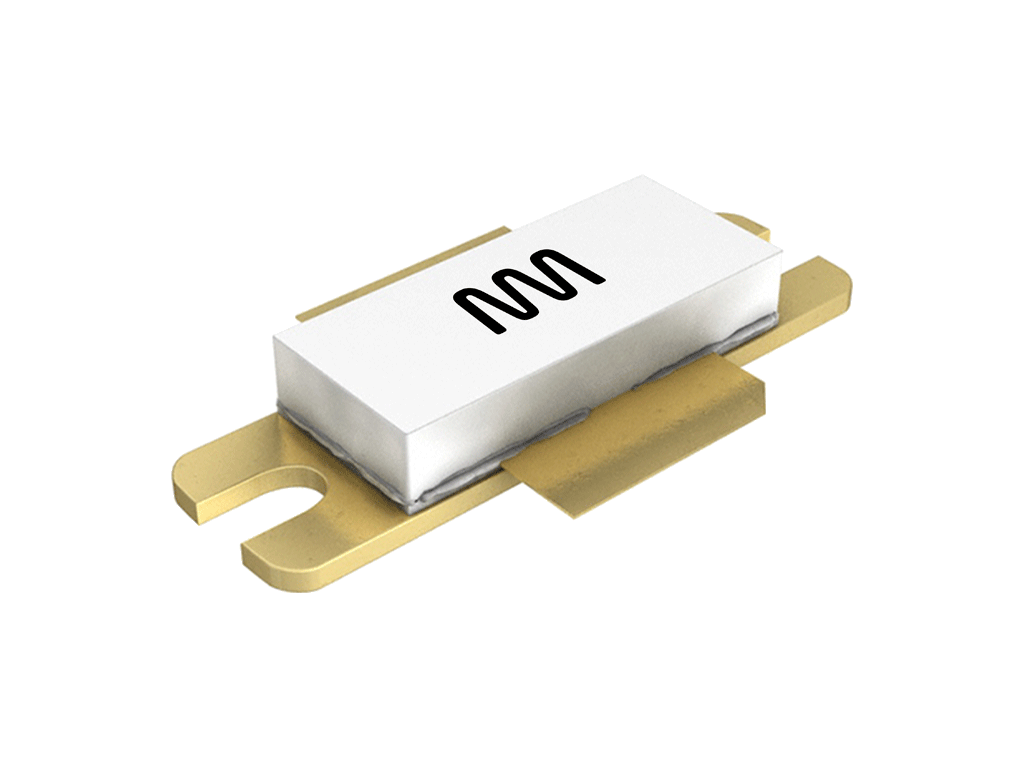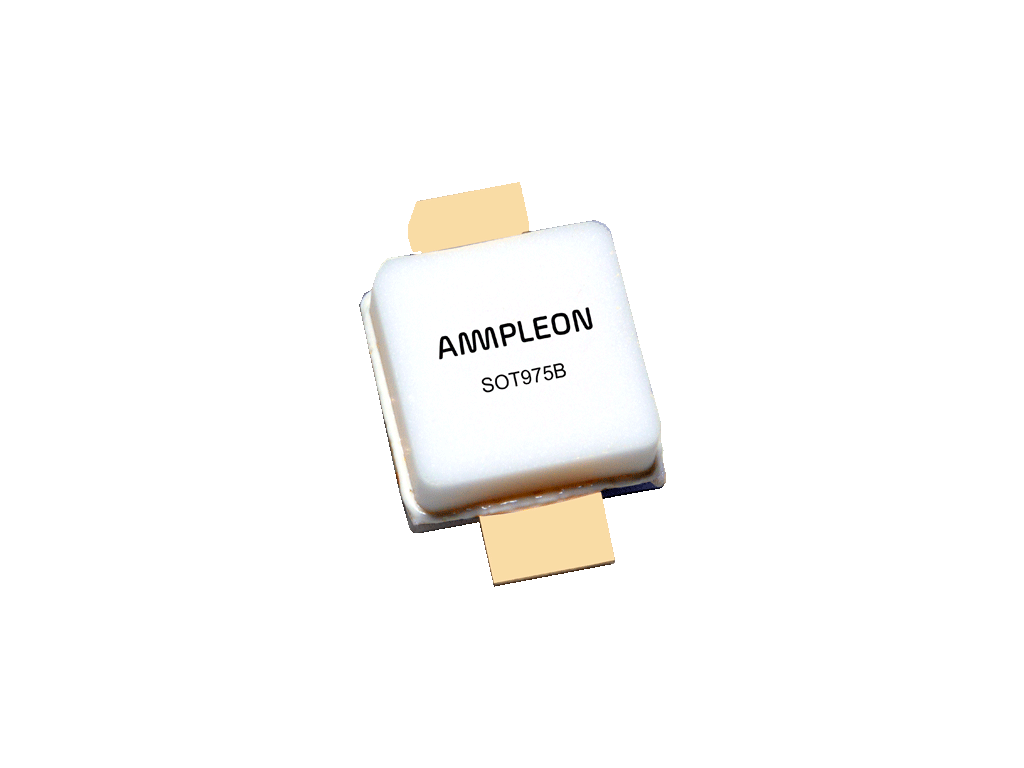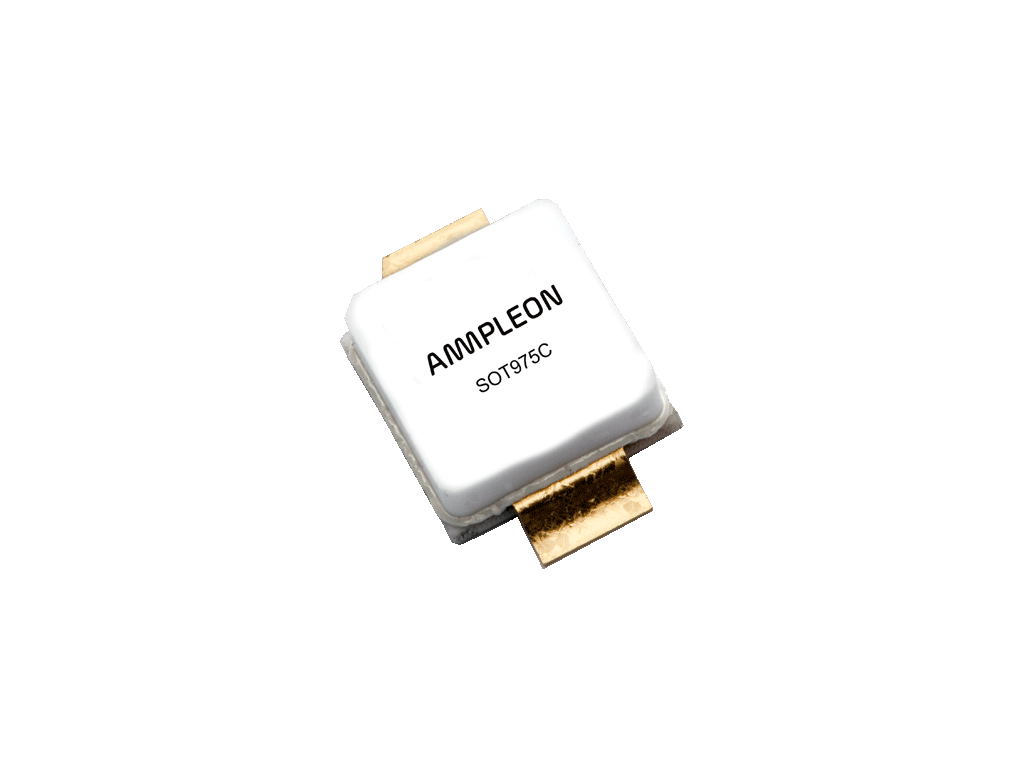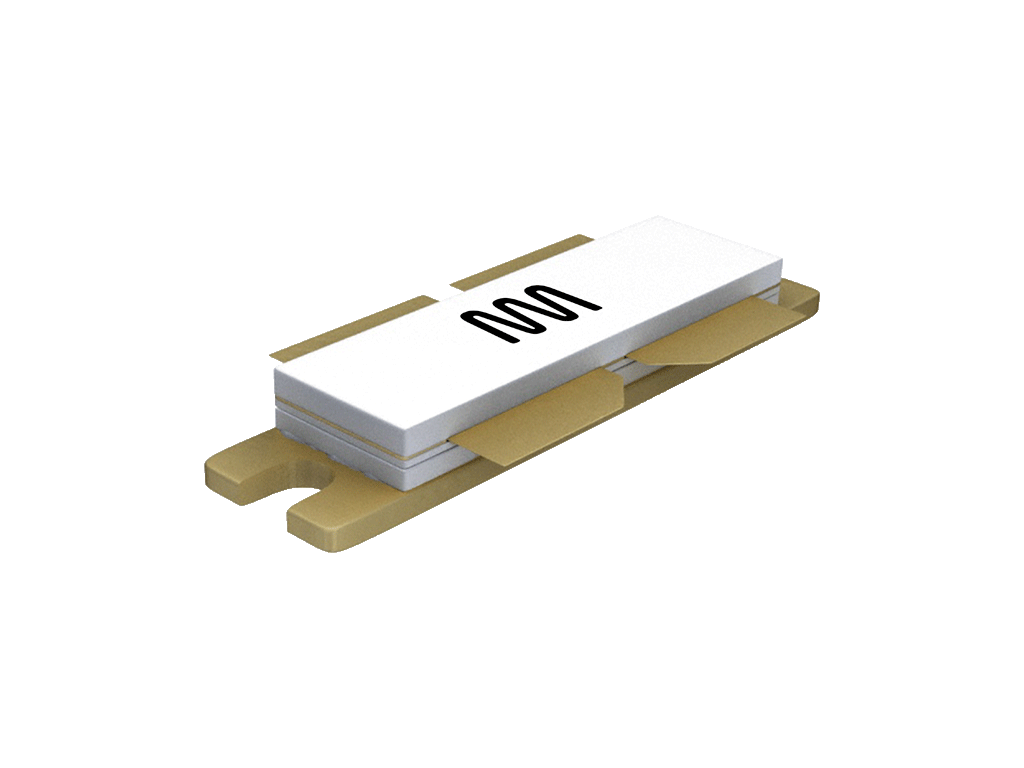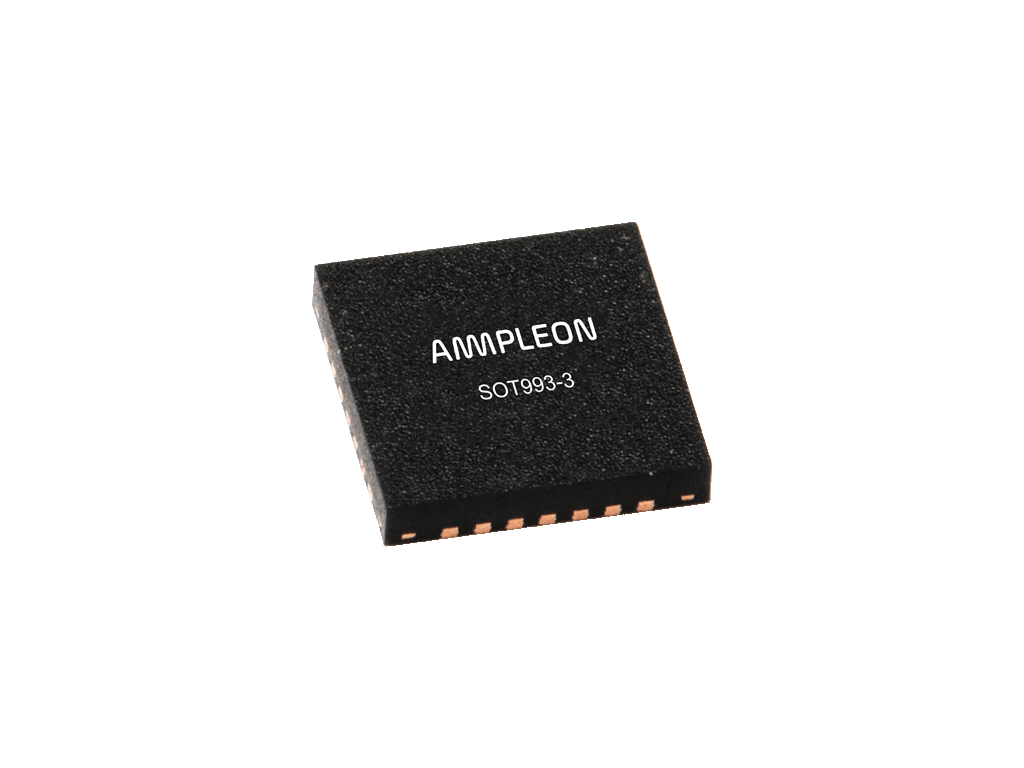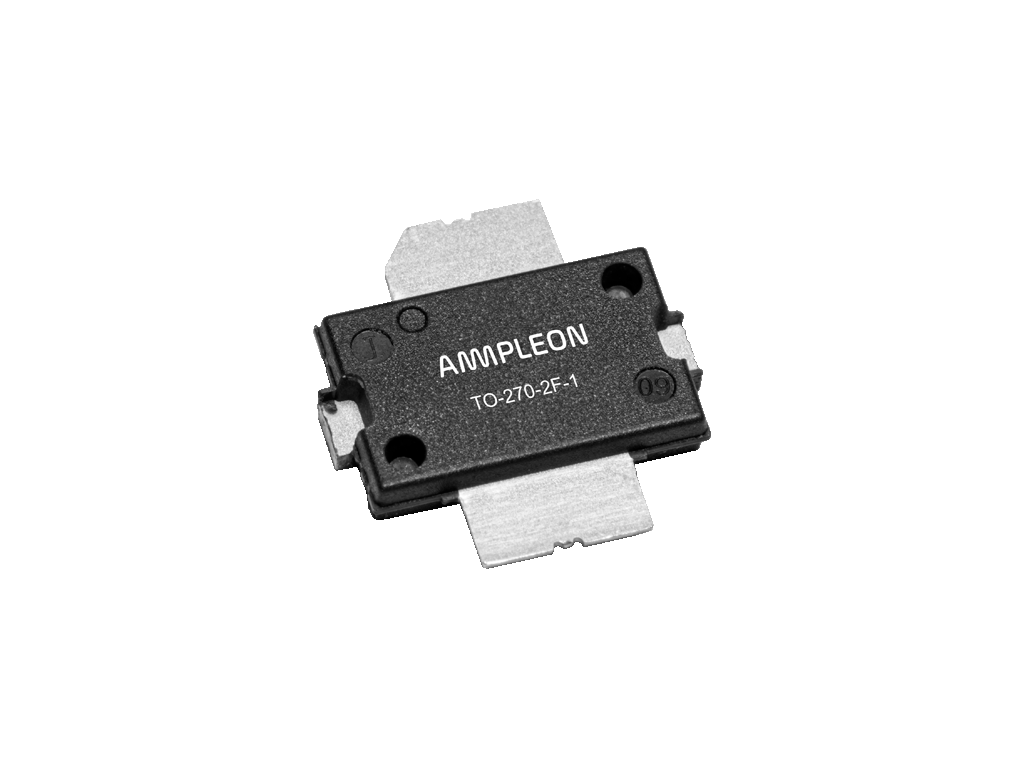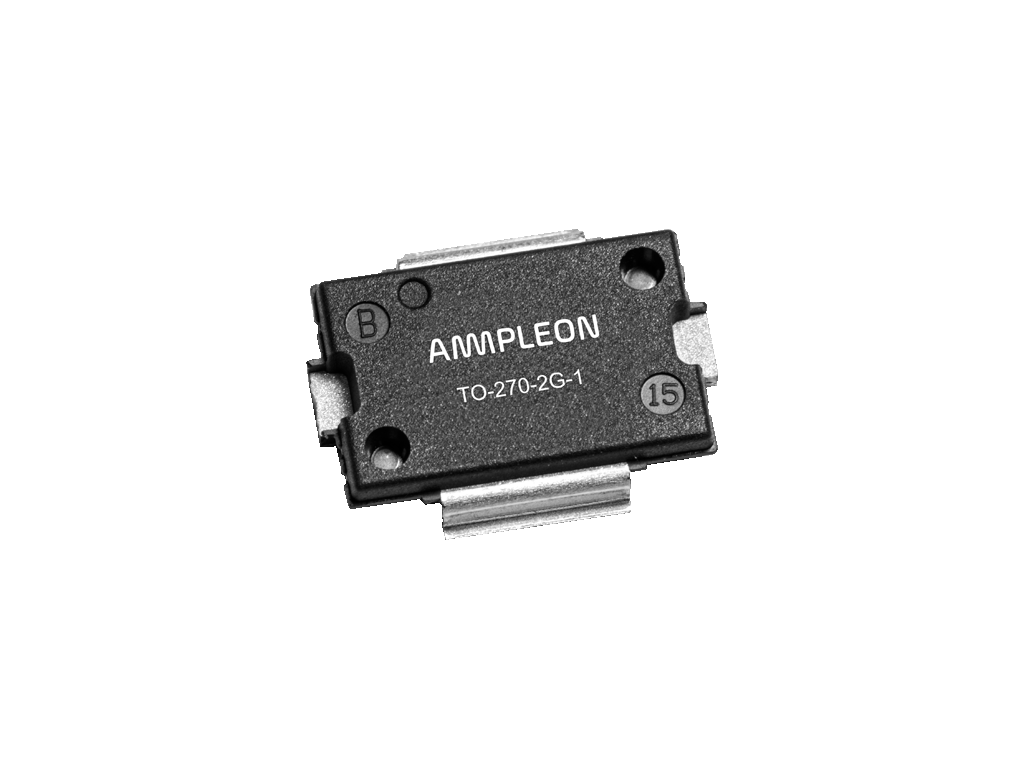Packaging plays a critical role in RF power transistors, influencing both their cost-efficiency and performance. Because peak power levels can vary significantly - from as low as 5 W to over 1 kW - a variety of packaging options is required to accommodate diverse applications. The choice of package format, such as air-cavity or overmolded plastic, typically depends on design requirements and the trade-offs between performance and cost.
The traditional package for RF power transistors is the ACC with a ceramic lid. The package is made of three main parts: flange, ringframe and lid.
The structure of ACP is similar to ACC but the lid and ringframe are glued and are made of a polymer instead of ceramic.
OMP is a lead frame based plastic package having leads protruding from the side portion of the package and a bottom metal flange for high-power thermal dissipation.
Package Search
- * ACC = Air-Cavity Ceramic
- * ACP = Air-Cavity Plastic
- * OMP = Overmolded Plastic
| Package | Package family | Description | Mount | Date | Outline drawing |
|---|---|---|---|---|---|
| SOT502A | acc | Flanged ceramic package; 2 mounting holes; 2 leads | flange mount | 2012-05-02 | Download |
| SOT467C | acc | Flanged ceramic package; 2 mounting holes; 2 leads | flange mount | 2012-05-02 | Download |
| SOT538A | acc | Ceramic surface mounted package; 2 leads | surface mount | 2013-02-07 | Download |
| SOT957A | acc | Flanged ceramic package; 2 mounting holes; 2 leads | flange mount | 2007-03-01 | Download |
| SOT502B | acc | Earless flanged ceramic package; 2 leads | surface mount | 2012-05-02 | Download |
| SOT502D | acc | Eared flanged ceramic package; 2 leads; 2 mounting holes | flange mount | 2011-03-23 | Download |
| SOT502C | acc | Earless flanged ceramic package; 2 leads | flange mount | 2011-03-23 | Download |
| SOT634A | acc | Flanged ceramic package; 2 mounting holes; 2 leads | flange mount | 2003-05-01 | Download |
| SOT539A | acc | Flanged balanced ceramic package; 2 mounting holes; 4 leads | flange mount | 2010-05-02 | Download |
| SOT539B | acc | Earless flanged balanced ceramic package; 4 leads | surface mount | 2013-05-24 | Download |
| SOT502F | acc | Eared flanged ceramic package; 2 leads; 2 mounting holes | flange mount | 2014-03-14 | Download |
| SOT502E | acc | Earless flanged ceramic package; 2 leads | flange mount | 2012-05-30 | Download |
| SOT1250-1 | acp | Plastic earless flanged cavity package; 4 leads | surface mount | 2016-05-20 | Download |
| SOT1275-1 | acp | Air cavity plastic earless flanged package; 6 leads | surface mount | 2017-04-13 | Download |
| SOT1258-1 | acp | Air cavity plastic earless flanged package; 6 leads | surface mount | 2017-08-31 | Download |
| SOT1252-1 | acp | Air cavity plastic earless flanged package; 8 leads | flange mount | 2002-04-09 | Download |
| SOT1275-3 | acp | Air cavity plastic earless flanged package; 6 leads | flange mount | 2014-10-14 | Download |
| SOT1251-2 | acp | Air cavity plastic earless flanged package; 8 leads | flange mount | 2014-01-31 | Download |
| SOT1130A | acc | Flanged ceramic package; 2 mounting holes; 4 leads | flange mount | 2010-02-02 | Download |
| SOT1130B | acc | Earless flanged ceramic package; 4 leads | flange mount | 2009-12-14 | Download |
| SOT123A | acc | Flanged ceramic package; 2 mounting holes; 4 leads | flange mount | 1999-03-29 | Download |
| SOT121B | acc | Flanged ceramic package; 2 mounting holes; 4 leads | flange mount | 1999-03-29 | Download |
| SOT1214A | acc | Flanged ceramic package; 2 mounting holes; 4 leads | flange mount | 2012-10-10 | Download |
| SOT1214B | acc | Earless flanged ceramic package; 4 leads | flange mount | 2024-05-16 | Download |
| SOT1121A | acc | Flanged LDMOST ceramic package; 2 mounting holes; 4 leads | flange mount | 2010-02-02 | Download |
| SOT1121B | acc | Earless flanged ceramic package; 4 leads | flange mount | 2015-07-21 | Download |
| SOT1214C | acc | Earless flanged LDMOST ceramic package; 4 leads | flange mount | 2013-12-02 | Download |
| SOT1248C | acc | Earless flanged LDMOST ceramic package; 4 leads | flange mount | 2013-08-15 | Download |
| SOT409A | acc | Ceramic surface mounted package; 8 leads | surface mount | 2006-03-16 | Download |
| SOT1135A | acc | Flanged ceramic package; 2 mounting holes; 2 leads | flange mount | 2009-12-14 | Download |
| SOT1135B | acc | Earless flanged ceramic package; 2 leads | flange mount | 2009-02-14 | Download |
| SOT279A | acc | Flanged double-ended ceramic package; 2 mounting holes; 4 leads | flange mount | 1999-03-29 | Download |
| SOT161A | acc | Flanged ceramic package; 2 mounting holes; 8 leads | flange mount | 1999-10-04 | Download |
| SOT262A1 | acc | Flanged double-ended ceramic package; 2 mounting holes; 4 leads | flange mount | 1999-03-29 | Download |
| SOT975B | acc | Earless flanged ceramic package; 2 leads | flange mount | 2014-10-20 | Download |
| SOT975C | acc | Earless flanged ceramic package; 2 leads | flange mount | 2014-10-13 | Download |
| SOT119A | acc | Flanged ceramic package; 2 mounting holes; 6 leads | flange mount | 1999-03-29 | Download |
| SOT800-2 | acc | Flanged ceramic package; 2 mounting holes; 4 leads | flange mount | 2005-06-07 | Download |
| SOT608A | acc | Flanged ceramic package; 2 mounting holes; 2 leads | flange mount | 2013-01-29 | Download |
| SOT172D | acc | Studless ceramic package; 4 leads | surface mount | 1997-06-28 | Download |
| SOT171A | acc | Flanged ceramic package; 2 mounting holes; 6 leads | flange mount | 1999-03-29 | Download |
| SOT268A | acc | Flanged double-ended ceramic package; 2 mounting holes; 4 leads | flange mount | 1999-03-29 | Download |
| SOT262A2 | acc | Flanged double-ended ceramic package; 2 mounting holes; 4 leads | flange mount | 1999-03-29 | Download |
| SOT1228A | acc | Flanged LDMOST ceramic package; 2 mounting holes; 4 leads | flange mount | 2013-05-16 | Download |
| SOT540A | acc | Flanged balanced ceramic package; 2 mounting holes; 4 leads | flange mount | 1999-12-28 | Download |
| SOT1112A | acc | Flanged ceramic package; 2 mounting holes; 6 leads | flange mount | 2010-02-02 | Download |
| SOT608B | acc | Ceramic earless flanged package; 2 leads | surface mount | 2013-01-29 | Download |
| SOT1121E | acc | Earless flanged LDMOST ceramic package; 4 leads | flange mount | 2014-06-23 | Download |
| SOT1110A | acc | Flanged LDMOST ceramic package; 2 mounting holes; 8 leads | flange mount | 2010-02-02 | Download |
| SOT1110B | acc | Earless flanged LDMOST ceramic package; 8 leads | flange mount | 2010-02-02 | Download |
| SOT1112B | acc | Earless flanged ceramic package; 6 leads | flange mount | 2010-02-02 | Download |
| SOT467B | acc | Earless ceramic package; 2 leads | flange mount | 2009-10-27 | Download |
| SOT979A | acc | Flanged LDMOST ceramic package; 2 mounting holes; 4 leads | flange mount | 2008-09-04 | Download |
| SOT1244C | acc | Earless flanged ceramic package; 6 leads | flange mount | 2012-05-14 | Download |
| SOT1244B | acc | Earless flanged ceramic package; 6 leads | flange mount | 2012-05-14 | Download |
| SOT1242C | acc | Earless flanged ceramic package; 8 leads | flange mount | 2012-05-15 | Download |
| SOT1242B | acc | Earless flanged ceramic package; 8 leads | flange mount | 2015-07-21 | Download |
| SOT1120B | acc | Earless flanged LDMOST ceramic package; 6 leads | flange mount | 2013-10-21 | Download |
| SOT1239B | acc | Earless flanged LDMOST ceramic package; 6 leads | flange mount | 2013-07-09 | Download |
| Pallet | Product outlines of all Ampleon pallets can be found in the respective Product Data sheets. | flange mount | 2014-04-14 | N/A | |
| SOT834-1 | omp | Plastic, heatsink small outline package; 16 leads (flat) | surface mount | 2003-10-22 | Download |
| SOT822-1 | omp | Plastic, heatsink small outline package; 16 leads | surface mount | 2007-02-08 | Download |
| SOT1211-2 | omp | Plastic, heatsink small outline package; 16 leads (flat) | surface mount | 2015-06-09 | Download |
| SOT1212-2 | omp | Plastic, heatsink small outline package; 16 leads | surface mount | 2015-06-09 | Download |
| SOT1223-2 | omp | Plastic, heatsink small outline package; 4 leads (flat) | surface mount | 2015-06-04 | Download |
| SOT1352-1 | omp | Plastic thermal enhanced very thin small outline package; no leads; 12 terminals | surface mount | 2013-03-26 | Download |
| SOT1179-2 | omp | Plastic thermal enhanced very thin small outline package; no leads; 12 terminals; body 4 x 6 x 0.85 mm | surface mount | 2013-07-16 | Download |
| SOT1138-2 | omp | Plastic, heatsink small outline package; 4 leads (flat) | surface mount | 2015-06-04 | Download |
| SOT1204-2 | omp | Plastic, heatsink small outline package; 4 leads | surface mount | 2015-06-04 | Download |
| SOT1221-2 | omp | Plastic, heatsink small outline package; 6 leads (flat) | surface mount | 2015-06-08 | Download |
| SOT1371-1 | omp | Plastic thermal enhanced very thin small outline package; no leads; 16 terminals | surface mount | 2014-05-19 | Download |
| SOT423A | acc | Flanged hermetic ceramic package; 2 mounting holes; 2 leads | flange mount | 1999-03-29 | Download |
| SOT445C | acc | Flanged hermetic ceramic package; 2 mounting holes; 2 leads | flange mount | 1999-03-29 | Download |
| SOT422A | acc | Flanged hermetic ceramic package; 2 mounting holes; 2 leads | flange mount | 1999-03-29 | Download |
| SOT922-1 | acc | Ceramic earless flanged cavity package; 2 leads | flange mount | 2005-11-22 | Download |
| SOT1228B | acc | Earless flanged LDMOST ceramic package; 4 leads | flange mount | 2013-05-15 | Download |
| SOT1227A | acc | Flanged ceramic package; 2 mounting holes; 2 leads | flange mount | 2013-10-14 | Download |
| SOT1227B | acc | Earless Flanged ceramic package; 2 leads | flange mount | 2013-10-15 | Download |
| SOT1224-2 | omp | Plastic, heatsink small outline package; 4 leads | surface mount | 2015-06-04 | Download |
| SOT1271-2 | acp | Air cavity plastic earless flanged package; 6 leads | flange mount | 2017-04-13 | Download |
| SOT1250-2 | acp | Plastic earless flanged cavity package; 4 leads | surface mount | 2013-09-03 | Download |
| SOT1270-1 | acp | Air cavity plastic earless flanged package; 2 leads | flange mount | 2016-05-04 | Download |
| SOT1273-1 | acp | Air cavity plastic earless flanged package; 4 leads | flange mount | 2017-01-12 | Download |
| SOT1482-1 | omp | Plastic; heatsink small outline package; 2 leads (flat) | flange mount | 2017-04-01 | Download |
| SOT1483-1 | omp | Plastic; heatsink small outline package; 2 leads | flange mount | 2017-02-21 | Download |
| SOT1462-1 | omp | Plastic thermal enhanced quad flat package; no leads; 20 terminals; body 8.0 x 8.0 x 2.1 mm | flange mount | 2017-06-23 | Download |
| SOT1211-3 | omp | Plastic, heatsink small outline package; 16 leads (flat) | flange mount | 2018-07-27 | Download |
| SOT1212-3 | omp | Plastic, heatsink small outline package; 16 leads | flange mount | 2018-07-27 | Download |
| SOT1251-1 | acp | Air cavity plastic earless flanged package; 8 leads | flange mount | 2017-08-31 | Download |
| SOT1258-4 | acp | Air cavity plastic earless flanged package; 6 leads | flange mount | 2017-08-31 | Download |
| SOT993-3 | omp | Plastic thermal enhanced very thin quad flat package; no leads; 28 terminals; body 5 x 5 x 0.85 mm | surface mount | 2010-03-02 | Download |
| SOT1138-3 | omp | Plastic, heatsink small outline package; 4 leads (flat) | surface mount | 2018-07-26 | Download |
| SOT1204-3 | omp | Plastic, heatsink small outline package; 4 leads | surface mount | 2018-07-26 | Download |
| SOT1223-4 | omp | Plastic, heatsink small outline package; 4 leads (flat) | surface mount | 2018-07-26 | Download |
| SOT1224-4 | omp | Plastic, heatsink small outline package; 4 leads (flat) | surface mount | 2018-07-26 | Download |
| SOT1278-1 | acp | Air cavity plastic earless flanged package; 6 leads | flange mount | 2017-04-18 | Download |
| OMP-780-16G-1 | omp | Plastic, heatsink small outline package; 16 leads | surface mount | 2018-01-03 | Download |
| OMP-780-16F-1 | omp | Plastic, heatsink small outline package; 16 leads (flat) | surface mount | 2018-03-01 | Download |
| OMP-780-4F-1 | omp | Plastic, heatsink small outline package; 4 leads (flat) | surface mount | 2018-03-01 | Download |
| OMP-400-8G-1 | omp | Plastic, heatsink small outline package; 8 leads | surface mount | 2019-05-03 | Download |
| OMP-1230-4F-1 | omp | Overmolded plastic earless flanged package; 4 leads | surface mount | 2019-07-02 | Download |
| OMP-1230-4G-1 | omp | Overmolded plastic earless flanged package; 4 leads | surface mount | 2019-07-02 | Download |
| SOT1258-5 | acp | Air cavity plastic earless flanged package; 6 leads | flange mount | 2018-10-01 | Download |
| SOT1250-4 | acp | Plastic earless flanged cavity package; 4 leads | flange mount | 2019-01-17 | Download |
| SOT539AN | acc | Flanged balanced ceramic package; 2 mounting holes; 4 leads | flange mount | 2020-04-20 | Download |
| OMP-400-8F-1 | omp | Plastic, heatsink small outline package; 8 leads | surface mount | 2019-11-26 | Download |
| LGA-7x7-20-1 | omp | Plastic thermal enhanced package; no leads; 20 terminals; body 7.0 x 7.0 x 0.98 mm | flange mount | 2019-12-30 | Download |
| LGA-7x7-20-2 | omp | Plastic thermal enhanced package; no leads; 20 terminals; body 7.0 x 7.0 x 0.98 mm | flange mount | 2019-12-30 | Download |
| OMP-780-6F-1 | omp | Overmolded plastic earless flanged package; 6 leads | surface mount | 2018-01-03 | Download |
| SOT539BN | acc | Earless flanged balanced ceramic package; 4 leads | surface mount | 2020-04-20 | Download |
| DFN-7x6.5-6-1 | omp | Dual flat no leads plastic package | flange mount | 2020-05-29 | Download |
| DFN-4.5x4-6-1 | omp | Dual flat no leads plastic package | flange mount | 2020-05-29 | Download |
| PQFN-12x7-36-1 | omp | Power Quad Flat No leads package with exposed heatsink, 36 I/O’s, 12x7 mm outline | flange mount | 2021-11-23 | Download |
| OMP-1230-6F-1 | omp | Overmolded plastic earless flanged package; 6 leads | flange mount | 2019-02-07 | Download |
| TO-270-2F-1 | omp | Plastic; heatsink small outline package; 2 leads (flat) | flange mount | 2022-07-11 | Download |
| TO-270-2G-1 | omp | Plastic; heatsink small outline package; 2 leads | flange mount | 2022-07-11 | Download |
| SOT1249B | acc | Earless flanged ceramic package; 6 leads | surface mount | 2022-07-09 | Download |
| ACC-1230-6G-2 | acc | Earless flanged ceramic package; 6 leads | flange mount | 2022-09-14 | Download |
| ACC-1230-6F-2 | acc | Earless flanged ceramic package; 6 leads | flange mount | 2022-09-14 | Download |
| LGA-12x8-34-2 | omp | Land Grid Array, 34 I/O’s, 12x8 mm outline | flange mount | 2022-02-16 | Download |
| OMP-780-4G-1 | omp | Plastic, heatsink small outline package; 4 leads (flat) | surface mount | 2018-01-03 | Download |
| OMP-1230-6F-2 | omp | Overmolded plastic earless flanged package; 6 leads | flange mount | 2021-07-15 | Download |
| ACC-1230-6F-3 | acc | Flanged ceramic package; 2 Mounting holes; 6 leads | flange mount | 2024-04-30 | Download |
| QFN-8x8-20-1 | omp | Quad Flat No leads package with exposed heatsink, 20 I/O’s, 8x8 mm outline | surface mount | 2022-06-12 | Download |
| Package family | Package type | Package outline | Package description | L (mm) | W (mm) | H (mm) | Issue date | Outline drawing |
|---|---|---|---|---|---|---|---|---|
| ACC | ACC-1230 | ACC-1230-6F-2 | Earless flanged ceramic package; 6 leads | 31.55 | 9.5 | 5.5 | 2022/09/14 | Download |
| ACC | ACC-1230 | ACC-1230-6F-3 | Flanged ceramic package; 2 Mounting holes; 6 leads | 31.55 | 9.5 | 5.5 | 2024/04/30 | Download |
| ACC | ACC-1230 | ACC-1230-6G-2 | Earless flanged ceramic package; 6 leads | 31.55 | 9.5 | 5.5 | 2022/09/14 | Download |
| OMP | DFN-4.5x4 | DFN-4.5x4-6-1 | Dual flat no leads plastic package | 4.5 | 4 | 0.85 | 2020/05/29 | Download |
| OMP | DFN-7x6.5 | DFN-7x6.5-6-1 | Dual flat no leads plastic package | 7 | 6.5 | 0.85 | 2020/05/29 | Download |
| OMP | LGA-12x8 | LGA-12x8-34-2 | Land Grid Array, 34 I/O’s, 12x8 mm outline | 12 | 8 | 0.98 | 2022/02/16 | Download |
| OMP | LGA-7x7 | LGA-7x7-20-1 | Plastic thermal enhanced package; no leads; 20 terminals | 7 | 7 | 0.98 | 2019/12/30 | Download |
| OMP | LGA-7x7 | LGA-7x7-20-2 | Plastic thermal enhanced package; no leads; 20 terminals | 7 | 7 | 0.98 | 2019/12/30 | Download |
| OMP | OMP-1230 | OMP-1230-4F-1 | Overmolded plastic earless flanged package; 4 leads | 32.43 | 9.96 | 3.92 | 2019/07/02 | Download |
| OMP | OMP-1230 | OMP-1230-4G-1 | Overmolded plastic earless flanged package; 4 leads | 32.43 | 9.96 | 3.92 | 2019/07/02 | Download |
| OMP | OMP-1230 | OMP-1230-6F-1 | Overmolded plastic earless flanged package; 6 leads | 32.43 | 9.96 | 3.92 | 2019/02/07 | Download |
| OMP | OMP-1230 | OMP-1230-6F-2 | Overmolded plastic earless flanged package; 6 leads | 32.43 | 9.96 | 3.92 | 2021/07/15 | Download |
| OMP | OMP-400 | OMP-400-8F-1 | Plastic, heatsink small outline package; 8 leads | 10.3 | 10.3 | 3.92 | 2019/11/26 | Download |
| OMP | OMP-400 | OMP-400-8G-1 | Plastic, heatsink small outline package; 8 leads | 10.3 | 10.3 | 3.92 | 2019/05/03 | Download |
| OMP | OMP-780 | OMP-780-16F-1 | Plastic, heatsink small outline package; 16 leads (flat) | 20.75 | 9.96 | 3.92 | 2018/03/01 | Download |
| OMP | OMP-780 | OMP-780-16G-1 | Plastic, heatsink small outline package; 16 leads | 20.75 | 9.96 | 3.92 | 2018/01/03 | Download |
| OMP | OMP-780 | OMP-780-4F-1 | Plastic, heatsink small outline package; 4 leads (flat) | 20.75 | 9.96 | 3.92 | 2018/03/01 | Download |
| OMP | OMP-780 | OMP-780-4G-1 | Plastic, heatsink small outline package; 4 leads (flat) | 20.75 | 9.96 | 3.92 | 2018/01/03 | Download |
| OMP | OMP-780 | OMP-780-6F-1 | Overmolded plastic earless flanged package; 6 leads | 20.75 | 9.96 | 3.92 | 2018/01/03 | Download |
| OMP | PQFN-12x7 | PQFN-12x7-36-1 | Power Quad Flat No leads package with exposed heatsink, 36 I/O’s | 12 | 7 | 2.1 | 2021/11/23 | Download |
| OMP | QFN-8x8 | QFN-8x8-20-1 | Quad Flat No leads package with exposed heatsink, 20 I/O’s | 8 | 8 | 1.05 | 2022/06/12 | Download |
| ACC | ACC-1230 | SOT1110A | Flanged LDMOST ceramic package; 2 mounting holes; 8 leads | 31.55 | 9.5 | 5.5 | 2010/02/02 | Download |
| ACC | ACC-1230 | SOT1110B | Earless flanged LDMOST ceramic package; 8 leads | 31.55 | 9.5 | 5.5 | 2010/02/02 | Download |
| ACC | ACC-400 | SOT1112A | Flanged ceramic package; 2 mounting holes; 6 leads | 9.65 | 9.65 | 4.65 | 2010/02/02 | Download |
| ACC | ACC-400 | SOT1112B | Earless flanged ceramic package; 6 leads | 9.65 | 9.65 | 4.65 | 2010/02/02 | Download |
| ACC | ACC-780 | SOT1120B | Earless flanged LDMOST ceramic package; 6 leads | 20.02 | 9.53 | 4.75 | 2013/10/21 | Download |
| ACC | ACC-780 | SOT1121A | Flanged LDMOST ceramic package; 2 mounting holes; 4 leads | 20.02 | 9.53 | 4.75 | 2010/02/02 | Download |
| ACC | ACC-780 | SOT1121B | Earless flanged ceramic package; 4 leads | 20.02 | 9.53 | 4.75 | 2015/07/21 | Download |
| ACC | ACC-780 | SOT1121E | Earless flanged LDMOST ceramic package; 4 leads | 20.02 | 9.53 | 4.75 | 2014/06/23 | Download |
| ACC | ACC-400 | SOT1130A | Flanged ceramic package; 2 mounting holes; 4 leads | 9.65 | 9.65 | 4.65 | 2010/02/02 | Download |
| ACC | ACC-400 | SOT1130B | Earless flanged ceramic package; 4 leads | 9.65 | 9.65 | 4.65 | 2009/12/14 | Download |
| ACC | ACC-400 | SOT1135A | Flanged ceramic package; 2 mounting holes; 2 leads | 9.65 | 9.65 | 4.65 | 2009/12/14 | Download |
| ACC | ACC-400 | SOT1135B | Earless flanged ceramic package; 2 leads | 9.65 | 9.65 | 4.65 | 2009/02/14 | Download |
| OMP | OMP-780 | SOT1138-2 | Plastic, heatsink small outline package; 4 leads (flat) | 20.62 | 10.01 | 3.9 | 2015/06/04 | Download |
| OMP | OMP-780 | SOT1138-3 | Plastic, heatsink small outline package; 4 leads (flat) | 20.75 | 9.96 | 3.92 | 2018/07/26 | Download |
| OMP | DFN-6x4 | SOT1179-2 | Plastic thermal enhanced very thin small outline package; no leads; 12 terminals | 6.1 | 4.1 | 1 | 2013/07/16 | Download |
| ACC | SOT119 | SOT119A | Flanged ceramic package; 2 mounting holes; 6 leads | 12.86 | 12.86 | 7.39 | 1999/03/29 | Download |
| OMP | OMP-780 | SOT1204-2 | Plastic, heatsink small outline package; 4 leads | 20.62 | 10.01 | 3.9 | 2015/06/04 | Download |
| OMP | OMP-780 | SOT1204-3 | Plastic, heatsink small outline package; 4 leads | 20.75 | 9.96 | 3.92 | 2018/07/26 | Download |
| OMP | OMP-780 | SOT1211-2 | Plastic, heatsink small outline package; 16 leads (flat) | 20.62 | 10.01 | 3.9 | 2015/06/09 | Download |
| OMP | OMP-780 | SOT1211-3 | Plastic, heatsink small outline package; 16 leads (flat) | 20.75 | 9.96 | 3.92 | 2018/07/26 | Download |
| OMP | OMP-780 | SOT1212-2 | Plastic, heatsink small outline package; 16 leads | 20.62 | 10.01 | 3.9 | 2015/06/09 | Download |
| OMP | OMP-780 | SOT1212-3 | Plastic, heatsink small outline package; 16 leads | 20.75 | 9.96 | 3.92 | 2018/07/26 | Download |
| ACC | ACC-780 | SOT1214A | Flanged ceramic package; 2 mounting holes; 4 leads | 20.02 | 9.53 | 4.72 | 2012/10/10 | Download |
| ACC | ACC-780 | SOT1214B | Earless flanged ceramic package; 4 leads | 20.02 | 9.53 | 4.72 | 2024/05/16 | Download |
| ACC | ACC-780 | SOT1214C | Earless flanged LDMOST ceramic package; 4 leads | 20.02 | 9.53 | 4.72 | 2013/12/02 | Download |
| ACC | SOT121 | SOT121B | Flanged ceramic package; 2 mounting holes; 4 leads | 12.86 | 12.86 | 7.27 | 1999/03/29 | Download |
| OMP | OMP-780 | SOT1221-2 | Plastic, heatsink small outline package; 6 leads (flat) | 20.62 | 10.01 | 3.9 | 2015/06/08 | Download |
| OMP | OMP-780 | SOT1223-2 | Plastic, heatsink small outline package; 4 leads (flat) | 20.62 | 10.01 | 3.9 | 2015/06/04 | Download |
| OMP | OMP-780 | SOT1223-4 | Plastic, heatsink small outline package; 4 leads (flat) | 20.57 | 9.96 | 3.92 | 2018/07/26 | Download |
| OMP | OMP-780 | SOT1224-2 | Plastic, heatsink small outline package; 4 leads | 20.62 | 10.01 | 3.9 | 2015/06/04 | Download |
| OMP | OMP-780 | SOT1224-4 | Plastic, heatsink small outline package; 4 leads (flat) | 20.57 | 9.96 | 3.92 | 2018/07/26 | Download |
| ACC | SOT1227 | SOT1227A | Flanged ceramic package; 2 mounting holes; 2 leads | 5.18 | 4.17 | 3.68 | 2013/10/14 | Download |
| ACC | SOT1227 | SOT1227B | Earless Flanged ceramic package; 2 leads | 5.18 | 4.17 | 3.68 | 2013/10/15 | Download |
| ACC | SOT1228 | SOT1228A | Flanged LDMOST ceramic package; 2 mounting holes; 4 leads | 16.66 | 5.92 | 5.2 | 2013/05/16 | Download |
| ACC | SOT1228 | SOT1228B | Earless flanged LDMOST ceramic package; 4 leads | 16.66 | 5.92 | 5.2 | 2013/05/15 | Download |
| ACC | ACC-780 | SOT1239B | Earless flanged LDMOST ceramic package; 6 leads | 20.02 | 9.53 | 4.75 | 2013/07/09 | Download |
| ACC | SOT123 | SOT123A | Flanged ceramic package; 2 mounting holes; 4 leads | 9.73 | 9.73 | 7.47 | 1999/03/29 | Download |
| ACC | ACC-1230 | SOT1242B | Earless flanged ceramic package; 8 leads | 31.55 | 9.5 | 5.5 | 2015/07/21 | Download |
| ACC | ACC-1230 | SOT1242C | Earless flanged ceramic package; 8 leads | 31.55 | 9.5 | 5.5 | 2012/05/15 | Download |
| ACC | ACC-780 | SOT1244B | Earless flanged ceramic package; 6 leads | 20.02 | 9.53 | 4.75 | 2012/05/14 | Download |
| ACC | ACC-780 | SOT1244C | Earless flanged ceramic package; 6 leads | 20.02 | 9.53 | 4.75 | 2012/05/14 | Download |
| ACC | ACC-1230 | SOT1248C | Earless flanged LDMOST ceramic package; 4 leads | 31.55 | 9.5 | 5.5 | 2013/08/15 | Download |
| ACC | ACC-780 | SOT1249B | Earless flanged ceramic package; 6 leads | 20.02 | 9.53 | 4.75 | 2022/07/09 | Download |
| ACP | ACP-1230 | SOT1250-1 | Plastic earless flanged cavity package; 4 leads | 31.44 | 9.6 | 4.65 | 2016/05/20 | Download |
| ACP | ACP-1230 | SOT1250-2 | Plastic earless flanged cavity package; 4 leads | 31.44 | 9.6 | 4.52 | 2013/09/03 | Download |
| ACP | ACP-1230 | SOT1250-4 | Plastic earless flanged cavity package; 4 leads | 31.44 | 9.6 | 4.52 | 2019/01/17 | Download |
| ACP | ACP-1230 | SOT1251-1 | Air cavity plastic earless flanged package; 8 leads | 31.44 | 9.6 | 4.65 | 2017/08/31 | Download |
| ACP | ACP-1230 | SOT1251-2 | Air cavity plastic earless flanged package; 8 leads | 31.44 | 9.6 | 4.65 | 2014/01/31 | Download |
| ACP | ACP-1230 | SOT1252-1 | Air cavity plastic earless flanged package; 8 leads | 31.44 | 9.6 | 4.65 | 2002/04/09 | Download |
| ACP | ACP-1230 | SOT1258-1 | Air cavity plastic earless flanged package; 6 leads | 31.44 | 9.6 | 4.65 | 2017/08/31 | Download |
| ACP | ACP-1230 | SOT1258-4 | Air cavity plastic earless flanged package; 6 leads | 31.44 | 9.6 | 4.52 | 2017/08/31 | Download |
| ACP | ACP-1230 | SOT1258-5 | Air cavity plastic earless flanged package; 6 leads | 31.44 | 9.6 | 4.52 | 2018/10/01 | Download |
| ACP | ACP-780 | SOT1270-1 | Air cavity plastic earless flanged package; 2 leads | 20.42 | 9.8 | 4.01 | 2016/05/04 | Download |
| ACP | ACP-780 | SOT1271-2 | Air cavity plastic earless flanged package; 6 leads | 20.42 | 9.8 | 4.01 | 2017/04/13 | Download |
| ACP | ACP-780 | SOT1273-1 | Air cavity plastic earless flanged package; 4 leads | 20.42 | 9.8 | 4.01 | 2017/01/12 | Download |
| ACP | ACP-780 | SOT1275-1 | Air cavity plastic earless flanged package; 6 leads | 20.42 | 9.8 | 4.01 | 2017/04/13 | Download |
| ACP | ACP-780 | SOT1275-3 | Air cavity plastic earless flanged package; 6 leads | 20.42 | 9.8 | 4.01 | 2014/10/14 | Download |
| ACP | ACP-780 | SOT1278-1 | Air cavity plastic earless flanged package; 6 leads | 20.42 | 9.8 | 4.01 | 2017/04/18 | Download |
| OMP | DFN-6x5 | SOT1352-1 | Plastic thermal enhanced very thin small outline package; no leads; 12 terminals | 6.1 | 5.1 | 1 | 2013/03/26 | Download |
| OMP | DFN-6x4 | SOT1371-1 | Plastic thermal enhanced very thin small outline package; no leads; 16 terminals | 6.1 | 4.1 | 1 | 2014/05/19 | Download |
| OMP | PQFN-8x8 | SOT1462-1 | Plastic thermal enhanced quad flat package; no leads; 20 terminals | 8.1 | 8.1 | 2.2 | 2017/06/23 | Download |
| OMP | TO-270 | SOT1482-1 | Plastic; heatsink small outline package; 2 leads (flat) | 9.65 | 6.1 | 2.03 | 2017/04/01 | Download |
| OMP | TO-270 | SOT1483-1 | Plastic; heatsink small outline package; 2 leads | 9.65 | 6.1 | 2.03 | 2017/02/21 | Download |
| ACC | SOT161 | SOT161A | Flanged ceramic package; 2 mounting holes; 8 leads | 10.22 | 10.21 | 7.27 | 1999/10/04 | Download |
| ACC | SOT171 | SOT171A | Flanged ceramic package; 2 mounting holes; 6 leads | 9.25 | 5.95 | 6.81 | 1999/03/29 | Download |
| ACC | SOT172 | SOT172D | Studless ceramic package; 4 leads | 5.2 | 5.2 | 3.71 | 1997/06/28 | Download |
| ACC | SOT262 | SOT262A1 | Flanged double-ended ceramic package; 2 mounting holes; 4 leads | 22.17 | 10.27 | 5.77 | 1999/03/29 | Download |
| ACC | SOT262 | SOT262A2 | Flanged double-ended ceramic package; 2 mounting holes; 4 leads | 22.17 | 10.27 | 5.39 | 1999/03/29 | Download |
| ACC | SOT268 | SOT268A | Flanged double-ended ceramic package; 2 mounting holes; 4 leads | 12.96 | 6.48 | 4.91 | 1999/03/29 | Download |
| ACC | SOT279 | SOT279A | Flanged double-ended ceramic package; 2 mounting holes; 4 leads | 9.25 | 5.94 | 6.84 | 1999/03/29 | Download |
| ACC | SOT409 | SOT409A | Ceramic surface mounted package; 8 leads | 5.94 | 4.93 | 2.36 | 2006/03/16 | Download |
| ACC | SOT422 | SOT422A | Flanged hermetic ceramic package; 2 mounting holes; 2 leads | 9.93 | 8.76 | 5.72 | 1999/03/29 | Download |
| ACC | SOT423 | SOT423A | Flanged hermetic ceramic package; 2 mounting holes; 2 leads | 12.09 | 8.84 | 5.72 | 1999/03/29 | Download |
| ACC | SOT445 | SOT445C | Flanged hermetic ceramic package; 2 mounting holes; 2 leads | 8.13 | 4.2 | 5.57 | 1999/03/29 | Download |
| ACC | SOT467 | SOT467B | Earless ceramic package; 2 leads | 9.25 | 5.92 | 4.67 | 2009/10/27 | Download |
| ACC | SOT467 | SOT467C | Flanged ceramic package; 2 mounting holes; 2 leads | 9.25 | 5.92 | 4.67 | 2012/05/02 | Download |
| ACC | ACC-780 | SOT502A | Flanged ceramic package; 2 mounting holes; 2 leads | 20.02 | 9.5 | 4.72 | 2012/05/02 | Download |
| ACC | ACC-780 | SOT502B | Earless flanged ceramic package; 2 leads | 20.02 | 9.5 | 4.72 | 2012/05/02 | Download |
| ACC | ACC-780 | SOT502C | Earless flanged ceramic package; 2 leads | 20.02 | 9.53 | 4.72 | 2011/03/23 | Download |
| ACC | ACC-780 | SOT502D | Eared flanged ceramic package; 2 leads; 2 mounting holes | 20.02 | 9.53 | 4.72 | 2011/03/23 | Download |
| ACC | ACC-780 | SOT502E | Earless flanged ceramic package; 2 leads | 20.02 | 9.53 | 4.72 | 2012/05/30 | Download |
| ACC | ACC-780 | SOT502F | Eared flanged ceramic package; 2 leads; 2 mounting holes | 20.02 | 9.53 | 4.7 | 2014/03/14 | Download |
| ACC | SOT538 | SOT538A | Ceramic surface mounted package; 2 leads | 5.16 | 4.14 | 2.34 | 2013/02/07 | Download |
| ACC | ACC-1230 | SOT539A | Flanged balanced ceramic package; 2 mounting holes; 4 leads | 31.55 | 9.5 | 4.7 | 2010/05/02 | Download |
| ACC | ACC-1230 | SOT539AN | Flanged balanced ceramic package; 2 mounting holes; 4 leads | 31.55 | 9.5 | 4.7 | 2020/04/20 | Download |
| ACC | ACC-1230 | SOT539B | Earless flanged balanced ceramic package; 4 leads | 31.55 | 9.5 | 4.7 | 2013/05/24 | Download |
| ACC | ACC-1230 | SOT539BN | Earless flanged balanced ceramic package; 4 leads | 31.55 | 9.5 | 4.7 | 2020/04/20 | Download |
| ACC | SOT540 | SOT540A | Flanged balanced ceramic package; 2 mounting holes; 4 leads | 22.05 | 10.26 | 5.77 | 1999/12/28 | Download |
| ACC | ACC-400 | SOT608A | Flanged ceramic package; 2 mounting holes; 2 leads | 10.21 | 10.21 | 4.62 | 2013/01/29 | Download |
| ACC | ACC-400 | SOT608B | Ceramic earless flanged package; 2 leads | 10.21 | 10.21 | 4.62 | 2013/01/29 | Download |
| ACC | SOT634 | SOT634A | Flanged ceramic package; 2 mounting holes; 2 leads | 22.58 | 13.34 | 4.83 | 2003/05/01 | Download |
| ACC | SOT800 | SOT800-2 | Flanged ceramic package; 2 mounting holes; 4 leads | 30.5 | 14.6 | 6.3 | 2005/06/07 | Download |
| OMP | SOT822 | SOT822-1 | Plastic, heatsink small outline package; 16 leads | 16 | 11.1 | 3.6 | 2007/02/08 | Download |
| OMP | SOT834 | SOT834-1 | Plastic, heatsink small outline package; 16 leads (flat) | 16 | 11.1 | 3.5 | 2003/10/22 | Download |
| ACC | SOT922 | SOT922-1 | Ceramic earless flanged cavity package; 2 leads | 17.75 | 9.53 | 4.22 | 2005/11/22 | Download |
| ACC | SOT957 | SOT957A | Flanged ceramic package; 2 mounting holes; 2 leads | 22.07 | 9.53 | 4.67 | 2007/03/01 | Download |
| ACC | SOT975 | SOT975B | Earless flanged ceramic package; 2 leads | 6.55 | 6.55 | 3.15 | 2014/10/20 | Download |
| ACC | SOT975 | SOT975C | Earless flanged ceramic package; 2 leads | 6.55 | 6.55 | 3.15 | 2014/10/13 | Download |
| ACC | SOT979 | SOT979A | Flanged LDMOST ceramic package; 2 mounting holes; 4 leads | 31.55 | 10.29 | 5.77 | 2008/09/04 | Download |
| OMP | SOT993 | SOT993-3 | Plastic thermal enhanced very thin quad flat package; no leads; 28 terminals | 5.1 | 5.1 | 1 | 2010/03/02 | Download |
| OMP | TO-270 | TO-270-2F-1 | Plastic; heatsink small outline package; 2 leads (flat) | 9.65 | 6.1 | 2.03 | 2022/07/11 | Download |
| OMP | TO-270 | TO-270-2G-1 | Plastic; heatsink small outline package; 2 leads | 9.65 | 6.1 | 2.03 | 2022/07/11 | Download |
